
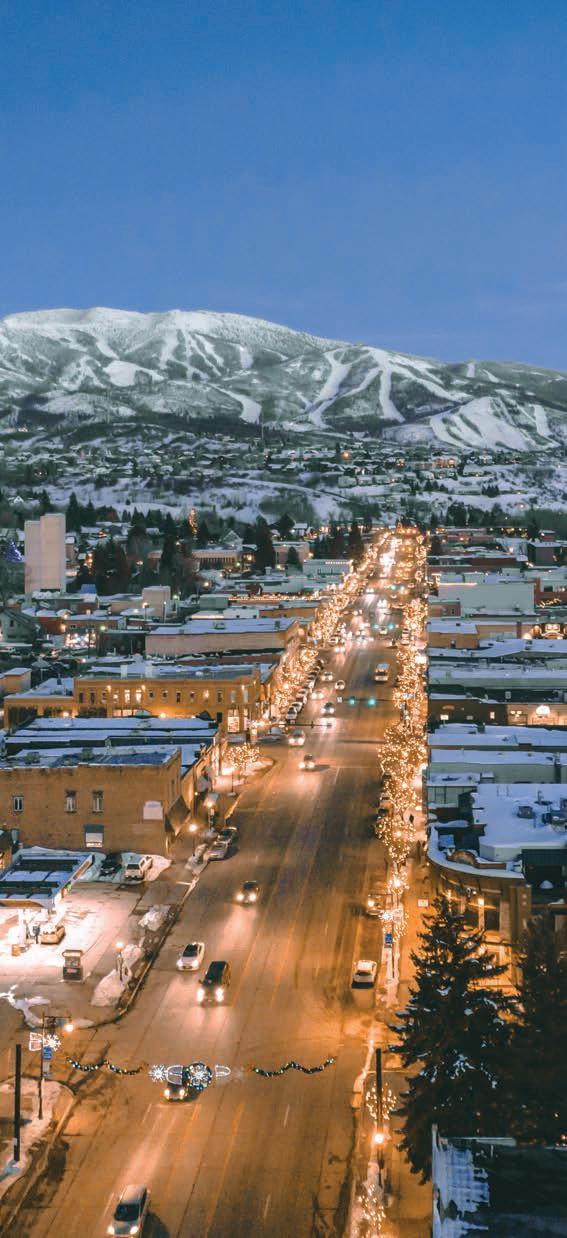



With a combined 48 years of real estate excellence, Labor Long Team brings together the wisdom of legacy and the drive of fresh perspective.
Doug Labor has been a cornerstone in the Steamboat Springs real estate world, known for navigating complex transactions with ease, cultivating lasting client relationships, and offering unmatched knowledge of the Steamboat Springs market. With 42 years of experience, Doug brings a level of insight, negotiation skill, and calm under pressure that only time can teach.
Alex Long brings 6 years of fire, focus, and innovation to the team—leveraging cutting-edge marketing strategies, and a sharp eye for market trends. As a newer face in the industry, he offers relentless energy, love for Steamboat, and a passion for delivering exceptional client experiences.
Together, this dynamic team blends trusted expertise with forward-thinking strategy to deliver results at the highest level. Whether you’re buying a luxury mountain estate, selling a second home, or investing in Steamboat’s booming real estate scene, The Labor Long Team ensures you’re not just represented— you’re elevated.





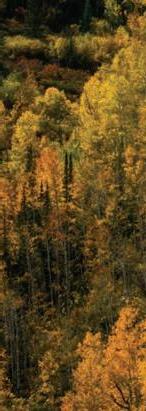
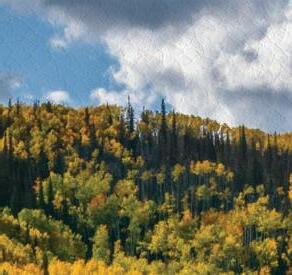



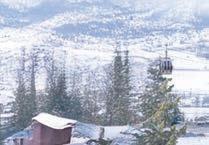
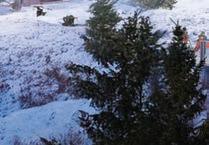

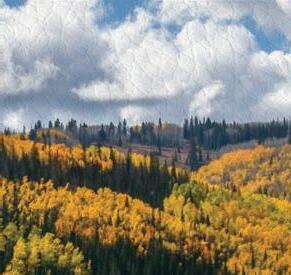



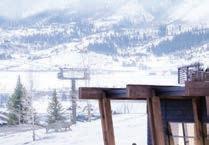

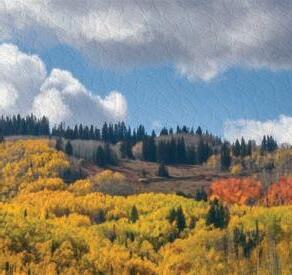



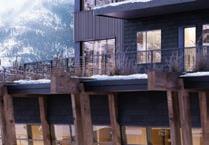
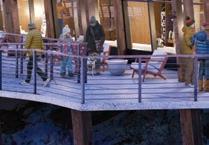



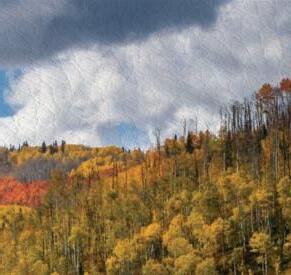




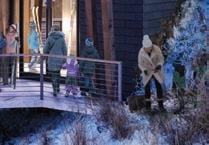


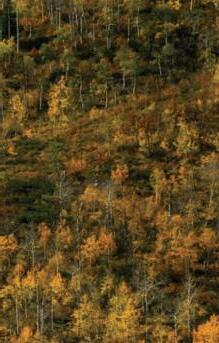
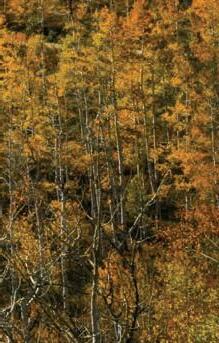





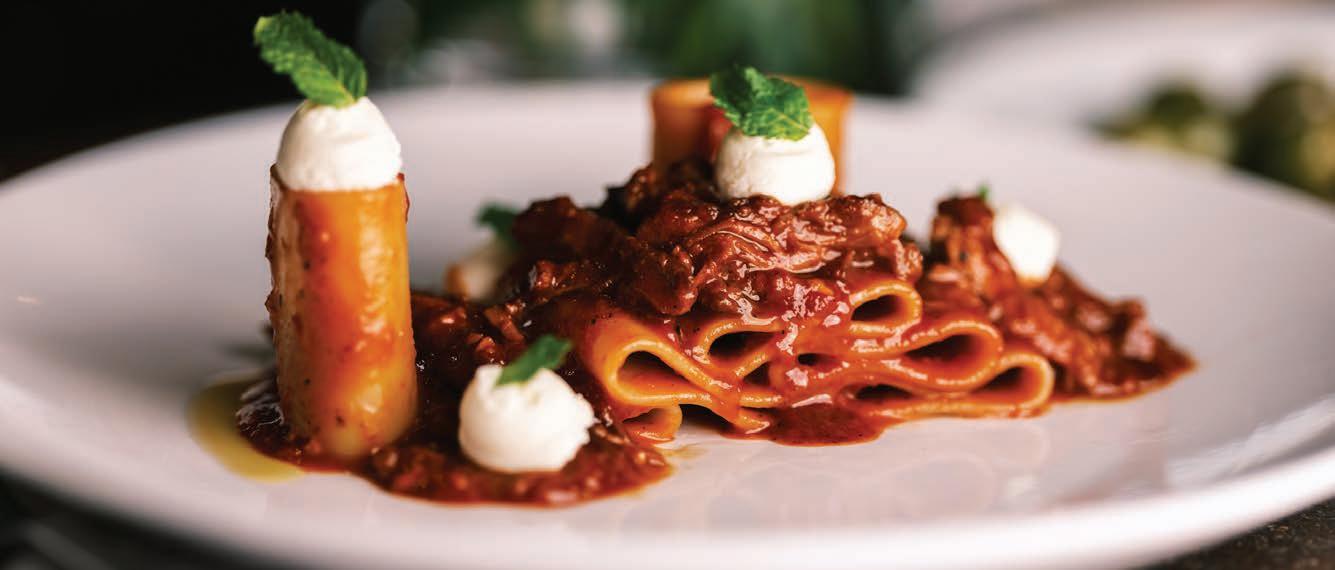


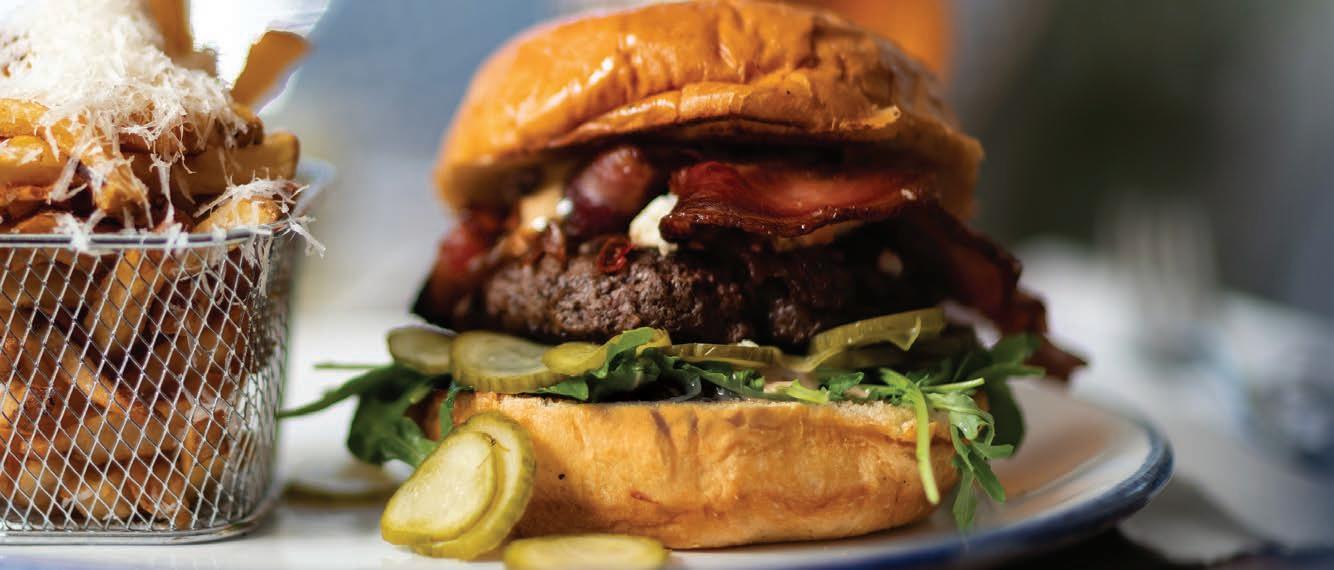





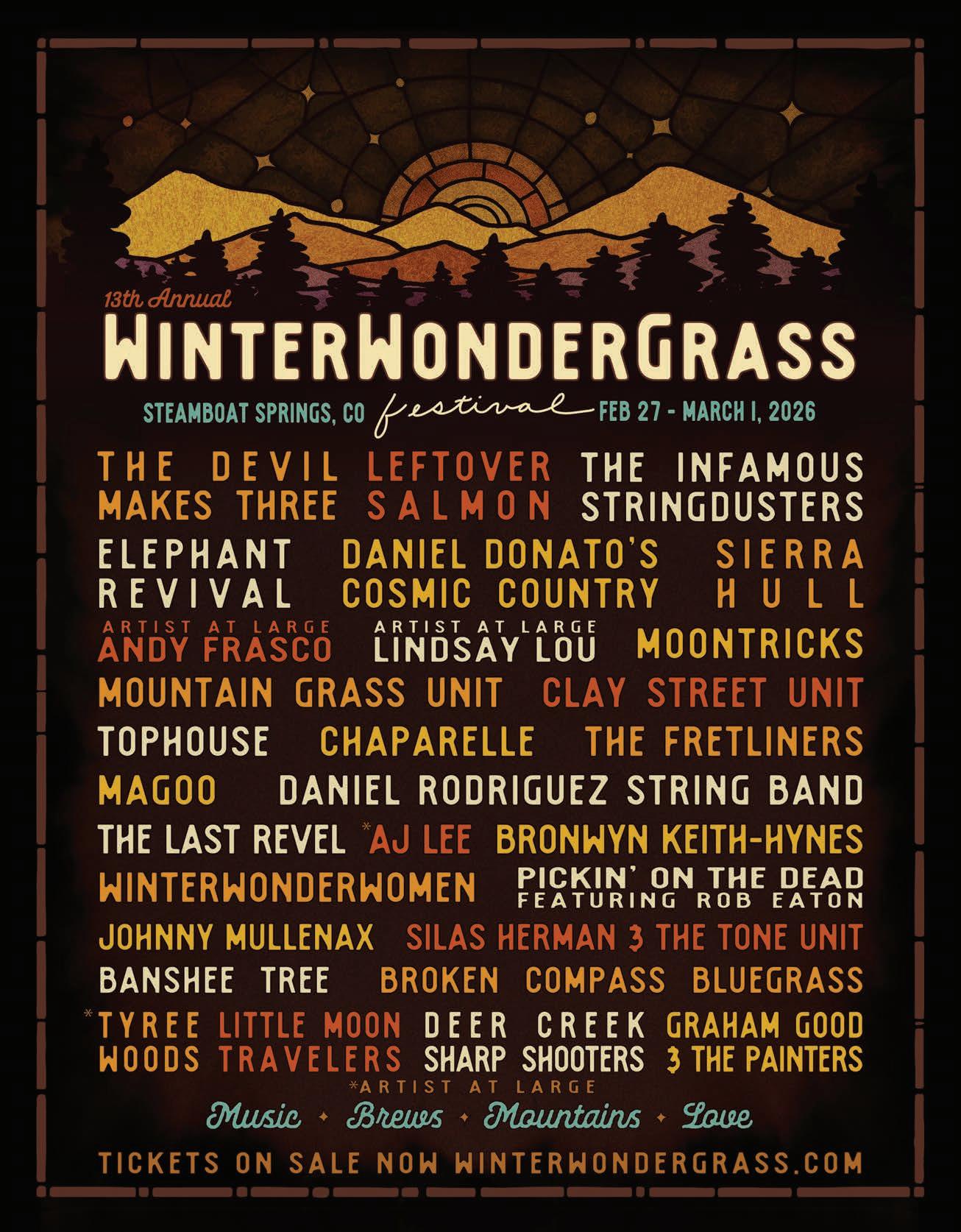
STEAMBOAT’S PREMIER COMMUNITY FOR QUALITY, LOCATION, AND VIEWS

Exquisite Mountain Contemporary Homes | 4,000–12,500 SF
Five Minutes to Private Ski-In/Ski-Out Club
Groomed Cross-Country & Snowshoeing Trails 900 Acres of Preserved Open Space
Breathtaking, Unrivaled Views

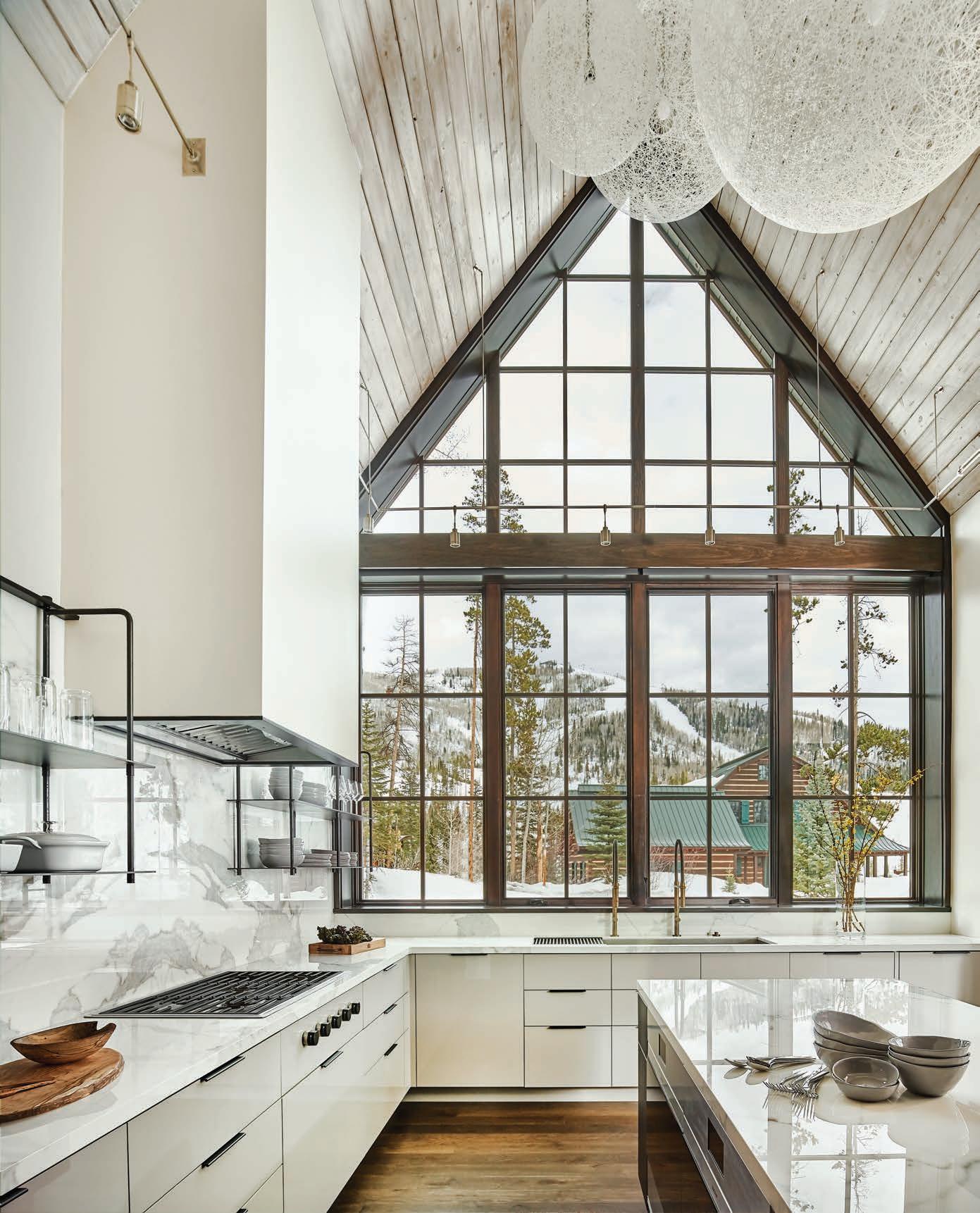

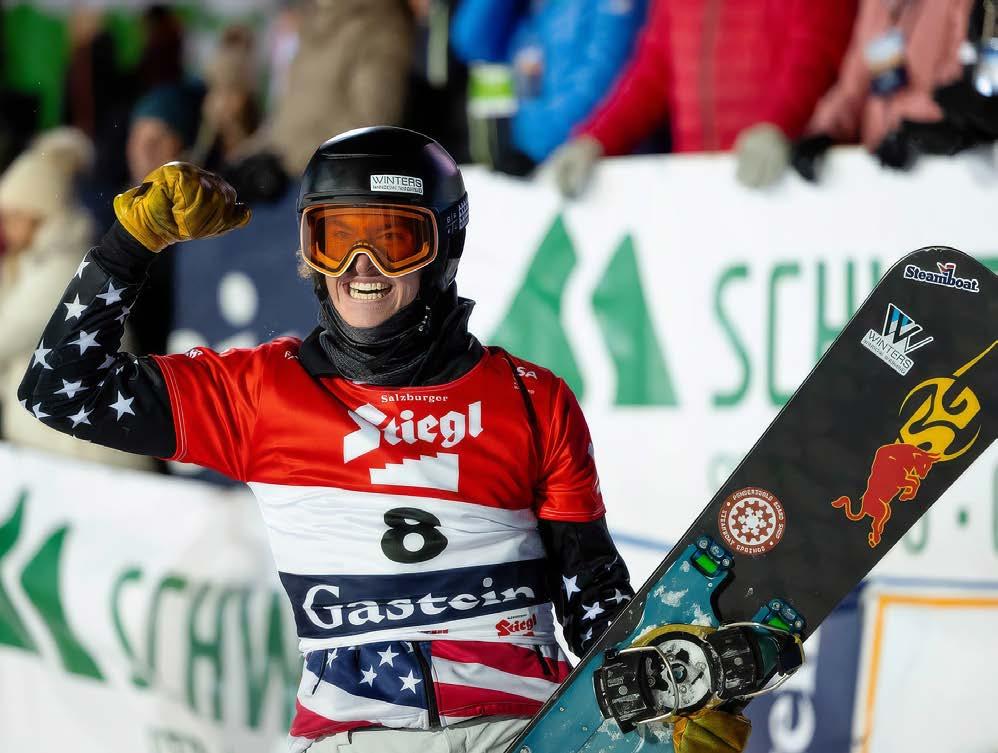
Cody Winters celebrates a podium finish in Austria. The Steamboat snowboarder was recently named to the U.S. Pro Snowboard Cross Team. Follow Cody and other Steamboat athletes in their pursuit of Olympic dreams on page 50. | Courtsey of Cody Winters
The Steamboat Springs athletes who are hoping for a shot at the 2026 Winter Olympics. - by Sophie Dingle, Skylar Leeson and Haley Watkins

Learn from Native Stories
by
Two-time 17-Across – by Victor Fleming
80 Why Stop at the Last Page? The last page is only the beginning: continue the journey with Ski Town Media’s online offerings
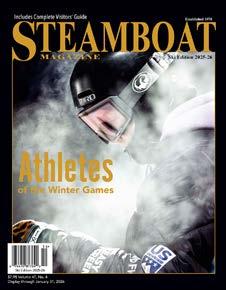
About the cover: Maddy Schaffrick pauses on the halfpipe deck before her drop-in at the
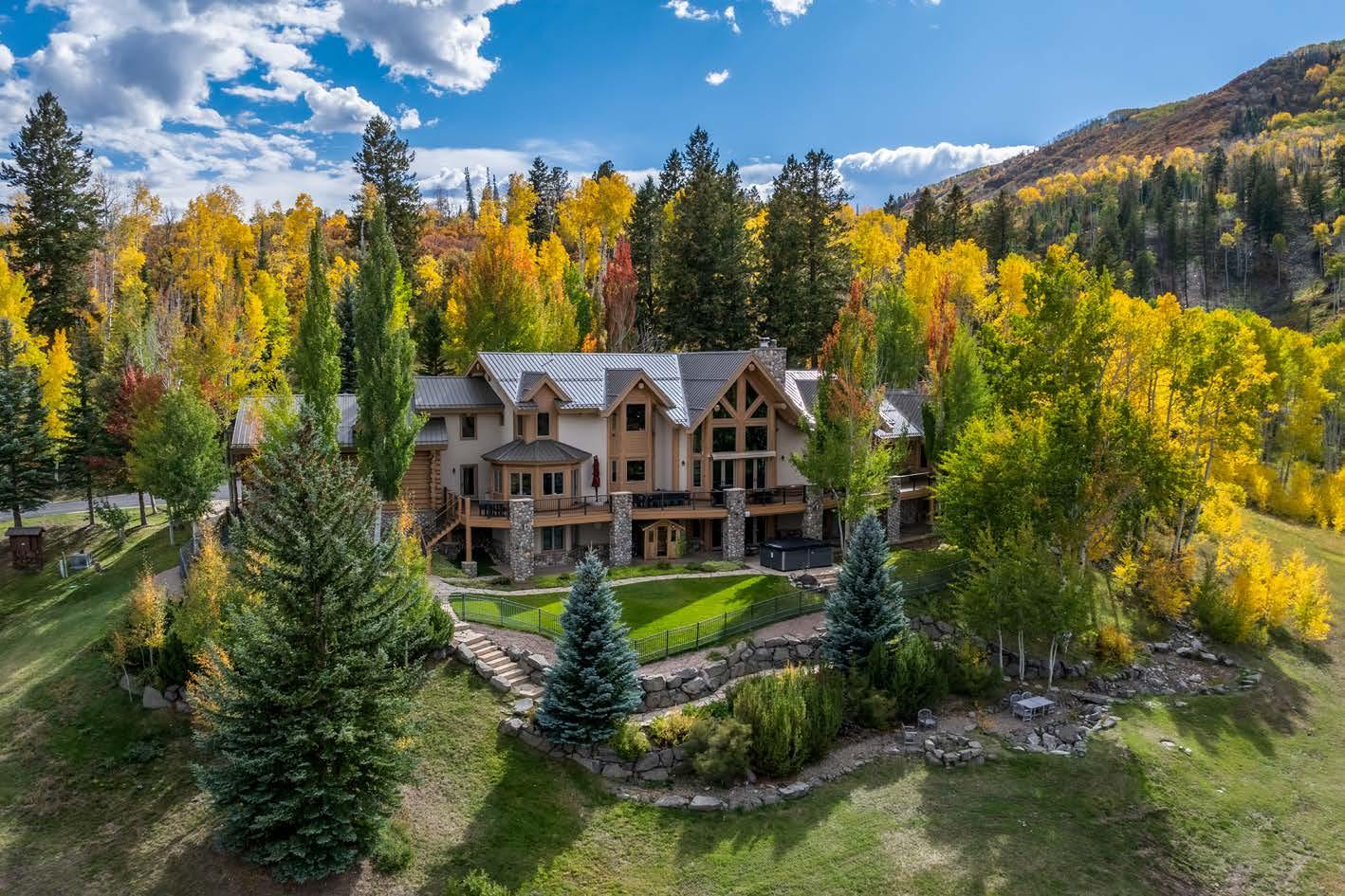



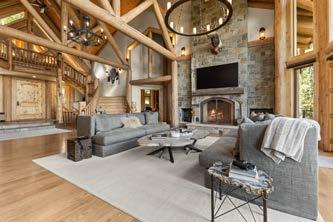


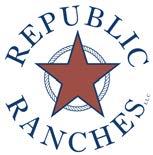
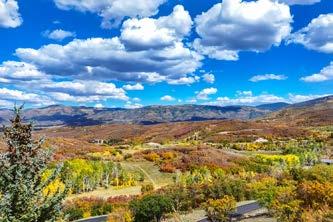



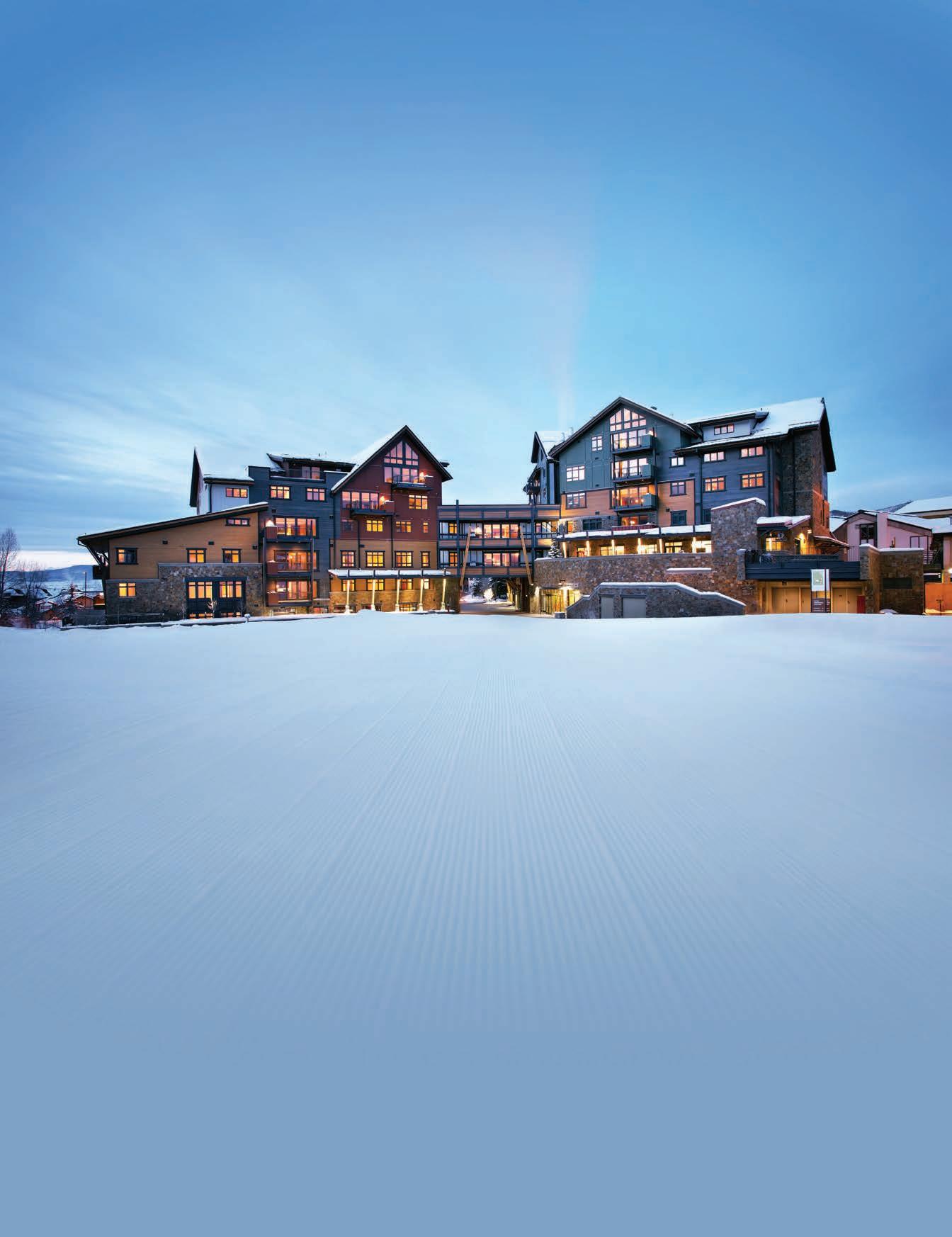

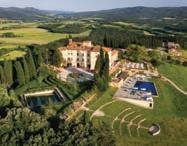








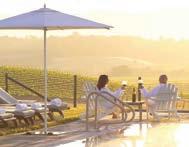



$4,850,000
This beautifully remodeled residence is located on the ground level and is steps away from the family game room and Little Tykes room with easy access to the gondolas and Base Area.

$5,450,000
This spacious residence features a custombuilt bunk room perfect for guests or family, a generously sized laundry room, and three additional bedroom
$6,150,000
New kitchen, appliances, bathrooms, flooring & furnishings, fresh paint, & thoughtfully curated artwork, it offers a stylish and welcoming retreat. A must see!

$5.200,000
The residence offers panoramic views of the valley and mountains. Its extended long deck provides ample space for outdoor lounging and entertaining under the open sky.
Located slopeside at the gondolas, One Steamboat Place offers five-star amenities including, but not limited to, a private spa, members-only locker room, exclusive ski shop, fitness center, motion studio, Gathering Room, and family game room.





SKI 2025-26 – Volume 47, Number 4
PUBLISHER
Deborah Olsen
EDITOR-IN-CHIEF
Sophie Dingle
SALES AND MARKETING DIRECTOR
John Sherwood
ART DIRECTOR
Melissa VanArsdale
MEDIA EDITOR
Jennie Lay
DIGITAL DIRECTOR
Kenny McCarthy
STAFF WRITER
Skylar Leeson
CONTRIBUTORS
Eugene Buchanan
Kaiti Kinshella
Suzi Mitchell
Jack O’Brien
Haley Watkins
PHOTOGRAPHERS
Jeff Hall
Paula Jo Jaconetta
Nick Lyons
Cyndi Marlowe
Julie McNally
Noah Wetzel


Steamboat Magazine is published by Ski Town Media, Inc. The Mountain 2026 edition will be published in Feburary 2026. For advertising rates and subscription information contact info@SkiTownMedia.com. Steamboat Magazine, P.O. Box 770456, Steamboat Springs, CO 80477. Phone: 970-871-9413.
Subscribe: www.SteamboatMagazine.com
Single copy mailed first-class $9.50. No portion of the contents of this publication may be reproduced in any manner without the written permission of the publisher. © 2026 Ski Town Media, Inc. All rights reserved – ISSN 2164-4055.
















TOP 100 AGENTS & TEAMS WORLDWIDE SOTHEBY’S REALTY
TOP TEAM IN STEAMBOAT SPRINGS
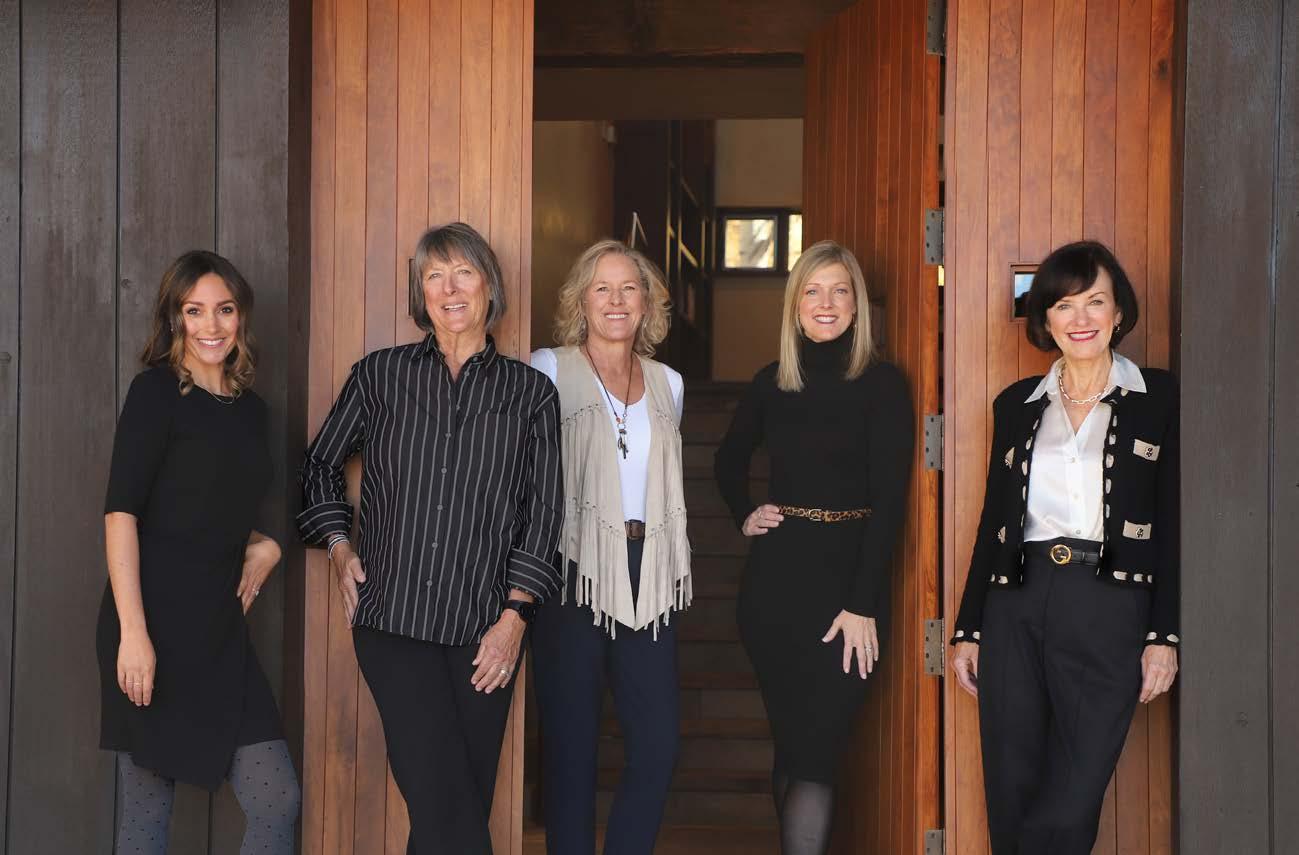



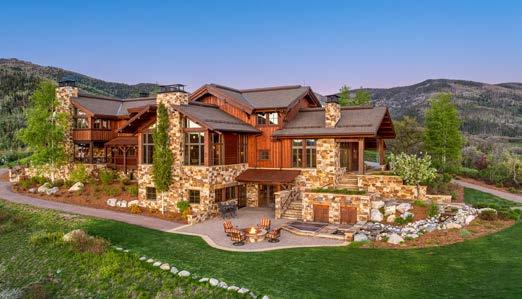



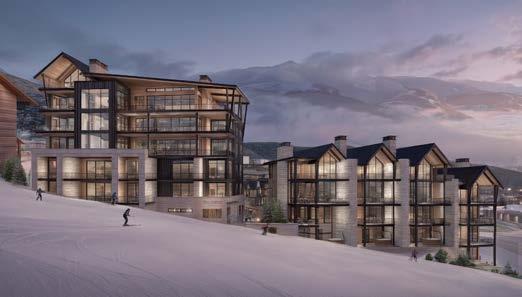

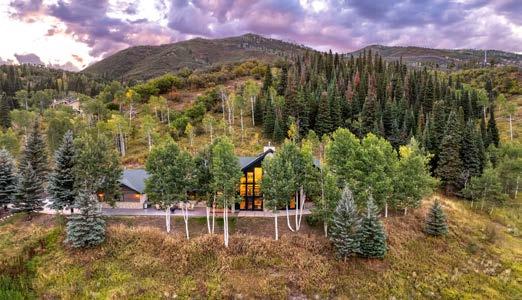


Katie Brown
Steamboat Resort
Rory Clow
Western Centers, Inc.
Samantha Coyne Donnel
Steamboat Mountain School
Jennifer Grathwohl
Grathwohl Creative
Paulina Johnson
Copper Case Paper Art Studio
Collin Kelley Primrose
Brian Krill
Steamboat Springs
Winter Sports Club
Mike Lane City of Steamboat Springs
Valery and Mike Lozano
Warhorse Ranch
Larry Mashaw
The Resort Group
Lindsey Reznicek
UCHealth Yampa Valley Medical Center
Ray Selbe
Selbe Farms
Susan Stempel
The Stempel Group
Kent Vertrees
Steamboat Powdercats
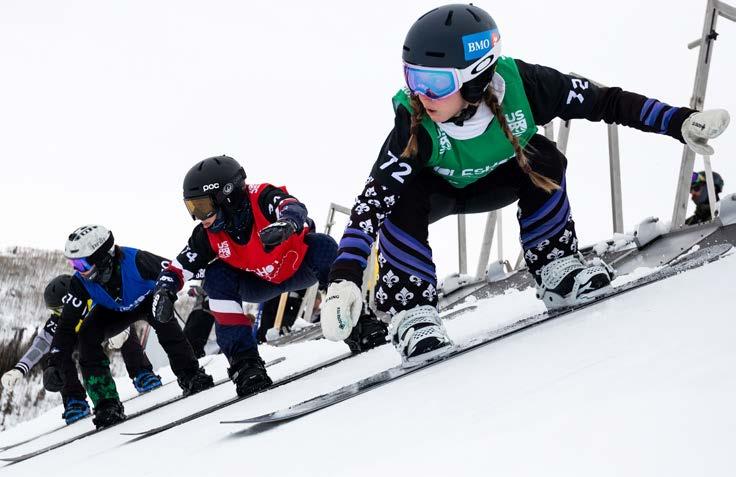
Whenthe drum begins to beat and the trumpets take up the charge of the Olympic Fanfare, the excitement in Steamboat Springs becomes palpable.
That will be the case this February, when Italy hosts the Olympic Winter Games Milano Cortina 2026, followed closely by the Paralympic Winter Games in March.
The reason Steamboat’s official moniker is Ski Town USA becomes profoundly evident throughout an Olympic year. The city, and more specifically the Steamboat Springs Winter Sports Club, has produced more than 100 Olympians in a century-old tradition that began with ski jumper John Steele at the 1932 Games.
In this Olympic-crazed community, even the total number of Steamboat Olympians is up for debate. For instance, although Billy Kidd is Ski Town USA’s most famous ambassador, he was a Vermont-based skier at the time he won a silver medal in the 1964 Olympics and so, arguably, is not a Steamboat Olympian. Another example might be Jorge Torruella, once dubbed “Steamboat’s Unknown Olympian.” A backcountry ski guide and ski instructor, he represented his native Puerto Rico in the 1988 and 1992 Games.
Ski Town Media’s policy is to be as inclusive as possible when it comes to recognizing Steamboat Olympians. After all, what greater honor could there be for athletes than to walk into the opening ceremony behind the flag of their country? We adopted the same attitude when we were compiling this Olympic Edition.
While we won’t know until shortly before the Games begin which Steamboat athletes will qualify for Cortina, it’s a safe wager that the town will be well-represented. The staff of Ski Town Media has spent the last several months placing our bets. We’ve reached out to the Steamboat Ski & Resort Corp., the Winter Sports Club, the Tread of Pioneers Museum and Steamboat Mountain School – we’ve done our research.
Still, upsets, long shots and dark horses are part of the thrill of the Olympics. As much as we have tried to include all the local athletes who have the potential of competing in Cortina, we apologize in advance for those we might have missed. We will be heartsick that we overlooked you, but we will be so very proud of your achievement.
Most probably, not all of the athletes in this edition will go to the ’26 Olympics, but we still think readers will love to meet them. We certainly did!
Enjoy,
















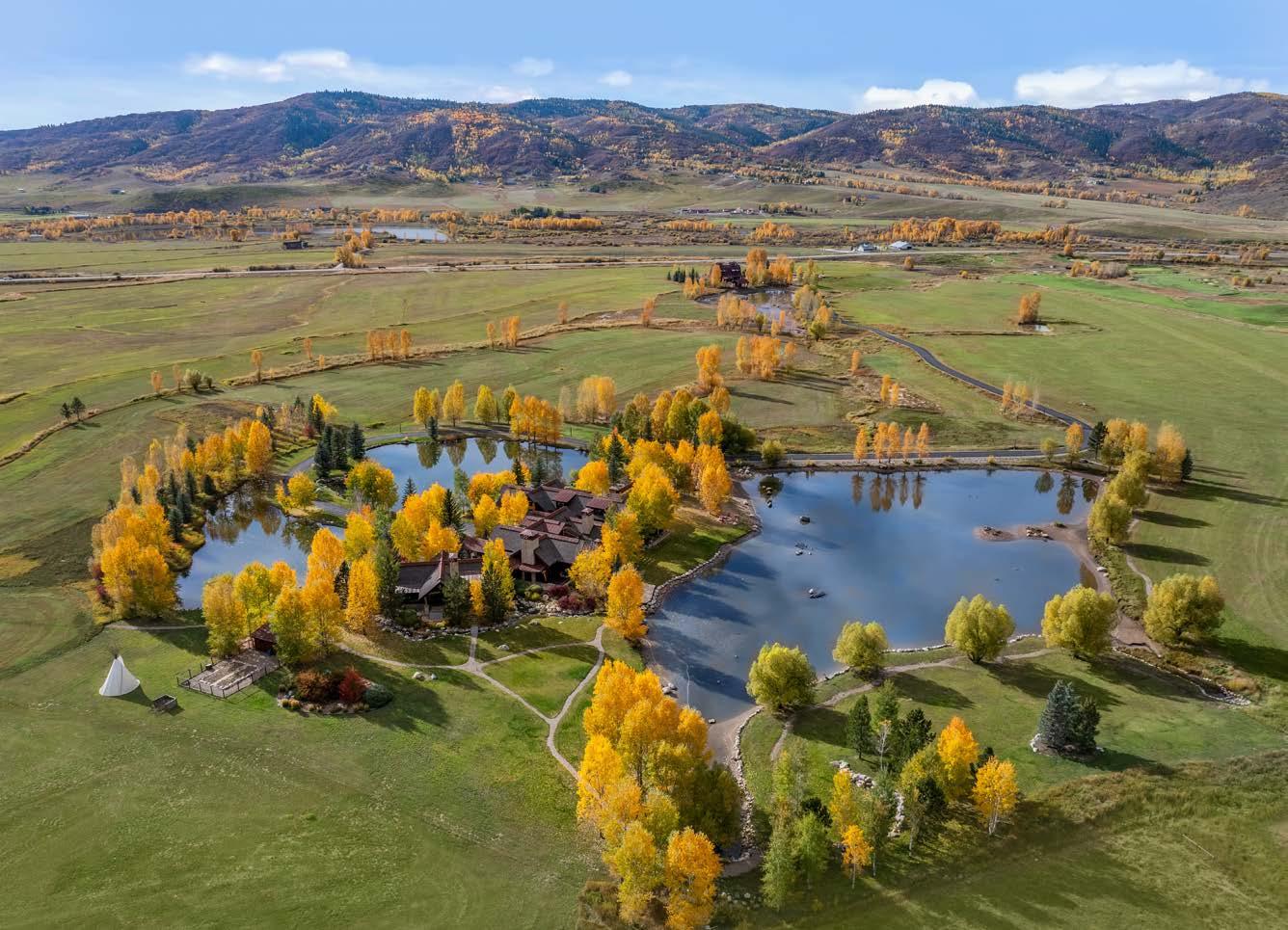
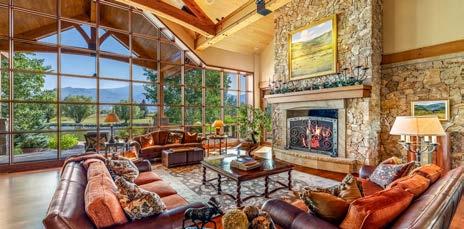
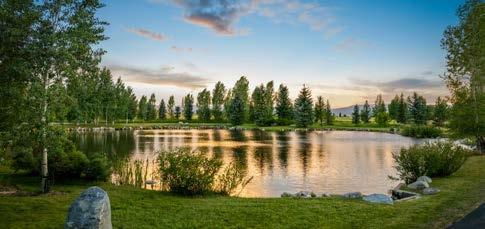
$16,675,000 #S1061376

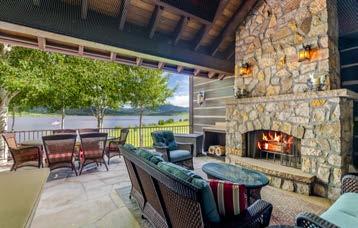

A scenic 35.5-acre property featuring live water and ponds, along with an adjacent 120+ acre conservation easement. Stunning in every way, this multi-generational home is both luxurious and tranquil in an unparalleled setting. Cathedral ceilings, custom woodwork and open concept, this home stands out as the South Valley’s premier estate, conveniently close to ski area and downtown.
Co-listed with Ren Martyn, Fay Ranches Inc.
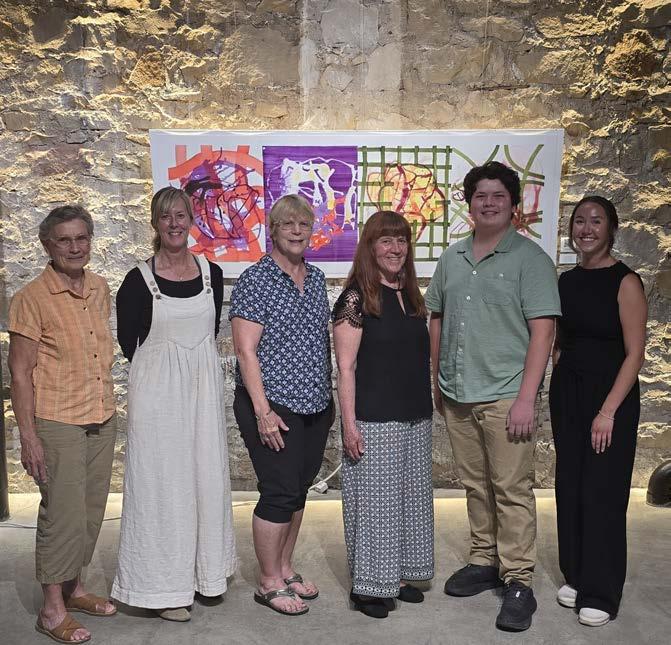
Each year, Ski Town Media sponsors The Painted Word, a writing competition celebrating fine art and the written word, at Steamboat Art Museum. Congratulations to the 2025 winners: Polly Holyoke, Presley Burk and Tesh Feinberg. Find the runners-up and all of the pieces online at www.SteamboatArtMuseum.org.
Dear Sophie,
Thank you for taking time out of your busy life to judge the Painted Words contest for SAM. I know lots of local writers truly look forward to participating in this event. I know I had fun writing for adults instead of for children for a change!
Sincerely,
Polly Holyoke
The Painted Word winners and runners-up: Barbara Sparks, Dagny McKinley, Polly Holyoke, Jean Garland, Tesh Feinberg and Presley Burk.


With over 30 years of experience in the Steamboat Springs real estate market, we are eager to help you fulfill your dream of living in Steamboat Springs, Colorado. Good communication, exceptional service, extensive market knowledge, and a client-focused approach are what set us apart.

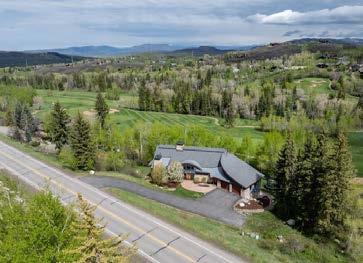


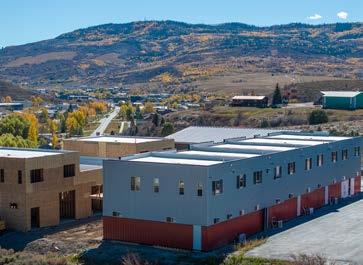


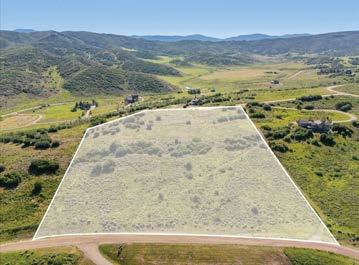
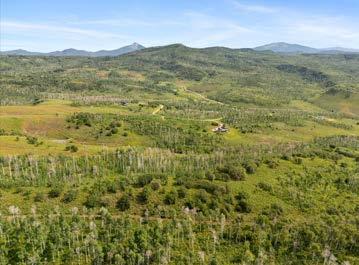

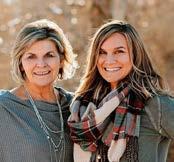



$865,000 | #S1062527 | 2

Beautifully remodeled in Mountain Contemporary style, this quintessential short term rental condo has all the features guests (and you) are looking for: pool, hot tubs, tennis/pickleball, clubhouse, & shuttle.
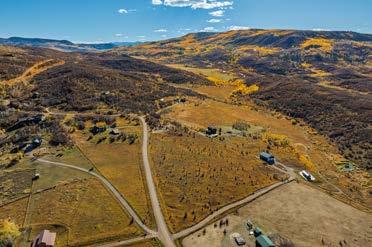

$643,000 | #S1063876 | 7.68 Acres | Private Well

Just 15 minutes from town, you’ll find breathtaking views, privacy, and tranquility. Add a leveled building site, well, and electricity, and you’re well on your way to your dream home. Plus, no covenants!

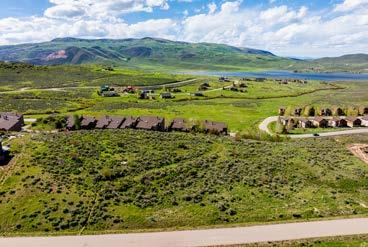
$259,000| #S1057849 | 0.62 Acres | Tap Fees Paid
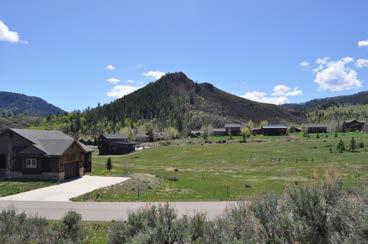
Lot 24 is a premier ridge lot with fabulous views of Stagecoach Reservoir, Woodchuck Hill, Youngs Peak, & Stagecoach Mountain. Easy access year round on paved roads, plus the tap fees are paid!




For this year’s Ski Edition, editor-in-chief
Sophie Dingle, staff writer Skylar Leeson and freelancer Haley Watkins interviewed more than 20 Olympic hopefuls from Steamboat Springs. Along the way, they picked up tips (how to get over jetlag), advice (“enjoy the ride”) and anecdotes from years of dedication, practice and hard work both on and off the snow. Here, they share their favorite takeaways.

One thing that became very apparent in all of the interviews that I conducted was the common advice to “enjoy the journey.” It struck me as such a good reminder, not only in something as monumental as the Olympics, but also in everyday life. It was Maddy Schaffick who said during our interview, “I’m way more focused on the journey rather than the outcome. I’m looking forward to enjoying the experience and finding the joy in being a professional snowboarder. It’s a choice to feel joy or find joy in the grind of it all.” It’s a choice to find joy! I couldn’t get over that – mind blown!
I sat across from Annika Belshaw as she smiled and said, “I wish I’d enjoyed it more.” That moment stuck with me.

Interviewing these athletes, I expected to hear about victory and discipline, but instead, I heard about presence, balance and what it means to truly savor the journey. Their reflections made me think about my own drive and reminded me that ambition means more when it’s paired with gratitude.
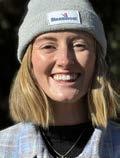
What stood out to me while speaking with these athletes was their dedication to both the mental and physical training it takes to succeed. As ski jumper Decker Dean shared, “I practice a lot of breathwork and meditation daily, which helps me lock in and stay calm during events.” It’s easy to forget the amount of pressure athletes face, and it’s inspiring to see so many young competitors prioritizing their mental as well as physical well-being as they prepare for the Games.







| PHOTOGRAPH BY NOAH WETZEL
Noah Wetzel captured this photograph at twilight during a mid-September evening while he was camping at Fish Creek Reservoir on top of Buffalo Pass. “I was pursuing a unique shot below the dam, and spent a couple days camped at the reservoir,” Noah says. “Anytime I’m surprised with a waxing-crescent moon, I’m filled with joy. This moon appears on the western horizon after sunset, typically in a gradient of sunset hues from orange to blue with the crystal clear black sky overhead. I love being able to see the whole outline of the moon – to me it’s special. Anytime this moon makes an appearance, it’s always a surprise as it follows a new moon. I call this moon the ‘owl moon,’ because oftentimes, I’ve experienced these moments while shooting alone. I think to myself, ‘this moment is so perfect and this scene is so aesthetic; I can’t believe I’m the only person witnessing this where I am right now.’ That’s typically right when I hear the soft coo of an owl.”


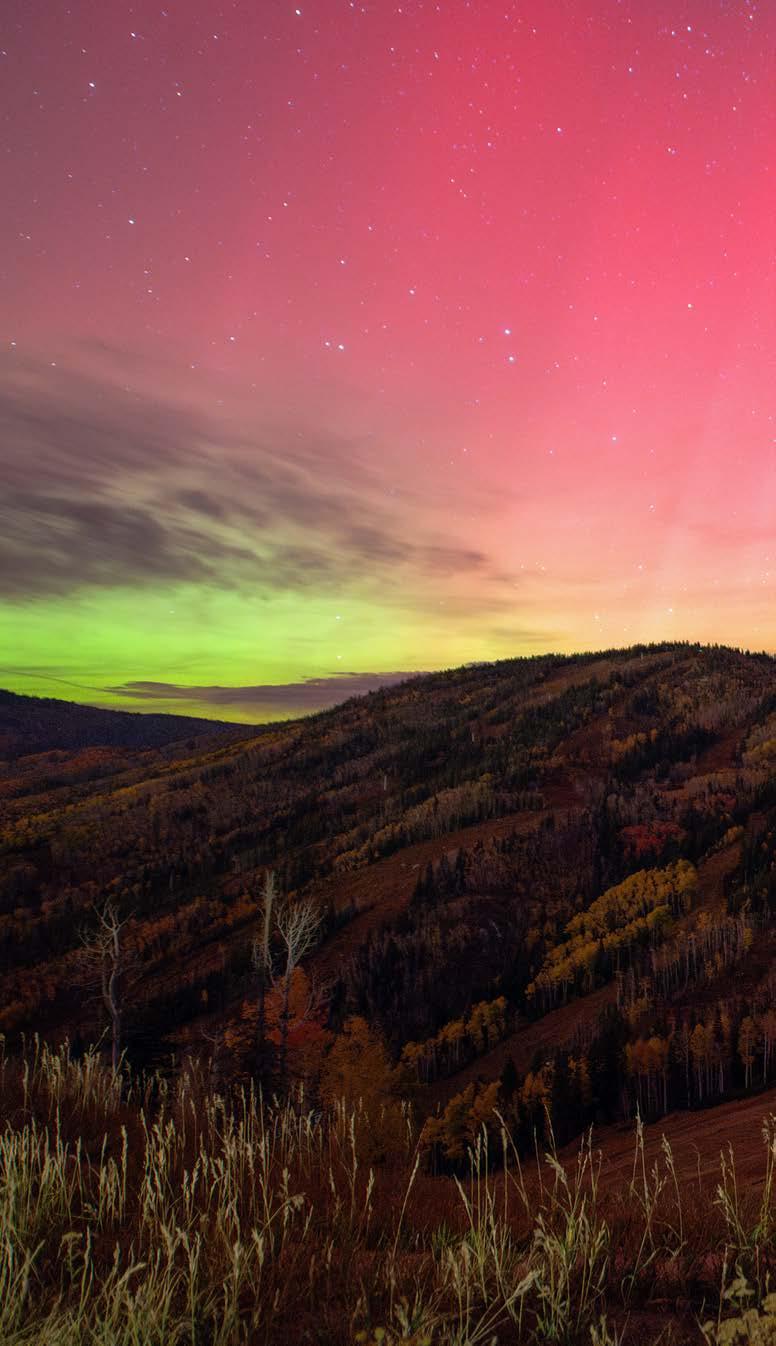
JULIE MCNALLY
This photo was Julie’s second attempt at photographing the Northern Lights, and it proved to be a last-minute mission with many details up in the air. Forecasts suggested a strong chance for Northern Lights visibility, but the cloud cover forecast was less favorable. “There was a 50% chance of cloudy skies, but I decided to go anyway,” Julie says. “Initially, the aurora was faintly visible, hidden behind the clouds. Around midnight, the moon set and the skies began to clear. I captured this image at 1:40 a.m. These striking pillars of light were visible to the naked eye, dancing around the sky until gradually fading about an hour later. The colors on display in the sky that night beautifully complemented the vibrant fall foliage on Mount Werner.”
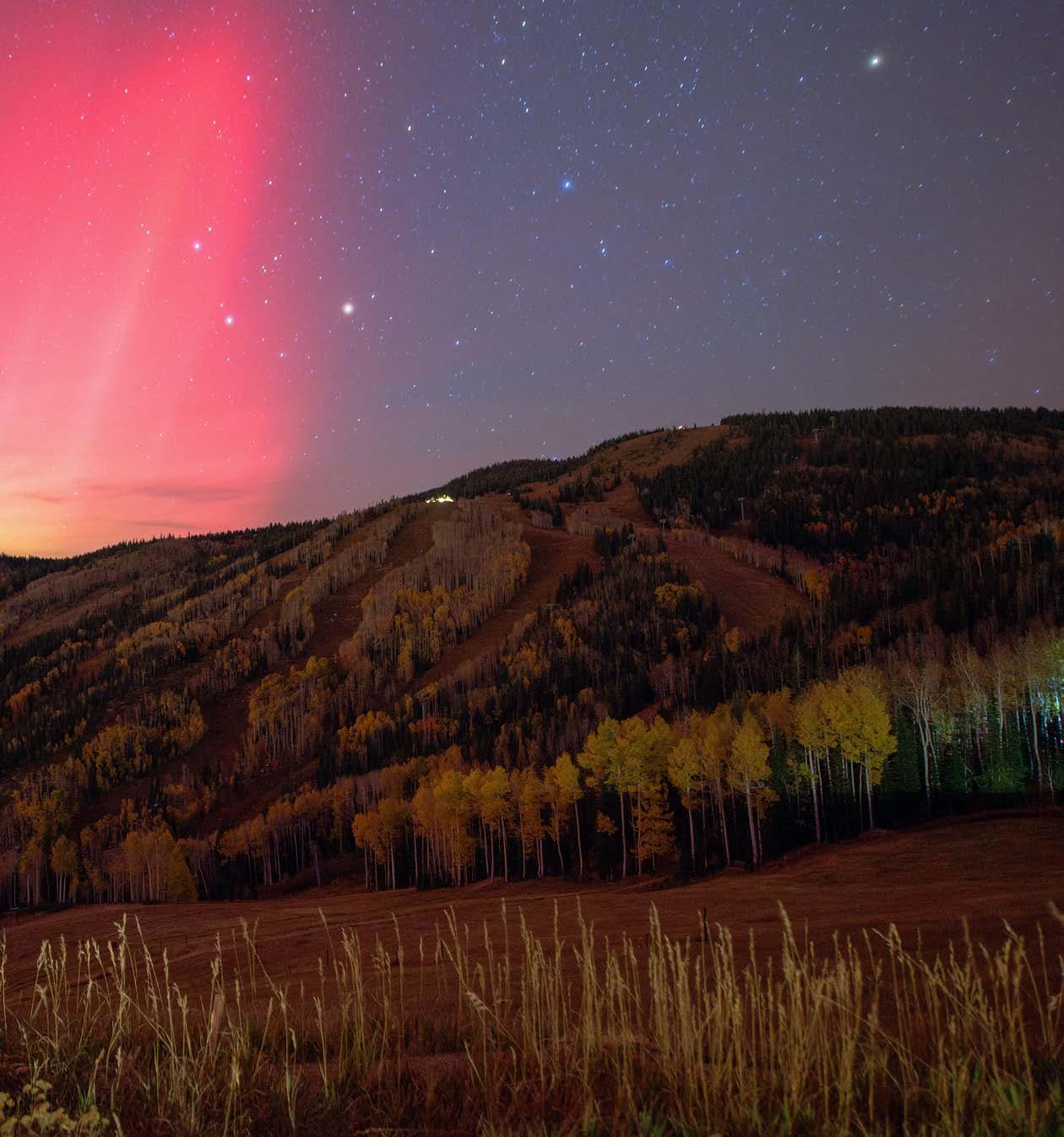
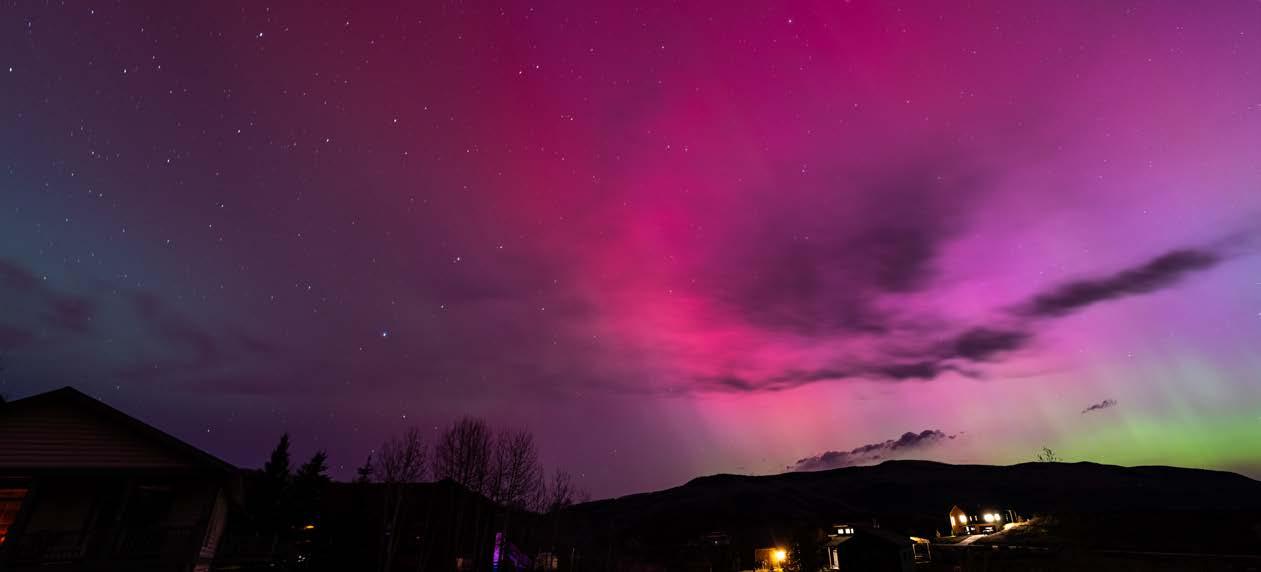
LYONS
Nick Lyons, of Merakai Mountain Media, took this photo in May 2024 when aurora activity started to become prevalent in Routt County. This was one of his first forays into astrophotography. “Seeing the lights firsthand really pushed me to get out there and try it,” Nick says. “It’s been a fun journey, and I’m glad I dove in.”
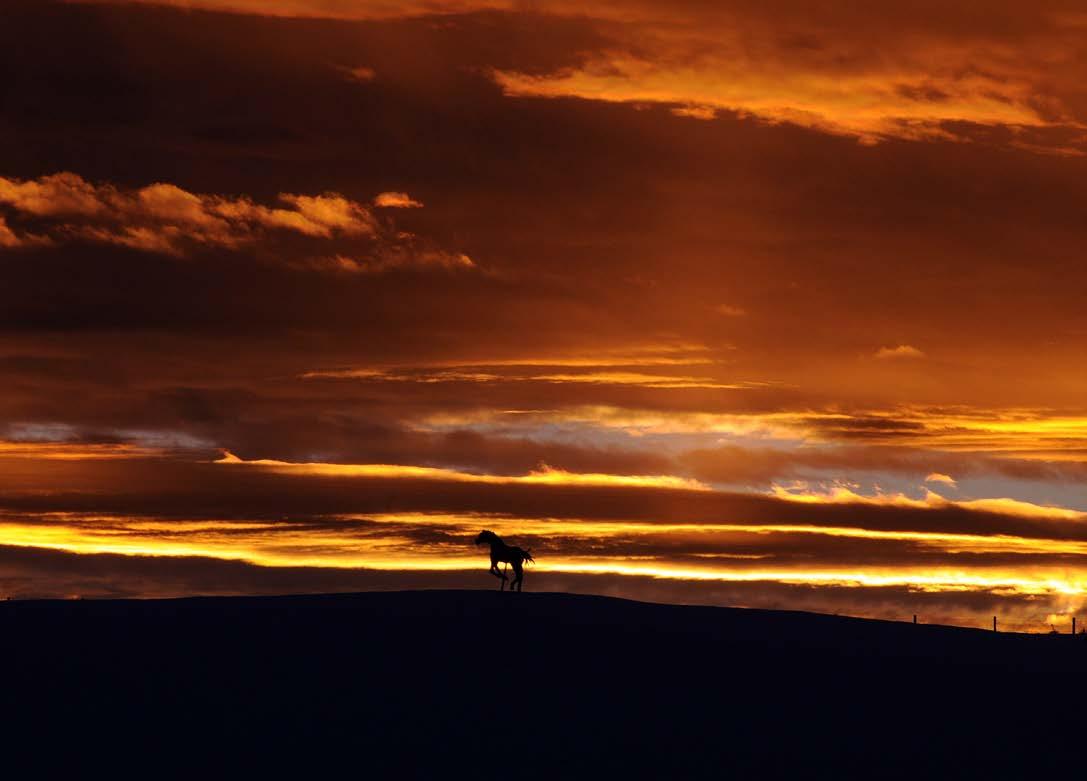
Local photographer Jeff Hall was taking a drive down Twentymile Road one winter evening looking for sunset shots. “I saw this horse sculpture in a rancher’s field and thought it added some intrigue to this beautiful sunset,” he says. “I later found out that this sculpture was made using drift wood.”

“Handsome in Pink” was taken along County Road 42 in mid-January. The photographer, Cyndi Marlowe, has been shooting sunsets in Steamboat Springs for over 40 years. Her long career has taught her that there are certain atmospheric hues in the sky associated with each season. “The contrast of the earth covered in a cold white and the sky ablaze in warm pinks is my signal to mid-winter,” Cyndi says. “The temperature drops as the sun sets and the sky provides some additional moments of warmth.”

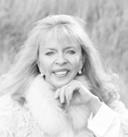






STRAWBERRY HIGHLANDS ESTATE
$9,950,000 #S1059873
6 BD, 9,024 SF luxury estate on 18.5 acres in Strawberry Park with trails, barn, pond, gym, views & privacy. Only 2 miles from downtown.
TAYLOR ASHBY 970.846.9888

LAKE CATAMOUNT’S ”BIG VIEW”
$4,095,000 #S1057569
35+ ac behind the gate with stunning views of the lake, Sarvis Creek & South Valley. Borders National Forest with water & electricity to lot.
CHLOE LAWRENCE 970.819.2150

TURN-KEY DOWNTOWN INCOME
$2,349,000 #S1062607
Exceptional income potential with a grandfathered STR license and high performing ADU. Live in one, rent the other... or both.
RYAN COX 970.819.5359
STEAMBOATSIR.COM | 970.879.8100
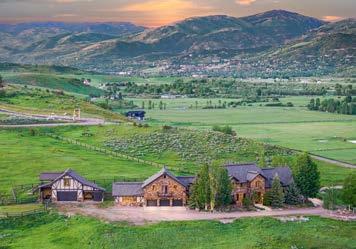
30855EMERALDRIDGE.COM
$7,700,000 #S1059846
A private 35-acre estate with stunning views, 7,904 SF luxury retreat, horse facilities, ponds and more. Only 12 minutes from town.
CAM BOYD 970.846.8100

LUXURIOUS MOUNTAIN LIVING
$3,995,000 #S1056500
Walk to the slopes—4 BD, 5.5 BA custom built home with mtn views, heated 2-car garage, hot tub, AC and impressive short-term rentals.
ADRIENNE STROOCK 970.846.3590
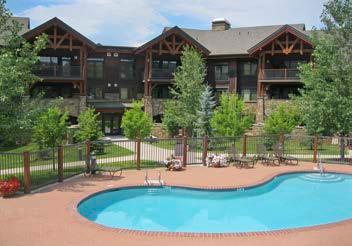
MOUNTAIN LUXURY AT BEAR LODGE
$2,075,000 #S1062350
Luxurious 3 BD, 3 BA condo at Trappeurs Crossing, minutes to ski area, private hot tub, outdoor fireplace & superior resort amenities.
OLSON TOLAN TEAM 970.846.0713

$7,200,000 #S1059915
6 BD, 5.5 BA legacy ski home with 4,000+ SF, ski-in/ski-out access, 2 car garage + carport, slopeside decks and hot tub. STRs allowed. ONE OF A KIND MODERN SKI RETREAT
BARB SHIPLEY 970.846.5151

LUXURY LAKEFRONT CABIN
$3,500,000 #S1063971
Coveted 3 BD + loft, 3.5 BA, exclusive Lake Catamount cabin. Modern renovated kitchen, panoramic lake views and close to recreation.
CHLOE LAWRENCE 970.819.2150
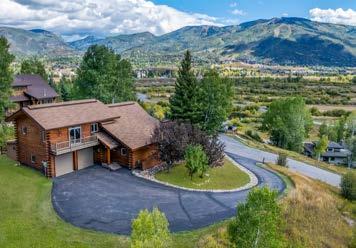
EXCEPTIONAL TREE HAUS CHARM
$1,895,000 #S1062702
Exceptional views from this custom 3 BD, 2.5 BA home. Vaulted ceilings, natural light, mainlevel primary, spacious deck and 2 car garage.
KATHY STEINBERG 970.846.8418
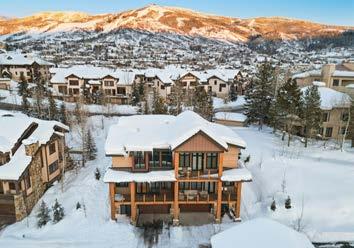

SKI-IN/SKI-OUT AT ONE STMBT PLACE
$4,850,000 #S1055307
Remodeled 4 BD, 4 BA at One Steamboat Place with open layout, office and fireplace. Just steps to the gondola, dining and base area fun.
DAVID BALDINGER JR 970.846.2560

ICONIC LAKE CATAMOUNT LOT 1
$2,950,000 #S1059791
66.98 acres in Lake Catamount. Breathtaking valley views. Well, power, driveway in place leading to a private, exceptional homesite.
KATHY STEINBERG 970.846.8418

CHARMING HOME IN OLD TOWN
$1,775,000 #S1059949
Updated 3 BD, 3 BA in downtown with radiant heat, wood floors, private decks, garage and walkable access to parks, dining and more.
DAVID BALDINGER JR 970.846.2560
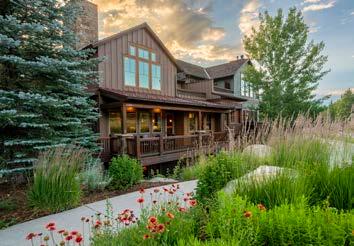
EXQUISITE MOUNTAIN RETREAT
$4,300,000 #S1061598
Luxury 5 BD, 7BA retreat with stunning views and premium clubhouse amenities. Flawlessly cared for with excellent rental potential.
COLLEEN DE JONG 970.846.5569
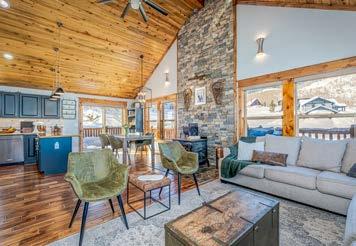
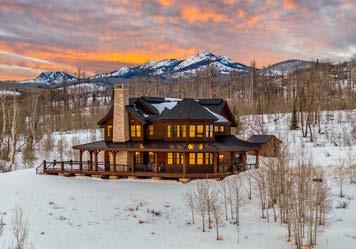
MODERN LUXURY ESTATE
$2,845,250 #S1056078
Discover this 5BD, 5BA, 5,304SF estate on 35AC surrounded by Elk River’s iconic ranch lands. Modern design & breathtaking surroundings.
ANNAMARIE SHUNNY 970.846.7547
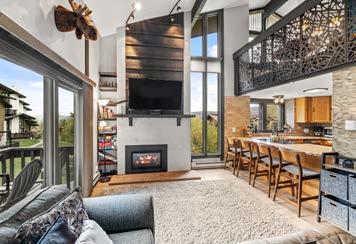
REMODELED HILLSIDER CONDO
$969,900 #S1057588
Bright & airy, 2BD + loft, 2BA renovated mtn condo with vaulted ceilings, modern fireplace, private deck, outdoor pool and hot tub.
CHLOE LAWRENCE 970.819.2150

TIMELESS ELEGANCE ON 7TH – STR
$3,950,000 #S1061657

5BD, 4BA main home+ 1BD, 1BA ADU. Modern upgrades, 5,305SF, 3 car gar, hot tub, gardens. STR permit, walk to school and Old Town.
KATHY STEINBERG 970.846.8418
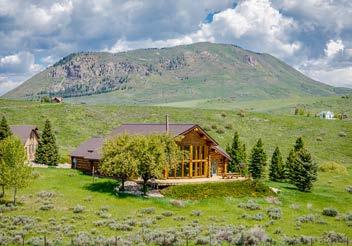
$2,775,000 #S1059358
3 BD, 3,186 SF log masterpiece on 35 acres with commanding views of ski area & surrounding mountains. Bordering conservation land. FAWNCREEKHOME.COM
BEN BEREND 970.819.3730

MOVE-IN READY IN STAGECOACH
$920,000 #S1057634
Only $336/SF. Meticulously cared for inside & out on 0.52 AC. 5 BD, 3 BA with 2 living spaces, main-floor primary & views of Stagecoach Res.
OLSON TOLAN TEAM 970.846.6781
970.879.8100 | STEAMBOATSIR.COM LOCAL ROOTS. GLOBAL REACH.

When Olympic gold medalist Deb Armstrong discovered printmaking, she embraced the parallel in precision and performance from one of speed to one of beauty.
| BY SUZI MITCHELL
Earlyon a summer morning in Steamboat Springs, Olympic gold medalist Deb Armstrong is raring to get to class. The renowned skier has made a life and career as a professional skier and instructor, but for once she is the student and this time she won’t be on skis. Her new passion is art –printmaking to be specific – and like everything she does in life, she’s taken to it with the tenacity of a champion.
“She’s the first to arrive and the last to leave,” says instructor and master printmaker Sue Oehme. “I always tease her because she approaches making art as if she’s on the hill, in the ready position.”

Deb works on a watercolor plate she made for a print based on Grand Canyon basalt.
During Covid, Deb took an interest in printmaking, ordered supplies and set about creating a series of linoleum block prints depicting her three favorite mountains, Mount Rainier, Mount Fuji and the Matterhorn.
“This was a brain exercise for me,” Deb says. “For the first time in a long time, I was back on the green run and looking at something through a different set of goggles.”
After dabbling with the mountain range concept, Deb set her sights on the Northern Lights. She signed up for a class at Anderson Ranch in Snowmass, where she put in about 14 hours a day. “It’s the only time in my life where I had to be somewhere for that length of time and only leave to eat and sleep.”
She recently signed up for another of Sue’s workshops with the end game of holding her first solo show.
“This time around, with four years under my belt, I’m using the lingo, producing content and it feels like I’m skiing new terrain,” she says. “I’m excited to watch my body of work unfold, and every time I see a vision executed on a plate or paper, it’s like executing a perfect run.” Deb’s show is set to open on First Friday ArtWalk in February 2026 at the Depot Art Center in her hometown of Steamboat. “It is pretty incredible as Deb wasn’t an artist in the traditional sense and the show visually merges the two aspects of her life,” Sue says.
Lifesize full-body images of Deb during her athletic career have been desaturated and will function as wallpaper and a backdrop to the display which depicts her creative journey. “It’s been a beautiful thing to witness Deb finding and owning her artist self,” Sue says.
When the doors open in February there will be very few nerves. “Never in my wildest dreams did I think there was an artist in me,” Deb says. “I’m very proud of what I’ve accomplished.” The show will once again put her back in the spotlight and reiterate what those at the top of their game know: practice makes perfect.
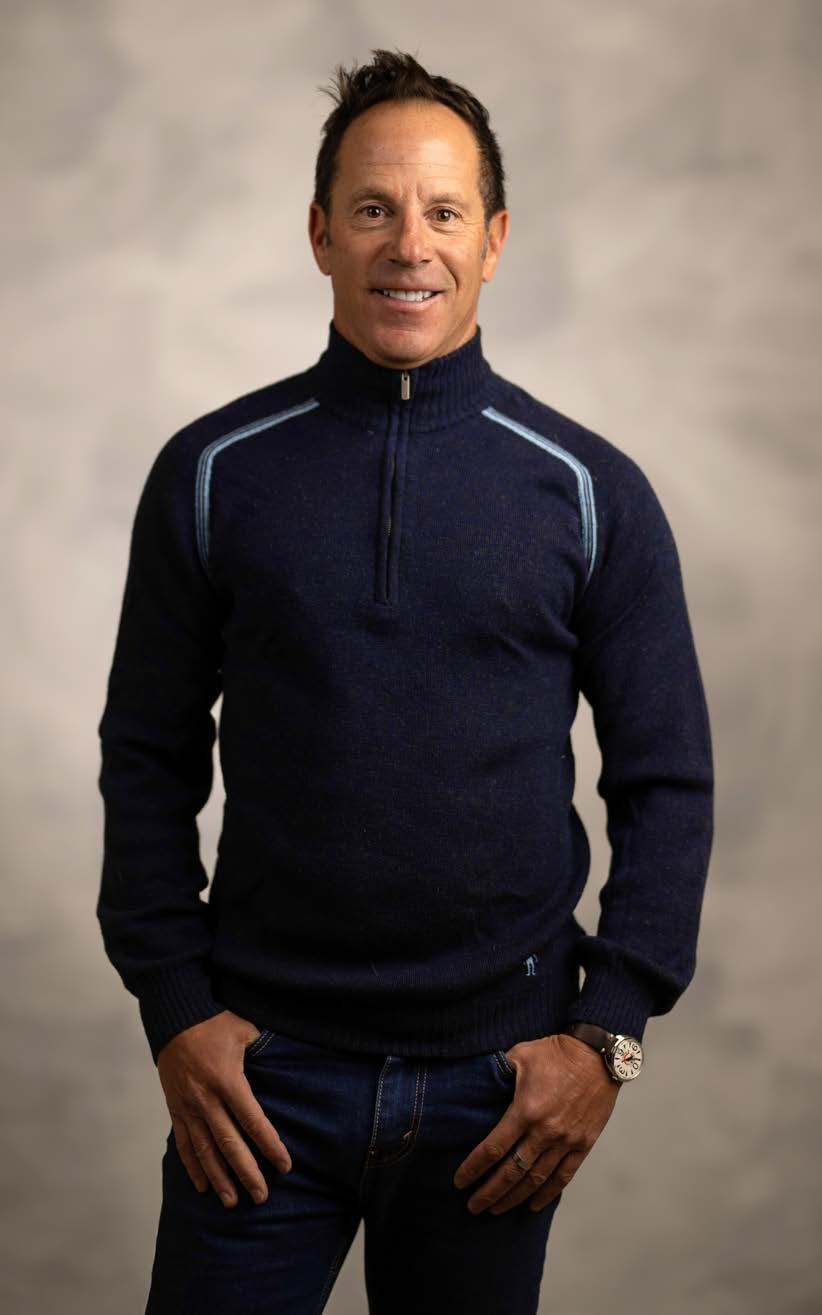







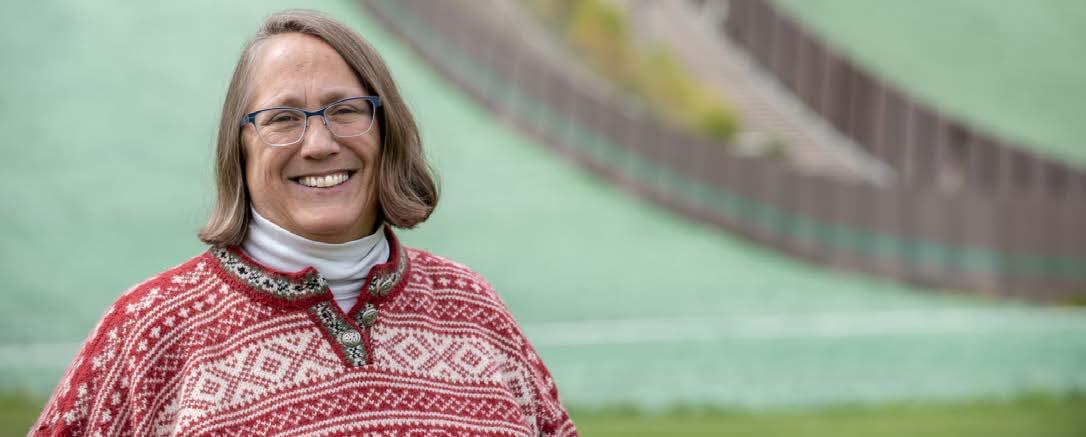
| BY KAITI KINSHELLA
Ifyou see a ski jumper flying through the air on any given snowy Saturday at Howelsen Hill, you can bet volunteer Chris Johnson is nearby, hard at work. As the chief of calculations, Chris collects and processes scoring data for all ski jumping and Nordic combined events. She produces timely and accurate results from a tall watchtower called the crow’s nest. From this vantage point, Chris is able to see all of Howelsen’s happenings; it’s no wonder she calls it “the best view in Steamboat.”
Chris began volunteering for the Steamboat Springs Winter Sports Club 14 years ago, when she and her husband moved to town with their four children. Enrolling them in the club was a given. “One of the great things about living here is the Winter Sports Club, so when we moved here, we signed them right up,” she recalls. With her background in mechanical engineering, she eagerly raised her hand to help with the complicated and quickpaced math behind ski jumping and Nordic combined scoring.
When the previous chief of calculations retired, Chris stepped up to the plate. For years now, she has gathered and interpreted the scoring data, made it comprehensible to those who aren’t as math-minded, and shared the results in one culminating report. The program depends on her numeracy skills and knowledge of the scoring software.
Many parents volunteer their time with SSWSC, but few stick around to help out after their children have left the program. “What separates Chris is that she has continued to give well after her kids have moved on from the club, and that’s outstanding because if you don’t have kids in the club, then it’s just pure volunteerism,” says Todd Wilson, the ski jumping and Nordic combined program director.
Additionally, her deep involvement in the club helps her spot challenges and create solutions that benefit everyone. No Wi-Fi
at an event? No problem – Chris will develop a spreadsheet to enter scores on coaches’ phones. Score cards flying away in the wind? Chris will create a purpose-built clipboard. “I don’t know if we have ever had a challenge that she hasn’t been able to figure out,” Todd says. “She has such a brilliant mind.”
Chris loves being a part of a program that is so special to Steamboat. “It’s such a good thing for our whole town,” she says. “Steamboat wouldn’t be Steamboat if it wasn’t for the Winter Sports Club. It helped form Steamboat as a community when Carl Howelsen started it many years ago.”
Currently, Chris has her own small community in SSWSC calculations that consists of herself and two other women, Christine Russell and Deirdre Mewborn. Both Christine and Deirdre’s children have grown up and are no longer in SSWSC. Yet, like Chris, whose penchant for volunteering is contagious, they continue to selflessly give their time to the club.
This keeps the club running smoothly. With around 65 event days per year, Todd points out that it “takes an army to pull it off.”
The legacy and future of SSWSC are core to the Steamboat community as the club helps local kids form friendships, gain independence and build confidence. “It’s a small organization with a huge impact on the lives of our kids, and they can’t do everything with just the employees they have,” Chris says. “Everybody needs to chip in.” And for Chris, volunteering isn’t just a duty – it’s a joy and an honor.

Editor’s Note: Each edition, the staff of Steamboat Magazine selects one or more locals to showcase as examples of the strong sense of community that keeps Steamboat Springs genuine.



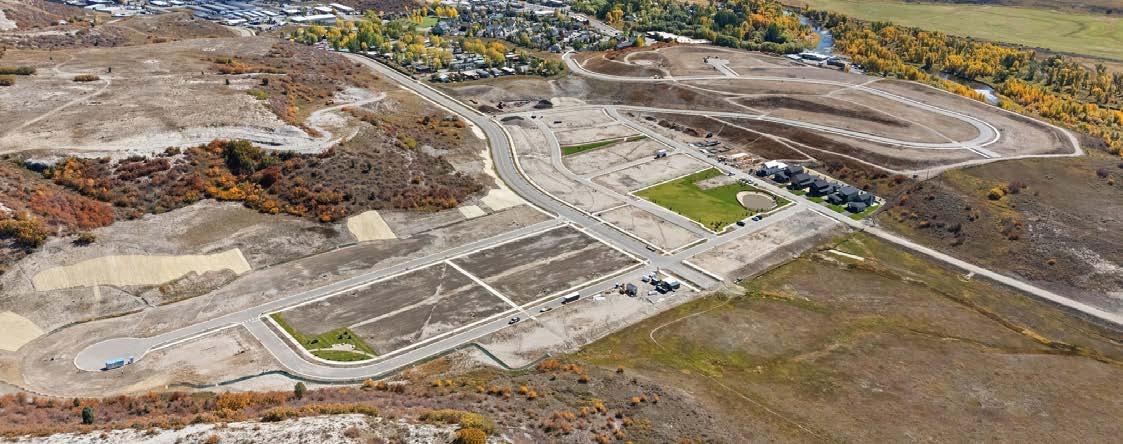



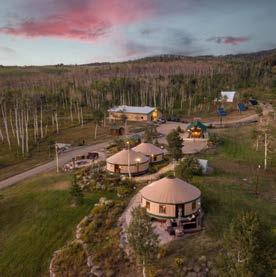
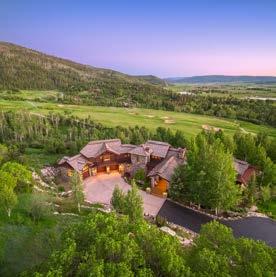


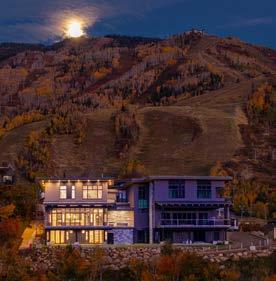




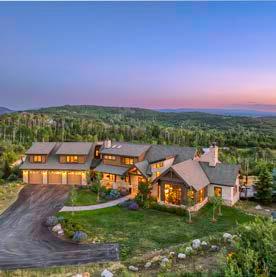
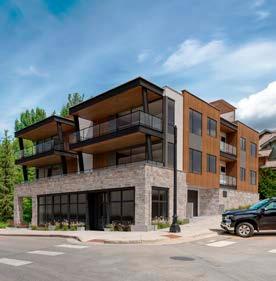
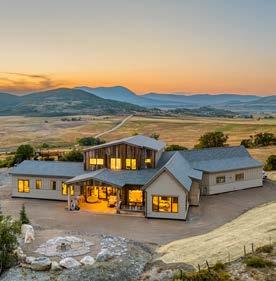




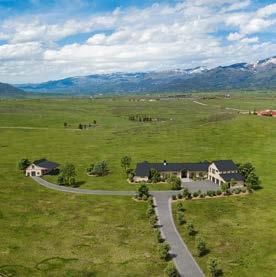

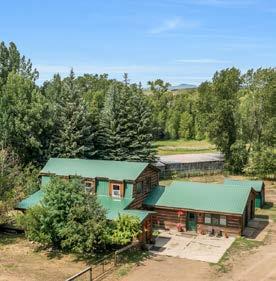


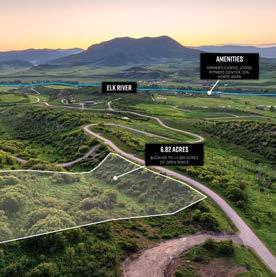


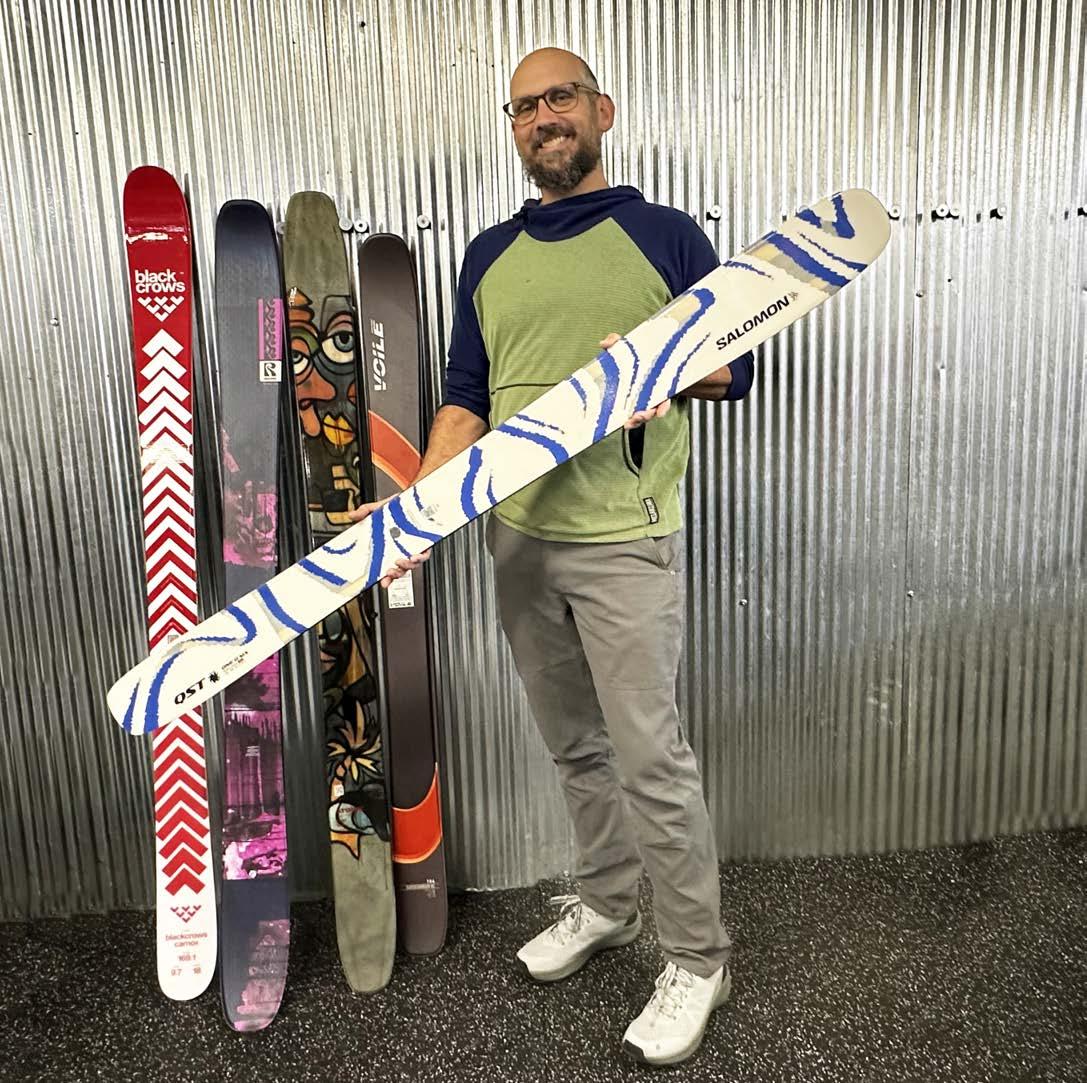
Andrew Stoller, Ski Haus buyer and manager, holds a pair of Salomon QSTs. They are best suited for all-mountain skiers and perform well in a variety of conditions.
A pair of legacy Steamboat ski shops for every skiing need
| BY JACK O’BRIEN
While skiing can be countercultural and earthy, us sliders on snow are hardly ascetics. Because as much as skiing is about freedom, fun and improvisation on snow, it’s also a gear game, requiring skis, boots and bindings. And from the modern-day innovation in the often still heady world of telemark skiing, to the Alpine and Nordic methods, Steamboat’s ski shops brim with the implements us skiers require.
That includes Ski Haus, which has been outfitting Steamboat skiers since the Nixon administration (owner Rod Shrage took over from a previous operation back in 1969). “We try to be pretty consistent with our brand partners,” says Andrew Stoller, Ski Haus buyer and manager. “We carry Alpine gear that has been tried and true for us through the years. That being said, we do try to keep an eye out for anything new and exciting.”
This season, that includes ski boots using BOA’s tension system, including models that now incorporate two dials. Brands using BOA sold at Ski Haus include K2, Nordica, Salomon and Atomic. Andrew also notes that the shop will be carrying two exciting bindings: ATK’s new AT/Alpine hybrid the HY Free, as well as Voile’s TTS Transit telemark binding, the first retail-ready option on the previously DIY two-pin telemark tech system, first created in 2011.
And, Ski Haus, once the leading Scarpa telemark boot dealer the world over, will be carrying its new TX Comp NTN boot this season, a new, stiffer model that follows the release of its revamped TX Pro last season, the first meaningful update to telemark footwear in some fifteen years.
“We did see a noticeable uptick with tele last season with the launch of the TX Pro from Scarpa,” Andrew says. “The boot is considerably lighter than its predecessor and has a way better walk mode.”
Another long-time telemark hub in town is Backdoor Sports, long owned by the late, legendary Pete Van De Carr, who died last year at 70. Steamboat locals Chris and Dominique Welch, along with Chris’ brother, Mike, purchased the shop last spring.
“We are most excited to be carrying on Pete’s legacy at Backdoor Sports,” Mike says. “We hope to keep welcoming the many people that Pete touched from the community and beyond, for many years to come.”
That includes continuing the shop’s tradition as a hub for telemark gear. “Backdoor Sports has become a place for tele skiers, and that’s not changing anytime soon,” Mike says.
This season though, the shop will work to incorporate a wider breadth of options for skiers of other disciplines. “We look forward to continuing with tele gear, growing AT and backcountry gear, and expanding into Alpine, with a good lineup of names you’ll recognize in skis, bindings, boots and accessories.”
Amanda Brotman, a master-level certified bootfitter and long-time local, is managing the shop, anchoring Backdoor’s new focus on skiing footwear. “We are currently building what will be a full service boot fitting shop,” Mike says. “This is a new and exciting angle to add to Backdoor Sports.”
Backdoor Sports will continue to carry a broad array of telemark, snowboard and Alpine brands like Tyrolia and its new hybrid Alpine/AT binding, the Attack 14 Hybrid. Other brands include Scarpa, Black Diamond, as well as Never Summer split boards. And the shop will boast a smattering of local brands.
But Amanda finds the gear to be just part of the whole. “I am privileged to work with many ski professionals; from U.S. ski team members both past and current, Steamboat Springs Winter Sports Club athletes and coaches, Special Olympics athletes, ski patrollers, PSIA pros and everyday enjoyers of snow,” she says.

| BY DEBORAH OLSEN
Freestyle skiing would probably have become an Olympic sport without Steamboat Springs’ coach Park Smalley. But then again, maybe not.
Park is quick to say that seeking legitimacy from the Olympic committee for skiing’s wild child was a group effort. Those athletes who were there at the time declare definitively that Park was their leader, spokesperson and relentless advocate.
“Yeah, I just wouldn’t go away,” Park says with a chuckle about his repeated pleas for Olympic status.
In its early days, “hot dogging,” as freestyle was dubbed, was an outlier in the tradition-bound sport. The moniker was well-deserved.
Case in point: Park and his friends, Rusty Taylor and Mike Williams, came to Steamboat in 1976 and convinced the parks and rec department to let them set up summer training features at Howelsen Hill. Part of the plan included building an artificial ski jump so they could practice their maneuvers in the off-season.
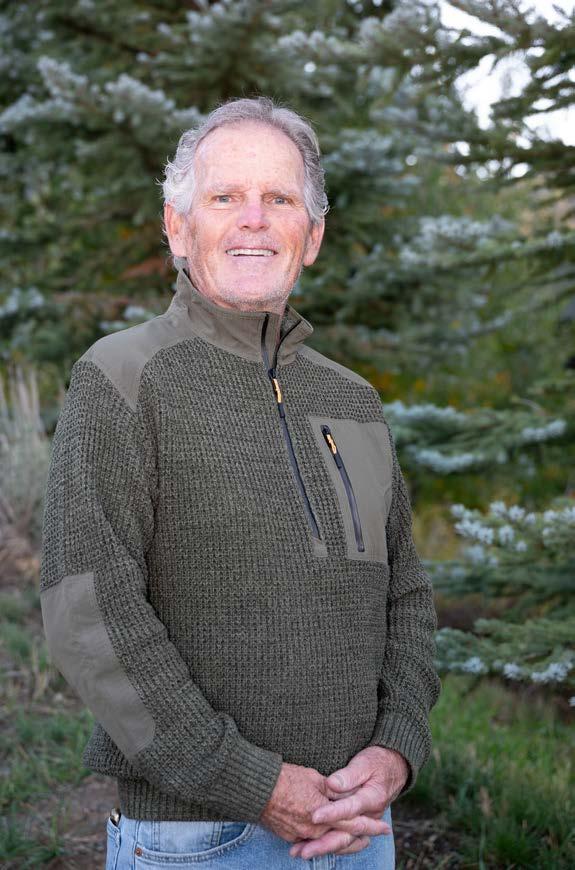
They built a ramp and hauled in about 200 bales of hay for the landing, which they had to fluff up to soften the impact. Halfway through the job, Park and Rusty noticed Mike climbing to the top of the jump. “I reminded him we’d only fluffed about 100 bales and that maybe it wasn’t the best idea to go for it just yet,” Park says. “But, true to form, Mike went anyway.” Needless to say, he missed the straw and landed squarely in the dirt. “And that, believe it or not, was the beginning of the Great Western Freestyle Center,” Park finishes.
“There wasn’t another place like that in the world,” says Olympic aerialist Fuzz Feddersen, who was 10 years old at the time. “Park was wearing corduroy shorts and Vuarnet glasses. I thought he was so cool.”
Steamboat resident Jeff Good, who was Park’s successor as the U.S. Freestyle Team coach, was first introduced to the sport when he moved to town in the 1980s. Friends suggested he sign up for the Tequila Cup, a now-defunct bump competition during Winter Carnival.
After the event, Park was showing video at Buddy’s Run (now Timber & Torch), and Jeff had never seen himself ski. “I ran over there, and Park was the emcee. He was pouring Cuervo into what amounted to a … bowl. I didn’t really know anybody, but I felt really welcome,” Jeff says. “The way Park handled it, it was all about camaraderie. We were an island of misfits, but as a collective, we worked. All of us are still in touch. It’s unique to have something like that in your life.”
Those lifelong friendships were renewed last spring when Park was inducted into the U.S. National Ski and Snowboard Hall of Fame. People came from around the world to celebrate with him. “Everyone has a Park story,” Jeff says.
One of the best comes from Donna Weinbrecht, who won the first gold medal in Olympic freestyle skiing at the 1992 Winter Olympics in Albertville, France.
“As a kid, I loved the Olympics, but I thought it was for special people – not me,” Donna says. Skiing was not a family sport,
and there wasn’t money for coaching, so Donna taught herself at Hidden Valley in New Jersey, near her hometown. Eventually, when she earned a spot on the U.S. Freestyle Team, Park literally became her first coach.
Donna’s career is legendary, including five overall World Cup titles, 46 World Cup wins, seven U.S. championships and three trips to the Olympics. Despite the podiums, she sometimes had self-described imposter syndrome. When Park figured that out, he was incredulous. “Park looked at me with that leprechaun face and said, ‘You don’t believe you’re good?’ He always could get me out of my own head. He was the most impactful person in my career,” Donna says.
When moguls became an official Olympic sport in 1992, Park was transitioning from coaching to broadcasting, where he continued to be freestyle’s most vocal proponent. He was in the media booth on the day of the women’s mogul finals, when a storm left the snow sticky and unpredictable. Donna was struggling to land her second air during practice. Park saw
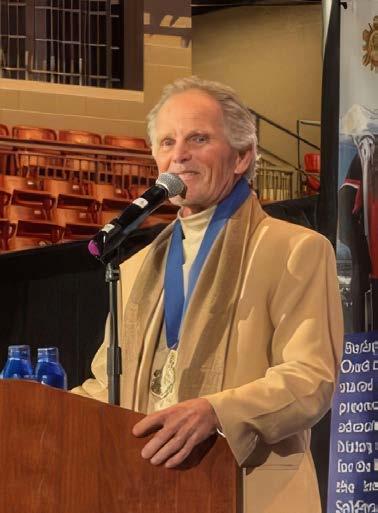
what was happening and left the booth to help her. “What are you doing?” she recalls him asking, encouraging her to land the jump straight-on, instead of cautiously pulling to the side.
“It was just what I needed to hear,” Donna says. She brought home the gold, while Steamboat’s Nelson Carmichael took the bronze medal in the men’s event.
In the ensuing years, Donna, Nelson and Fuzz were inducted into the U.S. National Ski and Snowboard Hall of Fame, but not Park. “When I got inducted, I felt guilty because he should have been in before me,” says Fuzz, who led the charge to get Park elected. “He did so much for the sport. He was THE guy. He was the one who always stood for freestyle.”
So it was with tears in his eyes that Park finally stood before his former athletes last April, accepting skiing’s penultimate honor. Once again, he stuck the landing for the sport he loved.


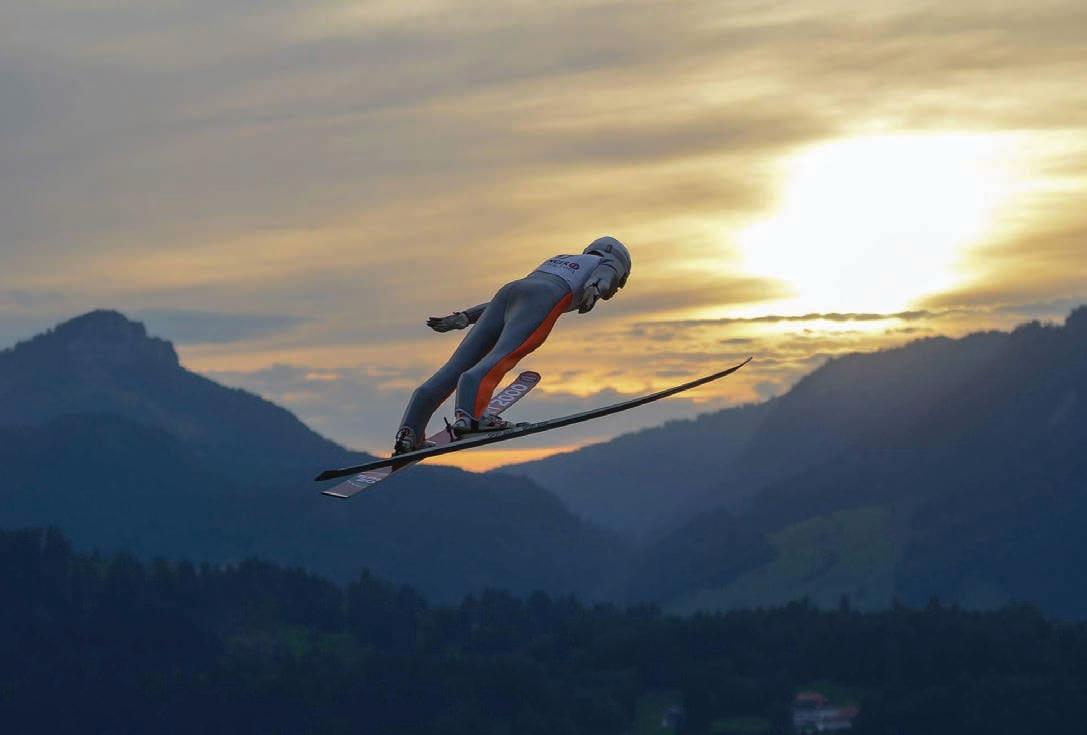
Local Olympian Ben Berend weighs in Did Ya Know?
Steamboat Springs has produced more Winter Olympians than any other town in North America (100 as of 2022).
The Steamboat Springs Winter Sports Club was founded in 1914 and has become a premier training ground for aspiring athletes, with worldclass coaching and facilities at the Howelsen Hill Ski Area downtown.
Notable recent Olympians from Steamboat include Todd Lodwick, a six-time Olympian in Nordic combined, and Johnny Spillane, the first American to win an Olympic medal in that discipline. More recently, athletes like Mick Dierdorff (snowboard cross) and Jaelin Kauf (moguls) have continued the tradition, earning spots on U.S. Olympic teams.
Good ol’ Howelsen Hill downtown is one of the oldest continuously operating ski areas in the country and is responsible for many of Steamboat’s Olympic appearances as a training site (many Olympians took their first runs on its slopes).

| BY EUGENE BUCHANAN
The world of ski jumping is facing controversy ahead of this winter’s Olympics with last March’s world championships marred by athletes being disqualified over baggy-fitting suits. While the governing body says it’s “perfectly normal,” the International Ski Federation discovered illegally altered suits on the Norwegian team, whose larger surface areas could aid longer jumps. Olympic gold medalists Marius Lindvik and Johann André Forfang and three staff members were charged with ethics violation and “equipment manipulation.”
At the first event of the 2025-26 season – a summer Grand Prix in France – six male jumpers were also disqualified because of suit issues, with four more not permitted to jump. The disqualifications were reportedly due to more stringent rules after the Norwegian incident, with fewer disqualifications expected as teams get used to the new rules.
To find out the skinny on the bigger suits, we tracked down 2018 Olympian Ben Berend. Here’s what he had to say: “Ski jumping suits are the most important piece of equipment when it comes to ski jumping. An amazing suit sets you up for success and a bad suit can limit your chances at a good result. A few things go into the suits, including good material and as much surface area as possible, ideally between the arm and chest and between the legs (think wingsuit). The FIS controls this by saying each suit needs to be three centimeters bigger than that point on the jumper’s body, meaning the suits are custom-tailored to each athlete. Athletes are always looking for ways to find gray areas or maximize suit size. I used to practice puffing my chest and belly out so that I could fill the suit when getting tested but have more than three centimeters of tolerance in those areas when standing normal.”
1932 John Steele becomes the first skier from Steamboat Springs to compete in the Olympics in Lake Placid, New York.
1948 Steamboat’s Gordy Wren becomes the first American to qualify for all four Olympic skiing disciplines (slalom, giant slalom, super giant slalom and downhill) in St. Moritz, Switzerland.
1964 Buddy Werner, the American Alpine racer who broke the European domination of the sport, is killed in an avalanche in Switzerland; Billy Kidd wins slalom silver in Innsbruck, Austria.
1984 Former SSWSC Alpine program director Deb Armstrong wins giant slalom gold in the Sarajevo Olympics, becoming first U.S. woman to win an Alpine gold in 32 years.
1992 Nelson Carmichael wins bronze in moguls in Albertville, France; Lowell Whiteman School (now Steamboat Mountain School) student Ryan Heckman competes in Nordic combined; SSWSC athlete Nick Cleaver competes in moguls.
1994 In Norway’s Lillehammer Games, SSWSC athlete Nick Cleaver competes in moguls, Randy Weber competes in special jumping, Dave Jarrett,
Ryan Heckman, Todd Lodwick compete in Nordic combined, and Julien Castellini competes in Alpine.
1998 Phoebe Mills (1988 Summer Games bronze medalist on balance beam) coaches Shannon Dunn to the bronze medal in halfpipe in the Nagano Olympics; Randy Weber competes in special jumping; Dave Jarrett, Johnny Spillane, Todd Lodwick compete in Nordic combined; Sacha Gros, Linus Vaitkus compete in Alpine.
2002 Travis Mayer wins silver in moguls in Salt Lake City; Caroline Lalive places seventh in Alpine combined; Johnny Spillane, Todd Lodwick place fourth in team event in Nordic combined; Clint Jones, Tommy Schwall compete in special jumping; Michelle Gorgone competes in snowboard giant slalom.
2006 Ryan St. Onge competes in aerials in the Torino Games; Travis Mayer takes seventh in moguls; Johnny Spillane, Todd Lodwick place seventh in team event in Nordic combined; Clint Jones, Tommy Schwall compete in special jumping; Michelle Gorgone competes in snowboard giant slalom.

2010 Johnny Spillane, Todd Lodwick, Billy Demong and Utah native Brett Camerota win silver medal in Nordic combined team event in the Vancouver Games; Johnny Spillane (in his fourth and final Olympics) goes on to win two more silvers in the normal and large hill events, with Billy Demong winning gold in large hill.
2014 Todd Lodwick competes in historic sixth Winter Olympics at Sochi Games; Taylor Fletcher joins Nordic combined team to take sixth; Vic Wild wins two golds in Alpine snowboarding.
2018 Brothers Taylor and Bryan Fletcher compete in Nordic combined in PyeongChang, South Korea; Jarryd Hughes takes silver in snowboard cross; Arielle Gold wins bronze in snowboarding; coached by Steamboat Olympian Justin Reiter, Ester Ledecká wins gold in both Alpine snowboarding and skiing; Steamboat born and raised Ben Berend competes in Nordic combined team relay.
2022 Jaelin Kauf wins silver in moguls in Beijing; Taylor Fletcher competes in Nordic combined in fourth and final Olympics; in all, 13 athletes with Steamboat ties compete.


So how many Olympians does Steamboat really have? With numbers batted around like a tennis or pickle ball, the official tally, says those in the know, relies on one caveat: athletes who have trained with the Steamboat Springs Winter Sports Club (SSWSC).
“That’s the number we use when talking about Olympians,” says SSWSC communications director Jeanne Mackowski. “There are more who live here but didn’t train with SSWSC, some of whom are our coaches who have won medals.” That
Alan Alborn
Jim “Moose” Barrows
Ann Battelle
Manuela Berchtold
number, she adds, stands at 100. Add another 18 for Winter Olympians with ties to Steamboat, six for Summer Olympians and another 14 for those who have coached at the Olympics. Other Olympian counters agree. “After much work comparing lists, I decided I wouldn’t announce a number because it wasn’t inconsistent with SSWSC and ski corp. and I didn’t want to confuse the messaging,” says Tread of Pioneers Museum curator Katie Adams. “So I kept with the ‘Over 100 Olympians and counting.’”
Brett Camerota
2010 Silver
Eric Camerota Van Card
Marvin Crawford
Jeff Davis
Matt Dayton
Decker Dean

Bundle up and enjoy seeing some locals in our winter wonderland.
Leave them room and use your zoom. Ask the visitor center about the best spots to respectfully view wildlife.

Explore visitsteamboatsprings.com to learn more
Shannon Dunn
1998 Bronze
Tarsha Ebbern
Jere Elliott
Bryan Fletcher
Taylor Fletcher
Olivia Giaccio
Kylie Gill


Matt Grosjean
Ryan Heckman
Corky Heid
Ray Heid
Madii Himbury
Jed Hinkley
Jarryd Hughes
2018 Silver
Dave Jarrett
Tyler Jewell
Clint Jones
Jaelin Kauf
2022 Silver

Ellie Koyander
Caroline Lalive
Ester Ledecká
2018 Gold (2);
2022 Gold
Andy LeRoy
Jana Lindsey
Todd Lodwick
2010 Silver
Kerry Lynch
Rosie Mancari
Travis Mayer 2002 Silver
Adam McLeish
Chris McNeill
Rick Mewborn
Jack Miller
Michael Morse
Aaron “AJ”
Muss
Eliza Outtrim
Crosby Perry-Smith
Maria Quintana
Justin Reiter
Katy Rodolph-Wyatt
Ansten Samuelstuen
Tommy Schwall
Johanna Shaw
Erin Simmons Nemec
Jason Smith
Johnny Spillane
2010 Silver (3)
Ryan St. Onge
John Steele
Tim Tetreault
Craig Thrasher
Mike Trapp
Linas Vaitkus
Carl Van Loan
Randy Weber
Keith Wegeman
Paul Wegeman
Buddy Werner
Loris Werner
Skeeter Werner
Vic Wild
2014 Gold (2); 2022 Bronze
Todd Wilson
Cody Winters
Gordon Wren
Kimiko Zakreski
Bobby Aldighieri
Deb Armstrong
1988 Gold
Martin Bayer
Jan Bucher
Alex Deibold
Jarle Halsnes
Hank Kashiwa
Billy Kidd 1964 Silver
Ally Kunkel
Ron McMorris
Chris Puckett
Ivana Radlova
Thedo Remmelink
Richard Stithen
Jorge Torrella
Sue White
2017 Gold, Special Olympics
Sean Colgan
Fred Honebein
Anne Kakela

Rich Weiss
Sven Wiik
Blake Worsley
Retail Name Address City, State ZIP
Phone
2680 Jacob Circle Unit C Steamboat Springs, CO 80487 www.steamboatcarpet.com P: 970-879-0103
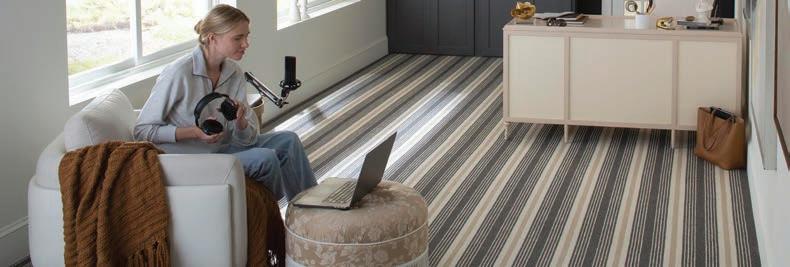
Logo/Image Area (Optional)
| BY SOPHIE DINGLE, SKYLAR LEESON AND HALEY WATKINS
Steamboat Springs is the land of 100 (and counting) Olympians. Here are 19 hopefuls for the 2026 Winter Games in Cortina/Milan. These athletes were born and raised in Steamboat Springs — or have ties to the town through training with the Steamboat Springs Winter Sports Club. Some are looking for a medal, some are looking for re demption, but all are looking for their shot to represent their country at the Olympics.
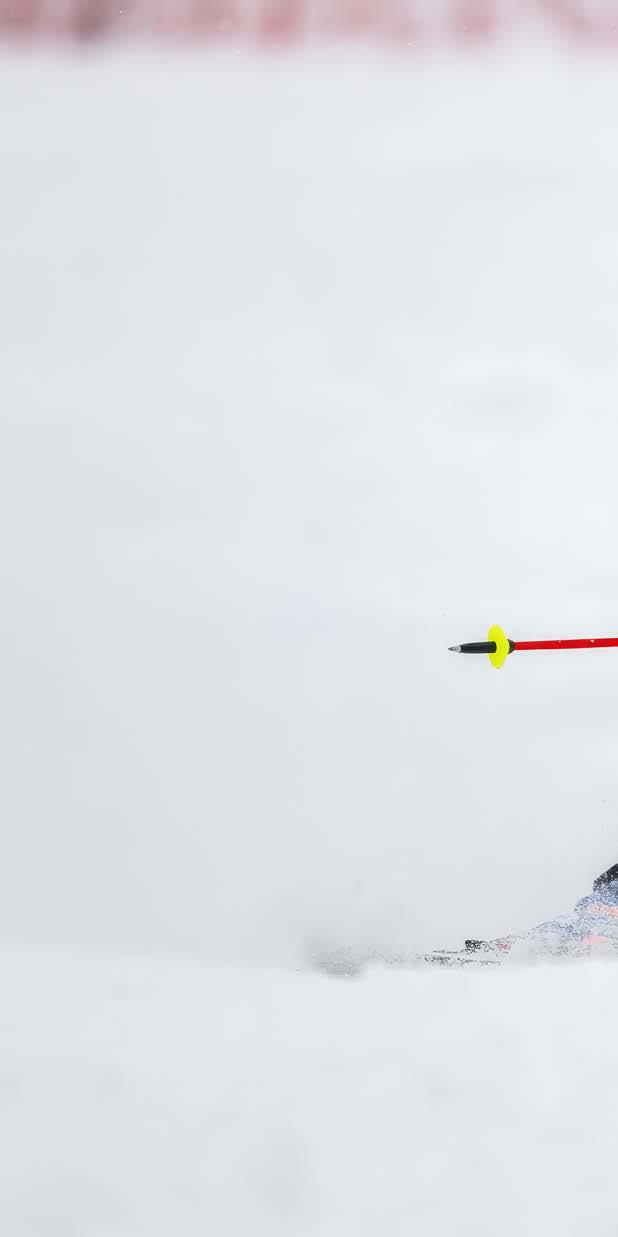

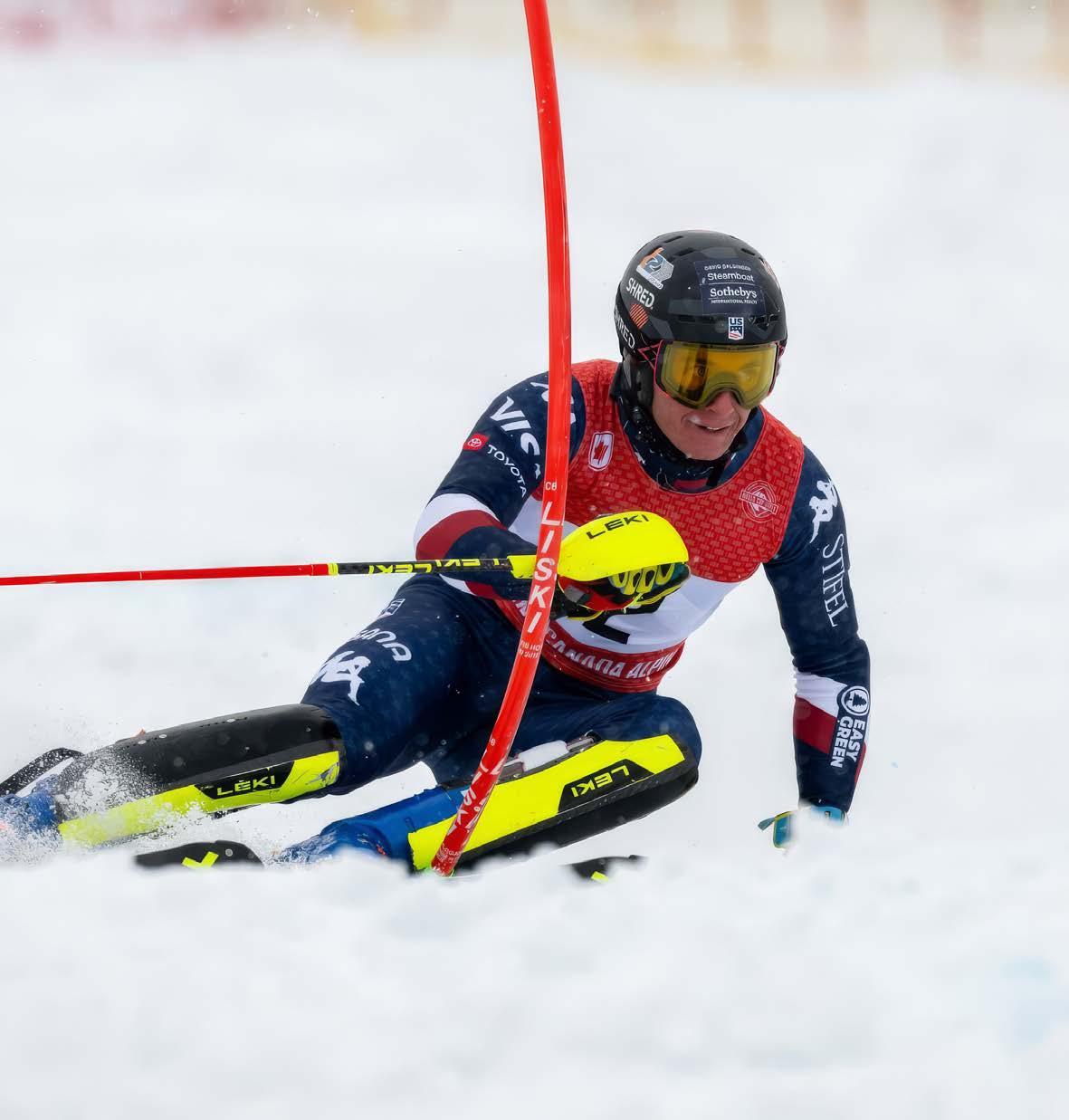
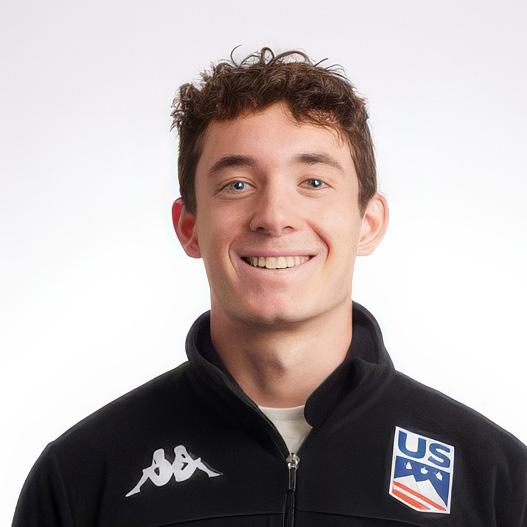

ForCooper Puckett, skiing has never been just a sport – it’s been a lifelong love. He first clicked into skis at age 1 and grew up chasing tree lines on Mount Werner and training under the lights at Howelsen Hill. By the time he was eight or nine, racing became the focus. “I was always in love with skiing,” he says. “My dad (Chris Puckett) and uncle (Casey Puckett) were both World Cup skiers and Olympians, so naturally I looked up to them and developed my own passion.”
That passion has fueled a steady rise through the ranks. Just two years ago, Cooper was racing NorAm Cups. Last season, he stepped up to the Europa Cup – one tier below the World Cup – and even earned starts in two World Cup GS races. “The last few years I’ve been fighting to get into the World Cup,” he says. “This year, I’m aiming to break in and be in the top 30 in the world.”
Like most ski racers, Cooper has faced his share of setbacks. “It’s a brutal sport,” he admits. “There’s so much that’s out of your control. Even if you do everything right, anything can happen. My technician always says, ‘95% disappointing days and 5% good can be a great season.’”
But despite the disappointment, quitting has never crossed his mind. “What keeps me going is knowing what I’m capable of achieving and trusting that I’ll get there if I keep doing my best,” Cooper says.
The Olympic Games are naturally part of that vision – and a family tradition. “Competing at the Olympics means competing at the highest level, fulfilling a dream and being part of history,” he says. “It’s something I’ve always wanted.”
When pressure builds, Cooper turns inward. “I like to breathe through it, trust God and be present in my body.” His
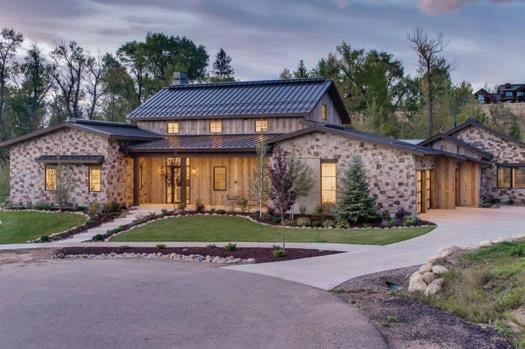
rituals are minimal – just the way he puts on his boots, though the rest he keeps secret. If he could give advice to his younger self, it would be simple: “I wish I knew I could ski my best by just enjoying myself.”
And while the world might measure him by results, Cooper’s perspective runs deeper. “I don’t care how I’m remembered as an athlete,” he says. “This journey is about personal and spiritual growth and seeing what I can achieve. It’s more important how I’m remembered as a friend, a son, a husband – and how God judges me.”


“I like to breathe through it, trust God and be present in my body.”


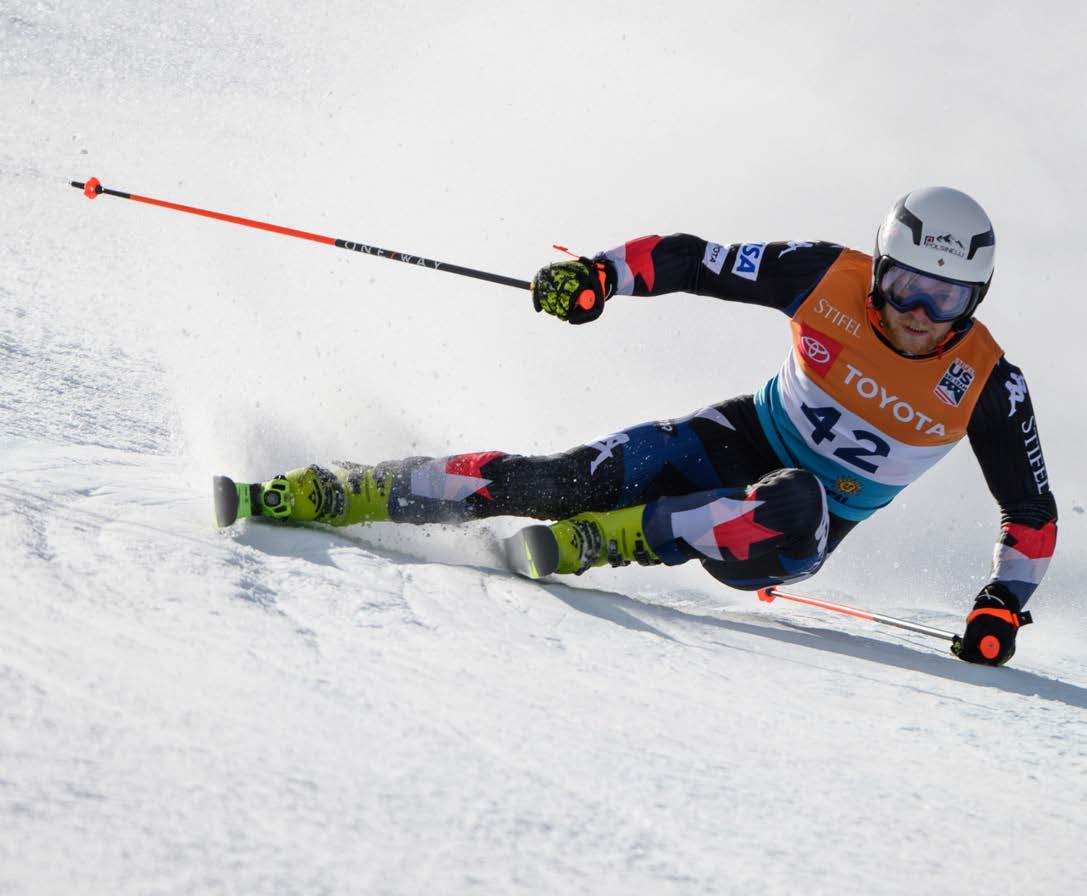
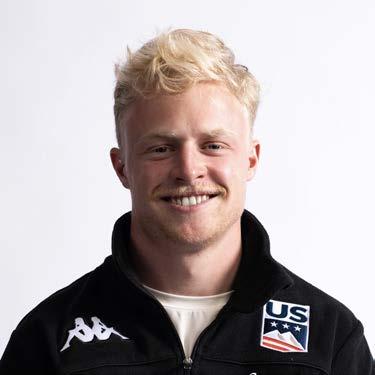
Jett Seymour Alpine Skiing
“I think that when I can take advantage of the opportunities that are presented to me, that’s when I’m successful.”
In2020, Jett Seymour’s mother, Blair, told Steamboat Magazine a story about a poster that Jett had made at age 10, after a trip to the Olympic Training Center. “The poster was about how he wanted to go to the Olympics,” she said at the time, “and his drive and passion through the years has been impressive.”
A decade and a half later, Jett is on track to reach his dream. The Steamboat Springs born-and-raised slalom skier is a regular on the World Cup circuit. But his path was different: he went to college. And during his time skiing for the University of Denver, he won two National Championships and was named Collegiate Skier of the Year in 2019. “I think going to college was one of the best decisions I’ve made,” Jett says. “It really allowed me to grow as a person.”
When he wasn’t named to the U.S Ski Team his junior year, he knew that he had DU to fall back on. “Luckily I had DU as my home,” he says. “That sense of security allowed me to buckle down and get better at skiing.”
Which he did – as proven by a seventh place World Cup finish in Chamonix, France, during the 2023 season. But Jett is less concerned about numbers than he is about steady improvement. “I think that when I can take advantage of the opportunities that are presented to me, that’s when I’m successful,” he says. “I want to make those moves that show that as a ski racer, I’m continuing to get more consistent and move forward in the World Cup. If that happens, then I will be at the Olympics.”



AbbyOlson, a rising Alpine ski racer with roots in Steamboat Springs, is making waves on the international stage as she trains and competes with Burke Mountain Academy in Europe. Recently named to the Olympic long list, Abby credits her hometown, family and mentors for shaping her journey.
Steamboat Magazine: What’s it like representing Steamboat on the world stage?
Abby Olson: Although I am skiing with Burke Mountain Academy this year over in Europe, getting to grow up in Steamboat and ski has been an amazing experience and I wouldn’t change it for anything. The people are amazing and the skiing is awesome! Everyone is so supportive and is always rooting for everyone on the team. I am very honored and excited to be given the opportunity to be on the Olympic long list and if it did get to that point I would be very proud to be representing Steamboat on that stage.
SM: Who in town has played a key role in your success – coaches, friends, mentors?
AO: My parents and friends played a huge role because they always support me no matter what and they always know how to push me and keep my spirits up. I also wouldn’t be in this sport if it weren’t for my parents, so thank you to them. One of my biggest mentors over the past few years has been my strength and conditioning coach, Jeff Thompson – he is one

of the most supportive people in my life. He is always pushing me to new levels in the gym which allows me to excel on the ski hill. He always knows what to say, is rooting for me and believes in me and my abilities.
SM: Do you remember your first experience on snow here in Steamboat? What was it like?
AO: I don’t remember my first experience on snow in Steamboat, but I know that my parents were there and my dad was skiing with me between his legs. He always tells me that it only took a few days and then I started to get the hang of it by myself.
SM: How do you stay grounded while training for something as big as this?
AO: I try to focus on short-term goals rather than getting overwhelmed by the big picture. Of course, I have long-term dreams, but staying present and working toward smaller milestones helps me stay motivated and grounded. It’s about building the process step by step.
SM: What do you hope your story brings to the Steamboat community, especially young athletes?
AO: I hope that my story helps athletes realize that they can do anything that they put their mind to. But also that no matter what you do in life there will always be people out there that support you and want you to succeed. You just have to find those people and they will do anything and everything for you.

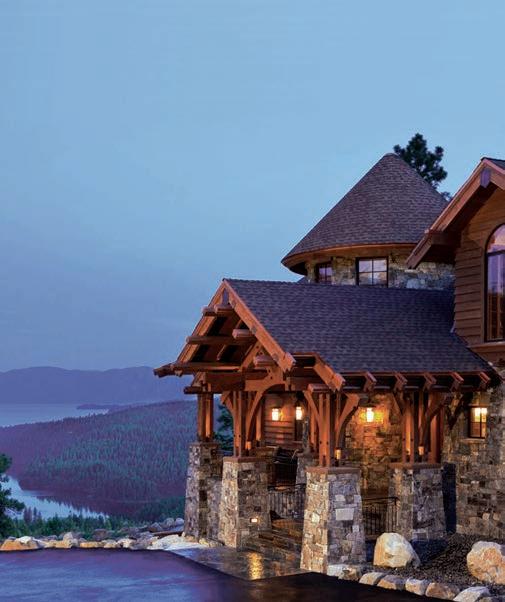


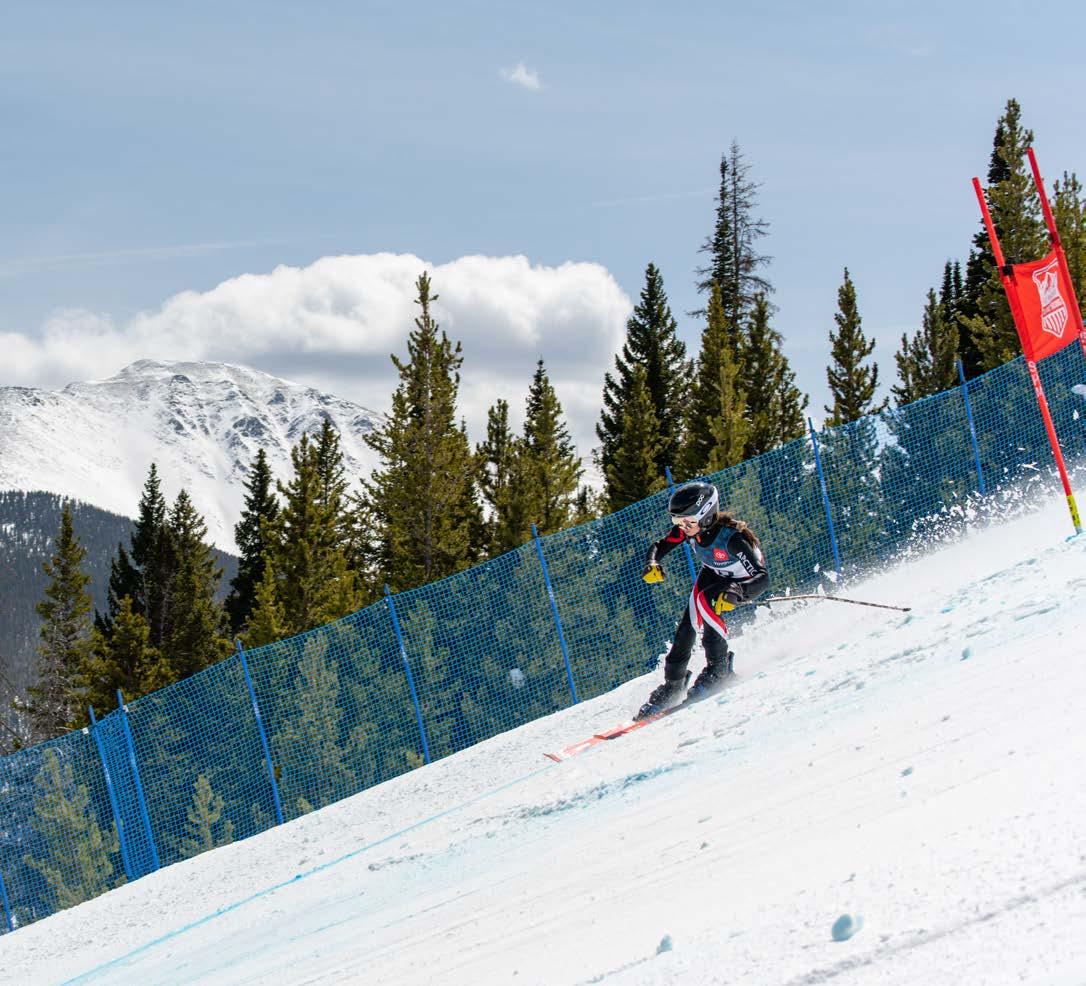
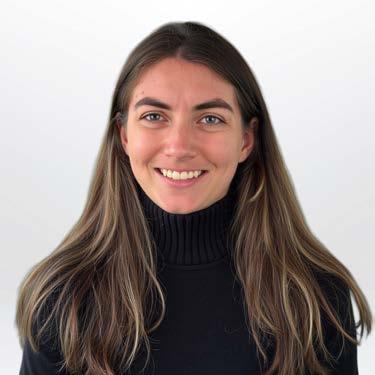
Springs native Paige VanArsdale has her sights set on representing Team USA at the 2026 Paralympics in Cortina, Italy. The para-Alpine ski racer – who lives with cerebral palsy – opened up about her journey, the community that’s supported her and the challenges she’s overcome along the way.
Steamboat Magazine: How did you first get involved in adaptive sports? Was there a moment that sparked it for you?
Paige VanArsdale: I started skiing when I was 3 years old. I skied with the Steamboat Springs Winter Sports Club, where volunteers would ski one-onone with me so I could keep up with the group. I also did STARS ski camps, and later some of the instructors even asked me to buddy up with younger kids who needed support on the mountain. After leg surgery in sixth grade, my doctor told me I should start ski racing. Not long after, STARS started a race program with coach Tommy Moore. That’s how I ended up going to the NASTAR Nationals – and there I met ski racer Ted Ligety, which was really cool.
SM: What events are you hoping to compete in at the 2026 Paralympics in Cortina?
PV: I race in para-Alpine skiing – slalom, giant slalom, super-G and downhill. During the 2023-24 season, FIS (International Ski and Snowboard Federation) instigated a new rule of only being allowed to ski with one pole for standup skiers in my category. So I began training to get comfortable using one pole. My first race of the season was the day after Valentine’s Day in Canada. It was my first time competing in downhill. I fractured my tibial plateau during my second run. My FIS points suffered from missing the entire season. And I was cautious when I returned last season since I was coming back from that injury. I only podiumed in two races. I have a lot of ground to cover to improve my points to compete on the world stage. This season I’m getting Botox and physical therapy treatments in my right leg to help relieve the spasticity caused by my cerebral palsy. I hope this treatment will give me flexibilty in my right leg to help with training and racing.
SM: Training for the Paralympics must be intense. What keeps you motivated?
PV: My coaches. Coach Jules – we call her Mama Bear – helps get me in the right mindset before each race. She also leads yoga classes at the end of training days, which help us reset. I also feel supported knowing that my coaches, Rob and Hillary, are positioned along the course to give me feedback at the end

of the day. And I love skiing with my brother Kaleb – he pushes me to try harder terrain, like hiking to ski steep runs or deep powder.
SM: What does Steamboat mean to you in all of this?
PV: Steamboat is my home – I was born and raised here. The community feels like a second family. They’ve supported me through ups and downs, always encouraging me to keep going. Whether I’m coming back from injury or celebrating a win, I’ve felt their support. I’ll always be thankful to be part of this town.
SM: What advice would you give to young athletes – especially those facing similar challenges?
PV: Don’t doubt yourself. If you feel like giving up, try setting smaller goals that lead to your big one. That way you don’t feel overwhelmed. Maybe even create a vision board – that has helped me stay focused on skiing and other life goals.
“I have a lot of ground to cover to improve my points to compete on the world stage.”

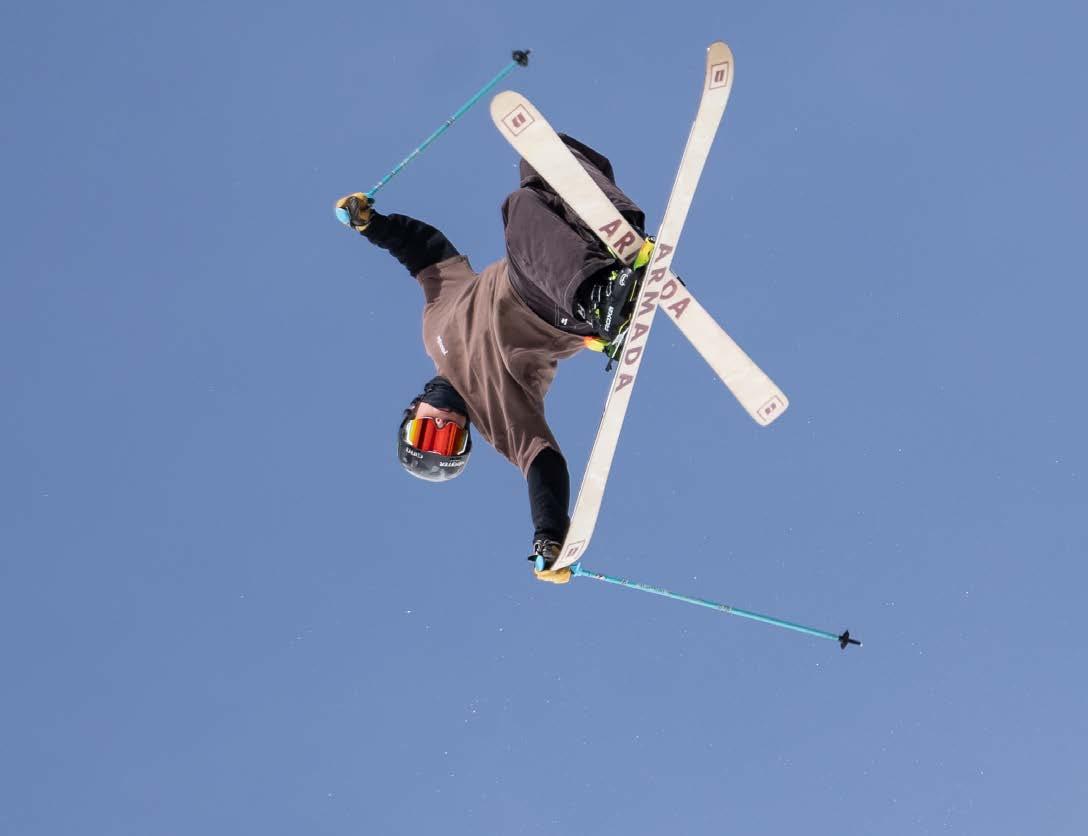
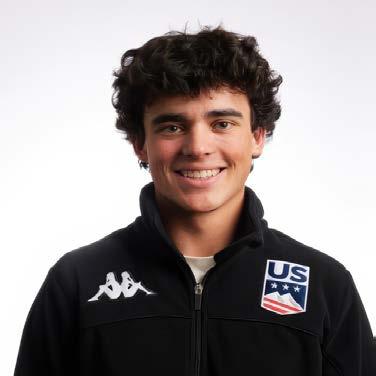
CaelMcCarthy first knew he wanted to be an Olympian while watching the 2014 Games in Sochi. “The Americans swept the podium in slopestyle, and I turned to my mom and said, ‘I want to do that,’” he remembers. “She thought I meant selling candy bars like Nick Goepper, but I told her, ‘no, I want to go to the Olympics in this sport.’”
He started skiing with Steamboat Springs Winter Sports Club at 8 years old, quickly realizing he loved spinning through the air more than racing. From there, his path took him to Park City, Utah, where he balanced school and year-round training. “Training has basically been nonstop ever since –airbag work in the summer, camps, World Cups in the winter. Even when it’s exhausting, I still love every part of it.”

“It’s about representing Steamboat, Park City, every coach I’ve worked with, and my family. That’s what matters most.”
That love has fueled steady progress. At 15, he skied his first NorAms and foreran the X Games halfpipe in Aspen. In 2024, he broke through to World Cup finals and later won the NorAm Cup, earning a spot on the U.S. Rookie Team. “That was huge for me – proof that all the work was paying off,” he says.
Unlike many athletes, Cael has never thought about quitting. “Even after a mediocre World Cup season, I’ve never lost the passion,” he says. “I’m still completely dedicated.” For him, nerves are a gift. “I pride myself on staying calm in big moments. To me, it’s just another run.”
Looking ahead, his goal is simple: keep pushing harder tricks, make the pro team and chase the Olympic dream he’s had since he was a kid. “It’s not about the title,” Cael says. “It’s about representing Steamboat, Park City, every coach I’ve worked with, and my family. That’s what matters most.”


riley jacobs Freeski Pipe

“I think it’s so much fun to not have to worry about gravity for a couple of seconds.”
RileyJacobs loves being in the air – this made her decision to pursue her halfpipe dreams easy. “I think it’s so much fun to not have to worry about gravity for a couple of seconds,” she says. “There’s a lot of freedom to it.”
The Oak Creek native trained with Steamboat Springs Winter Sports Club before being named to the U.S. Ski and Snowboard Women’s Halfpipe Pro Team in 2024. At the time, with several high-profile finishes, her sights were set on Italy in 2026. “For the last few years, I’ve been working really hard,” she says. “I knew that the last Olympics in China weren’t really worth pushing for; I’ve always thought that 2026 is what I would shoot for.”
Then – injury. When Riley was training in Austria last November, she tore her ACL. She flew home, had surgery and spent the subsequent months recovering. Finally, she was cleared to go to New Zealand 10 months after the injury. “It was my first time back on skis in months,” Riley says. “My feet weren’t allowed to leave the ground for the first 10 days.”
That was a feat that was difficult for the skier, whose email prefix reads “flyingriley.” But this winter, she’s determined to do what she’s been doing all along: flying … and landing on her feet. “My mindset is to keep my feet under me,” Riley says. “I want to keep it clean and do what I know how to do and what I’ve been doing. No need to be super risky.”


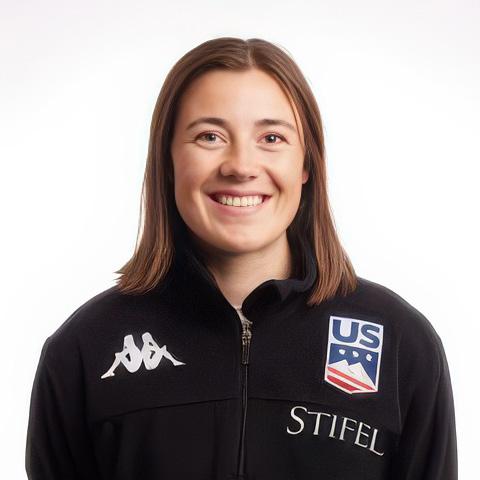
AsJaelin Kauf heads into her third Olympics, she’s taking lessons from her first two with her. Mainly, she says, that’s channeling the love she gets from friends, family and fans into her skiing. It’s worked for her in the past: in 2022, she won a silver medal in Beijing. The mogul skier, who skied with Steamboat Springs Winter Sports Club for six years, is excited for even more medal opportunities as dual moguls is added to the lineup for the first time. “It’s super exciting,” she says. “It will be really cool to compete in the debut of that.” Jaelin also shared with us her career highlights, the lessons she learned from two Olympics and how she lives by her motto, ‘deliver the love.’ Steamboat Magazine: You’ve had a huge career so far – how do you keep the momentum going?
Jaelin Kauf: I love the sport and I love what I do and that’s definitely the biggest drive for me. There’s always room to get better and keep building on what I have, so I just keep trying to progress and push myself and the sport every year.
SM: What has been your career highlight so far?
JK: The 2022 Olympics; getting a silver medal there was amazing. I definitely had a pretty tough season leading up to the Games and there was a lot going on with Covid during that time. I had to be all alone heading into the Games; I couldn’t be around family. There was a lot of team and freestyle drama leading into the Olympics as well, which made me question if I should even be on that team. And then I just had so much fun and was able to put everything aside and ski.
SM: You have two Olympics under your belt – what were some lessons you learned in the first two and what do you hope to take with you going into a third Olympics?
JK: From the first to the second, there was such a big difference. I grew a lot and learned so much more about how to handle and acknowledge all the pressures and excitements of the Olympics. In 2018, I felt like I had the weight of the world on my shoulders going into the Olympics and I really didn’t know how to handle that pressure. Most of it was internal pressure that I was putting on myself more than anything. I really learned that all those people cheering for me at the bottom of the course or at home were just wanting the very best for me and they were so stoked to be a part of it. They weren’t disappointed if I didn’t medal or didn’t do well. They were so supportive of me no matter what. That was the biggest thing that I took with me going into 2022 – was knowing that and taking all that love and support and channeling it into me skiing how I wanted to ski. I was able to do what I was there to do instead of letting it bring me down with pressure. After 2022, it’s exciting to have fans back at the Olympics. Having a bunch of friends and family at the bottom of the course will be really special. I’m keeping that same thought and feeling of letting that love channel through me into my skiing instead of bringing me down in any way.
SM: Tell us about your motto, ‘Deliver the Love.’
JK: I came up with that motto with the help of a friend after the 2018 Olympics. I was figuring out why I do what I do and that

daily reminder for me, whether in life or at the top of the hill, is why I’ve always skied. Obviously I have big goals that I hope to accomplish in my career as well, but the driving force behind it all is the love for being out there and the love for what I do.
SM: You’re an advocate for women and girls in your sport –why is that work important to you? Was there someone advocating for you along the way?
JK: My mom was always a huge role model to me. She showed me that I could do anything that I wanted to do – sports or anything else. Being a girl or woman had nothing to do with any lines or boundaries that were defined for me. I watched her break boundaries through my childhood, which was amazing. Even though I grew up on very male-dominated teams for the most part, I still had so many amazing female role models in my life. I’ve been able to be involved with the Women’s Sports Foundation over the course of my career, which I’ve loved to be a part of and support in any way I can. Being in sports has given me so much in my life and it has so many benefits. You see girls drop out of sports earlier than guys do and there’s so many benefits that sports have for us. So if I can be a role model and encourage girls to stay in sport and find whatever sport it is that they love to do, I’m stoked to be a part of that.


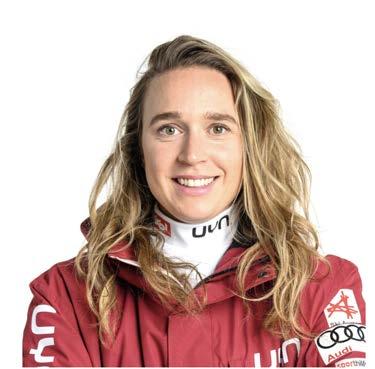
AsAvital Carroll looks for her Olympic shot in 2026, her focus isn’t just on moguls – it’s also on sharing her heritage and history. The mogul skier aims to ski for Austria in the Olympics, due to the new Nationality Act. In high school, Avital begged her parents to let her attend Lowell Whiteman School (now Steamboat Mountain School) after she found out one of her coaches had gone there. While there, she joined the Steamboat Springs Winter Sports Club freestyle moguls program and stayed with the club for seven years before making the U.S. Ski Team and moving to Park City, Utah.
Steamboat Magazine: How did you get into moguls skiing?
Avital Carroll: I am the youngest of five kids, and my sister, Arielle, who’s the oldest, was randomly approached in the base lodge in Stratton, Vermont, while sitting with our parents having lunch. It was the head of the freestyle program who asked if she would like to try the program. Arielle and my parents looked at each other, shrugged their shoulders and said, “sure!” Ever since then, since we were old enough, we followed in her footsteps and started the freestyle program at Stratton Mountain as weekend warriors. I started competing at age 6.

SM: This is potentially your first Olympics and you’ve decided to ski for Austria. Tell us about the switch from the U.S. to Austria.
AC: This switch became possible because Austria came out with the Nationality Act, which grants citizenship to direct descendants of everyone who was forced out due to the Holocaust. My grandma and her immediate family were forced out when my Oma was 7. They were fortunate enough to be able to escape through Northern Italy, then to Rome, before being amongst those who were chosen (1,000 Jews) to take a boat to the United States. Being able to represent my heritage, and have my platform to talk about this – and unfortunately the horrible things that continue to happen in our world – has been quite emotional. It’s been more meaningful than I could have ever imagined. My motto has always been ‘Love-DreamUnite.’ Love everyone. Dream big, and unify. Being able to talk about the craziness that still is going on in the world today is super important, because the more we talk about it, the more aware we are of it as a whole.
SM: Your husband, Bobby Carroll, is your coach. How does that dynamic work?
AC: It’s definitely a different dynamic. Basically, what it comes down to is communication. Bobby knows me better than anyone, so who better to be able to read my feelings, know what I’m capable of and have someone who wholeheartedly cares about me? He used to be a mogul skier as well, so he really understands. At times it can be tricky because I thrive in an environment where it’s more intense, and Bobby doesn’t want to be that mean to me … which is fair! But we have talked about this and found ways to navigate.
SM: What is something that you’re thinking about while training for the Olympics?
AC: I’m thinking about what’s the best I can do every day. What are the little things that will ultimately prepare me the best to reach my goals? This keeps me grounded and doesn’t let me get ahead of myself.

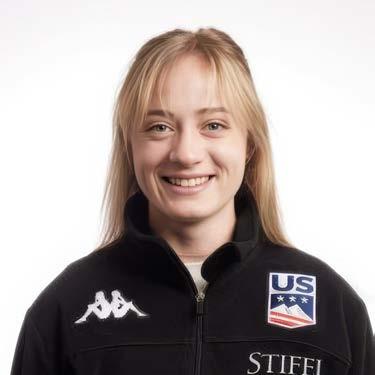
Olivia Giaccio

“I wouldn’t be where I am today without the support of SSWSC and the town as a whole.”
In2022, Olivia Giaccio was asked in a Steamboat Magazine interview what her proudest moment in her sport was so far. Her answer was that in 2019, she became the first girl to attempt a cork 10 in competition. “But I didn’t land it,” she told the magazine. “One of my goals for this upcoming year is to stomp that trick in competition!”
Fast forward to now: When asked the same question in an interview in September 2025, her answer was winning a World Cup in Deer Valley, Utah, with a cork 10. It was the first time in the world that a woman won a World Cup with a cork 10. Obviously, this time she landed it. “Something that drives me is propelling real change forward in my sport,” Olivia says. “Changing the landscape of the women’s side of moguls skiing.”
The trailblazing athlete trained with Steamboat Springs Winter Sports Club for two seasons (2015-16 and 2017-18). She attributes her time in Steamboat as a great fit for her career at the time. “Steamboat really welcomed me in and that was very meaningful to me,” she says. “I wouldn’t be where I am today without the support of SSWSC and the town as a whole.”
This is where she is today: training for the 2026 Olympic Games in a discipline that is a notoriously difficult team to make. “It’s a little daunting, but it’s also really inspiring,” she says.
While she already has one Olympics under her belt (finishing sixth in women’s moguls in 2022’s Winter Olympics in Beijing), her first experience was heavily impacted by Covid. “I didn’t have any family or friends there,” Olivia says. “I saw my family before I left the U.S., but only from five feet away and with masks on.” Prior to arriving in Beijing, she had to quarantine for two weeks, alone in a Park City apartment. “I wasn’t able to have the village that got me there with me,” she says. This time though, things will be different. With her sights set on Italy in February, Olivia is taking things day by day. “When I enjoy the experience as much as I can and take it day by day and try my best, that’s how I know that I’ve succeeded,” she says.

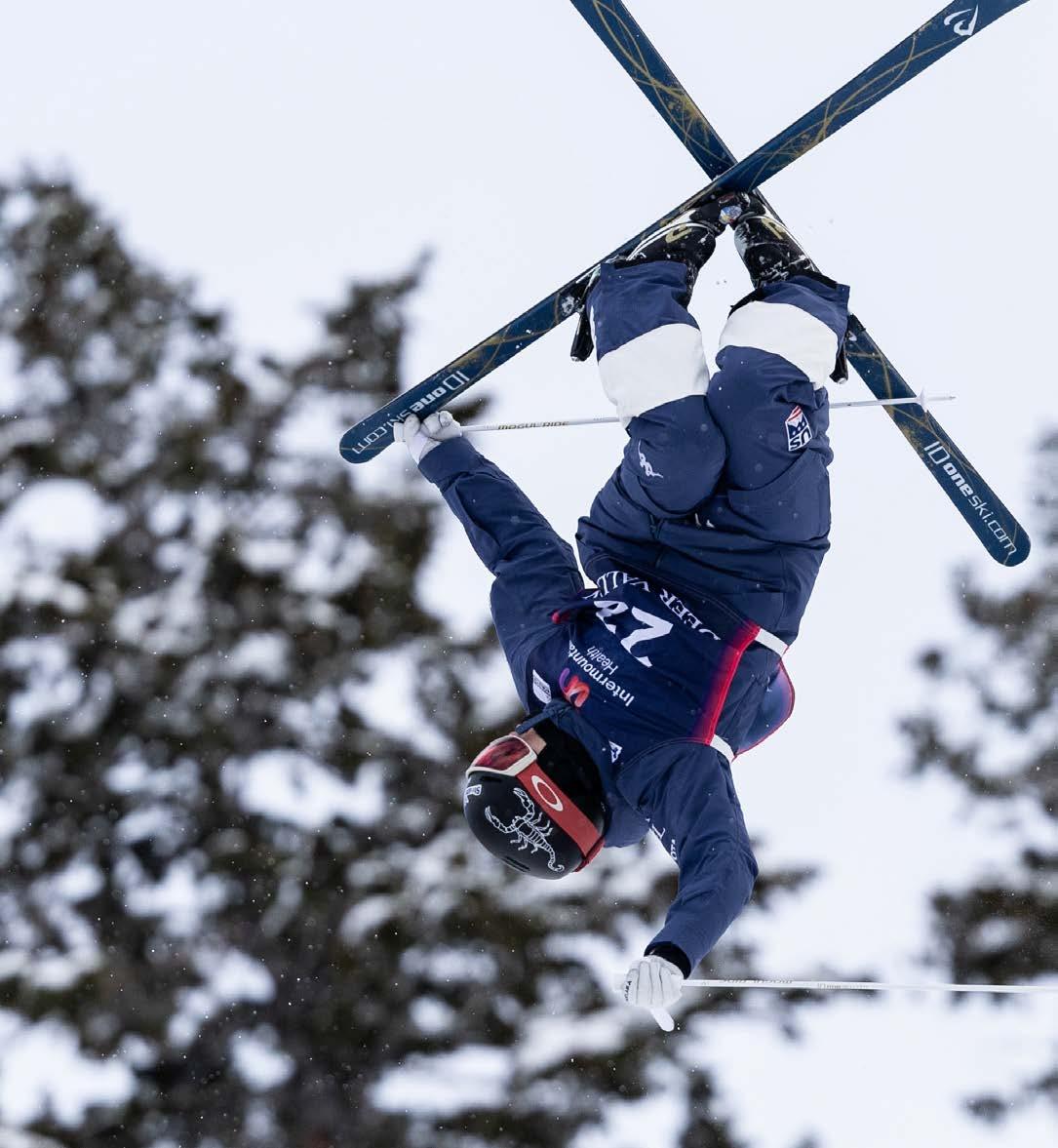
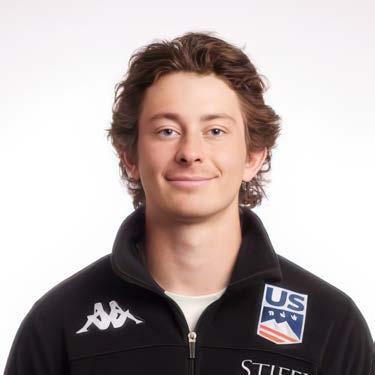
have been a part of Landon Wendler’s life for as long as he can remember. He grew up in Steamboat’s Nordic combined and freestyle community, clicking into skis at just 5 years old. “This mountain raised me,” he says. “Steamboat is where I learned to love skiing and where the dream really started.”
His Olympic spark was lit at 14, right before the Games, when Brad Wilson and Patrick Deneen came to Steamboat for a training camp. “They had all their gear and they took pictures with us,” Landon remembers. “It opened my eyes to where the sport could take you.”
That dream quickly grew into a career. Landon worked his way up through the NorAm circuit with the Steamboat Springs Winter Sports Club before breaking onto the national stage. A fourth-place finish at Junior Worlds and a World Cup debut at Deer Valley put him in the spotlight. By 2020, he had qualified for the U.S. Ski Team, just missing the Olympic year by the narrowest of margins.
Instead of stepping away, Landon pressed forward, joining a club team in Utah and earning more World Cup starts. He placed fifth in Kazakhstan, then returned to the podium with a third-place finish – proof he belonged among the world’s best. But just as momentum was building, disaster struck: an ACL tear in Sweden.
“That first surger y and the PT after was a grind,” he says. “At first it was just golf and hockey, then back on the water ramp, and finally snow again. Going back to Chile in October to train was amazing.”
These days, Landon is one of few men on the U.S. moguls team, a unique experience he describes as both challenging and rewarding. “We’re traveling the world with good friends, competing against each other,” he says. “Every couple of years people leave and new people come in, and it’s cool to meet new teammates along the way.”
The path hasn’t always been straightforward. One of his hardest moments came in 2022, when he lost his team spot. “I took two months to reflect and decided that I didn’t want to
give up on it, even though I’d lost my status and confidence,” he says. “I knew I had to go all in. Old coaches and teammates reached out and said, ‘Please don’t quit.’ That support kept me going.”
Training for the Olympics, he explains, is an all-year grind. “Even in a non-Olympic season, people are working as hard as they can. When the Olympic season comes, the thought of the rings is constantly in your head – it fuels the workouts and drives you more. It’s a big push mentally, physically and emotionally, but that’s why we keep going.”
“This mountain raised me. Steamboat is where I learned to love skiing and where the dream really started.”






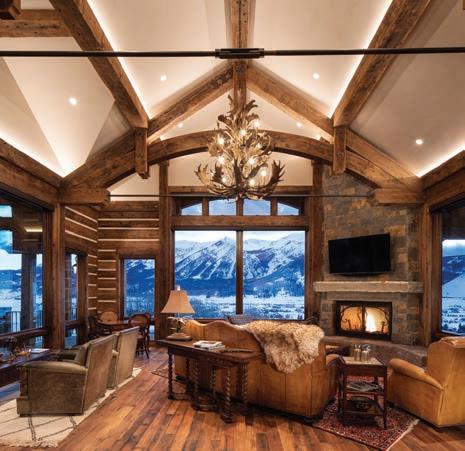


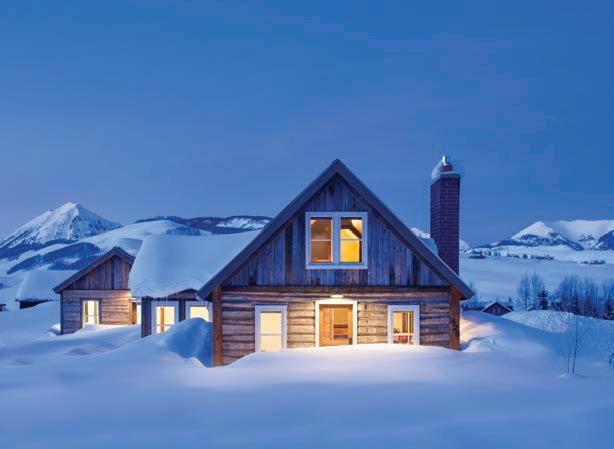


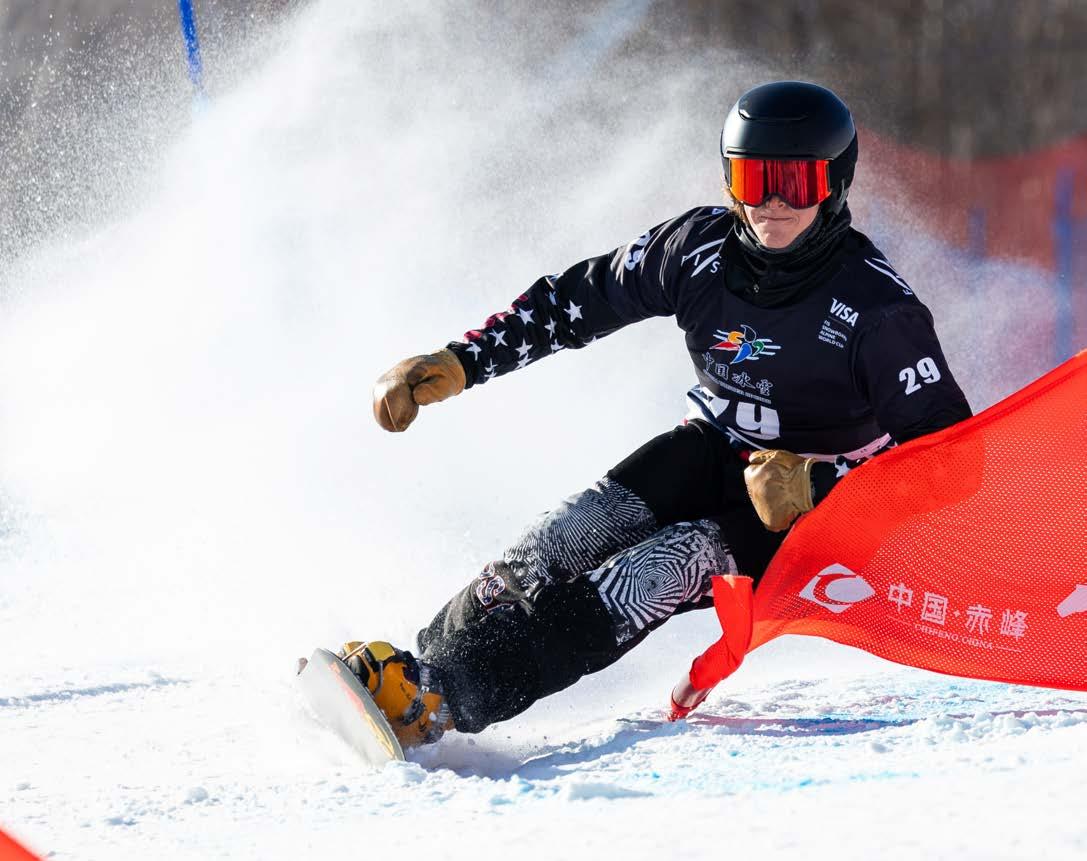
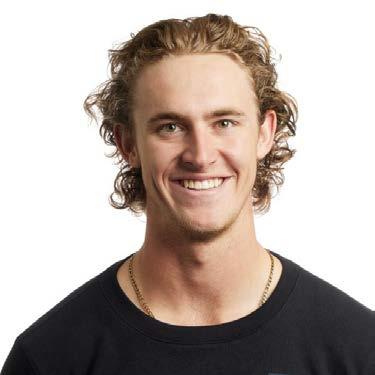
ForCody Winters, life runs on two seasons. In the winter, he’s living out of a suitcase, chasing snow across four continents and racing around the world on the World Cup tour. In the summer, he swaps his snowboard for a squeegee, running his company, Winters Window Washing. “I just wrapped up my seventh summer in business,” he says proudly. “Turns out being able to clean a window is a lot more profitable than being able to rail a carve.”
Cody’s love for snowboarding started early, long before he ever strapped in. His parents made him ski a black diamond run before they’d let him switch from skis to snowboard – and he vividly remembers being jealous when his older brother graduated first. “Some would say I fell in love with snowboarding before I even did it,” he laughs. Old home videos confirm it –his eagerness and joy on those first few days were undeniable.
By the time he was a teenager, the Olympic dream was taking shape. Watching snowboard cross at the X Games lit a fire. “The course was massive and dangerous, and I told my parents I wanted to do that someday,” he recalls. It felt out of reach at first, but the spark was there.
That dream came with sacrifices. After graduating high school in 2018, Cody stayed in Steamboat to chase snowboarding while most of his friends
“Humor is my weapon of choice. Me and my teammates joke around and talk trash until the last second before the start gate.”

headed to college. “I questioned if I made the right choice,” he admits. “But I promised myself I’d give it four years to try and qualify for the 2022 Olympics. That decision pushed me into my best season yet.” It worked – by 2019, he had earned his spot on the World Cup tour and in 2022, he competed in the Beijing Olympics.
On race days, Cody keeps it light. “Humor is my weapon of choice,” he says. “Me and my teammates joke around and talk trash until the last second before the start gate.” Balance comes in the form of meditation and breathing exercises – “a mix of inner peace and inappropriate jokes.” And then there are the socks. “If I do well in a certain pair, they’re race socks until the magic runs out.”
Snowboarding has taught Cody lessons that go beyond results. “People don’t actually remember what place you got – they remember how you made them feel. Some days you win, some days you learn.”
If he could talk to his younger self, the message would be clear: relax. “You’re your own biggest critic. Nobody’s watching as closely as you think. Go after your goals one step at a time and enjoy the ride. You’re literally on a rock floating through space – none of this is that serious.”
As for legacy, Cody wants to be remembered not just for his results, but for his spirit. “I hope people see that I competed because I genuinely loved snowboarding. I want to be known as the Swiss Army knife of snowboarding – versatile. More than anything, I want to inspire the next generation to chase their passion instead of settling for ‘normal life.’”



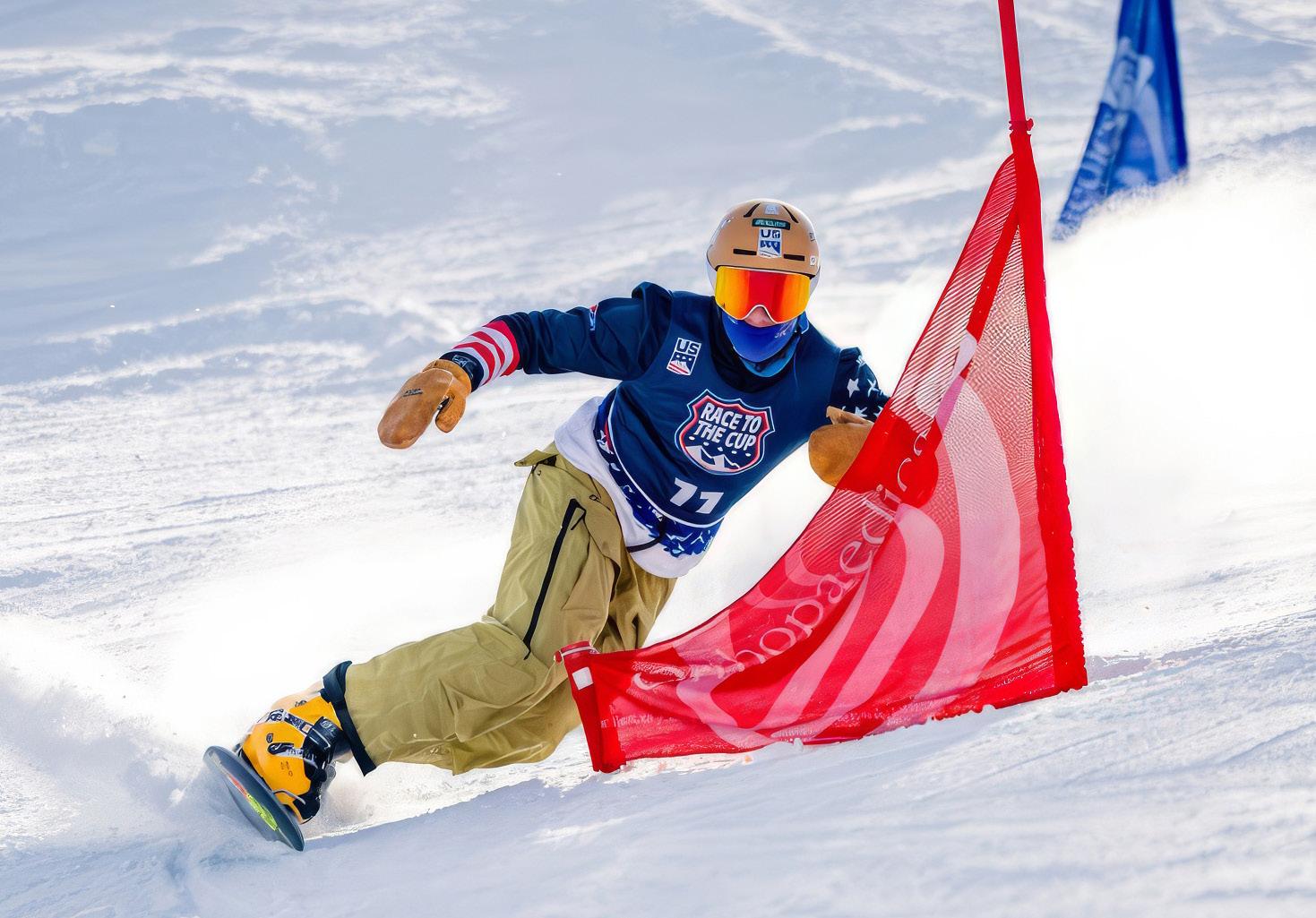
Asis not uncommon in Steamboat Springs, Walker Overstake started snowboarding when he was 3 years old. What was uncommon was the snowboarding part; Walker is from a family of skiers. His grandmother, Petie VanEveren, started the ladies ski program at Eldora Ski Area decades ago. “This resulted in Petie influencing and encouraging countless numbers of skiers to fall in love with the sport of skiing – not snowboarding,” Walker’s father, Ryan Overstake, points out. “No one else in our family snowboards; there was some pressure and expectation to ski.”
It was Walker’s babysitter, Jessica Wearren Olsen, who took him out snowboarding. While he did both ski and snowboard for a while, Ryan remembers that over the years, Walker was determined to snowboard – so that’s what he did.
His standout season came last winter when he won the NorAm Cup, got fifth place at the World Junior Championships and had four World Cup top 30 finishes. It wasn’t all smooth boarding though. “At the beginning, my mindset was lacking a performance-based focus, meaning I was more set on winning rather than performing at my best by focusing on specific objectives,” Walker explains. This resulted in mostly poor finishes. But as Walker worked to improve his mindset – doing extensive sports psychology work – his riding quickly followed and the results started to show. “My momentum was driven by

two main things: grit through passion for the sport, and celebrating every growth in a very confident way,” he says.
Last winter, he accomplished nearly all the goals that he set. Even so, when his coach told him that he had a shot at the 2026 Olympics, Walker was shocked. “I always knew I had the potential for the Olympics at some point, so that wasn’t what shocked me – it was more the realization that I had the potential for the immediate Olympics in Italy in 2026,” he says. “I was filled with euphoria and a mixture of nervousness and excitement. I was scared, stoked and felt like it wasn’t real.”
But it was real; so Walker did the next logical thing and kept training. Last summer, he lifted weights with his strength coach, Jeff Thompson, four days a week beginning at 6:30 in the morning. He added in field cardio and plyometric training two days a week for two hours a day. And he did anywhere from three to six bike rides per week. It was all to prepare him for camp in El Colorado, Chile where he found himself for six weeks in August and September, training alongside some of the best athletes in the world.
In the winter months leading up to the Olympics, Walker will be on the World Cup circuit again, which will ultimately determine his Olympic path. The advice that he takes with him is from his mother, Heather: just do your best. “It sounds simple, but it means so much,” Walker says. “To me, it means all I need to do is what I do, and that’s when I perform my best.”
“I see the progress I’ve made, and that keeps me going.”
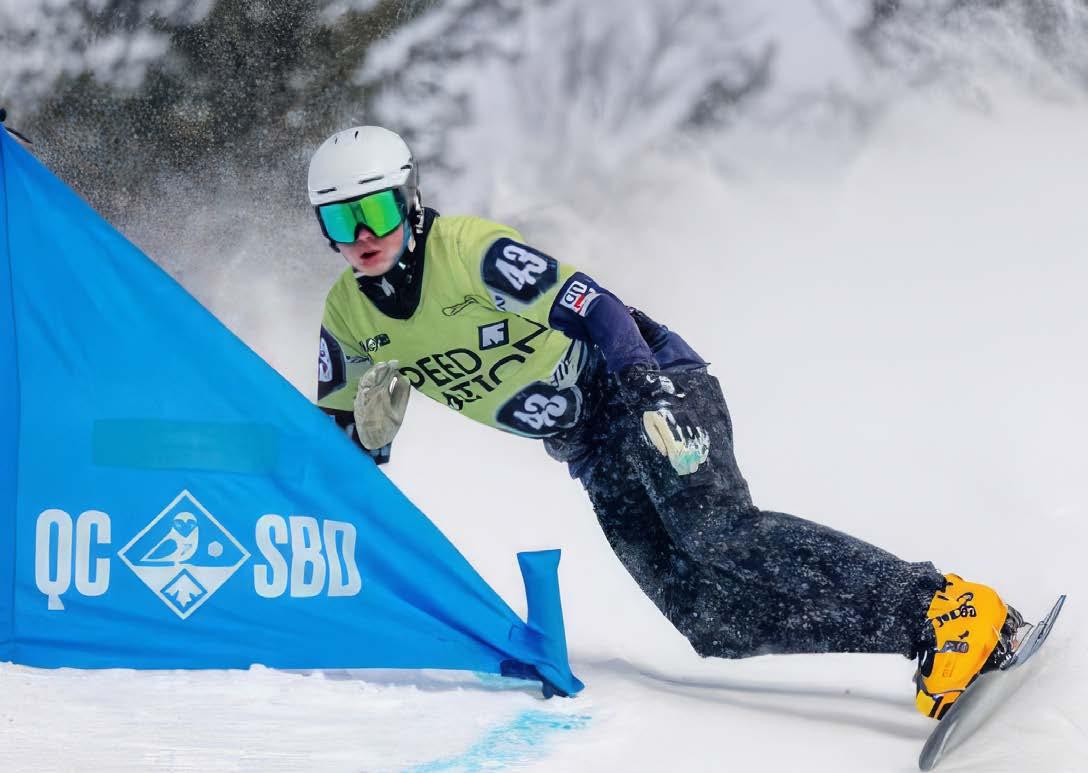
SamCarpenter has had a wild ride. In 2019, the ski racer-turned-Alpine snowboarder moved to Steamboat Springs, where he trained with an international coach. It was a decision that shaped his future, guiding him towards the Olympics. Born in the U.K. but raised mostly abroad, Sam now proudly represents Great Britain on the slopes, chasing big goals like the Olympics while celebrating milestones along the way, like finishing seventh at Junior Worlds last year. Calm under pressure and always focused on progress, Sam’s story is about resilience, passion and competing because he loves the sport – not just for the medals.
Steamboat Magazine: When did the Olympic dream first take root for you?
Sam Carpenter: Honestly, every athlete dreams of the Olympics. For me, it’s always been the goal, right from the start.
SM: Has there ever been a time you thought about walking away?
SC: Definitely. In high school, a lot of kids had already started before me, so I’ve always felt like I was on the back foot. I’ve never had that sense of, ‘Oh, I’ve made it.’ That’s been hard

emotionally. But when I step back, I see the progress I’ve made, and that keeps me going.
SM: You’re now representing Great Britain. What has that experience been like?
SC: I was born in the U.K. but moved when I was 6. The decision to represent Great Britain came because I felt I could make a bigger impact there. It’s been an honor to carry that flag and help push the sport forward.
SM: What’s been your proudest moment so far?
SC: Placing seventh at Junior Worlds last year. That result showed me I can compete at a high level and it gave me confidence to keep pushing.
SM: How do you handle nerves or pressure in big competitions?
SC: I pride myself on staying calm. For me, it’s just another race, and that mindset helps me perform my best.
SM: If you could give advice to your younger self, what would it be?
SC: Keep going. Put in all the effort you can. Don’t chase a medal just for the medal – do it because you truly want to.

Everyoneloves a comeback story. Maddy Schaffrick’s is a good one. She was born and raised in Steamboat Springs, and began skiing at age 2. She started snowboarding at age 7 after watching the X Games on TV. By the time she was 14, she was on the U.S. team for snowboard halfpipe. After three years on the rookie team, she moved up to the U.S. Pro Team for four years.
And then: burnout. At the age of 20, she retired from the sport.
“I was having a great time traveling the world,” she says, “but I was also trying to live in an adult world at a very young age, and I don’t think I really had the maturity or the perspective or the mental skills to handle it.”
Her next move was to return to Steamboat and become a plumber. “I learned that I don’t want to be a plumber,” she adds drily.
During her first winter back in Steamboat, Maddy volunteered for the Steamboat Springs Winter Sports Club (“mostly for the free ski pass”) where she coached 7- to 9-year-old snowboarders – the same age that she was when she fell in love with the sport. “Within a week of working with them, I was reconnecting with my love for snowboarding in a way that I had lost,” Maddy says.
The following winter, she decided to work with SSWSC full time, as the head junior and senior team snowboard coach, working with competitive athletes, ages 9-19, doing regional events in all disciplines. “Starting to coach was the start of my healing process from my professional career,” Maddy says. “I think working with the kids, especially the ones who were just starting to compete, helped me reflect on my own experiences and also reframe the industry and competition in a way that was more healthy.”
For the next few years, Maddy continued coaching with SSWSC and eventually took the role of snowboard program director. It was a role that helped her see the industry in a new light. “When I left, I had a lot of resentment and placed a lot of blame on the industry just because I was young and didn’t know how to take accountability,” she says. “And I also kind of felt like competition had ruined this really good thing that I loved.”
When Maddy took a job with the U.S. team as the assistant pro team coach for snowboard halfpipe, she was launched back into the World Cup circuit and the intense professional environment of snowboarding. “It gave me so much reflection and insight to what I had experienced before and what led to my burnout,” she says.

That’s when a seed was planted – she knew she had more to give. Could she do it all over again? She had just turned 30. “I wasn’t old by any means, but I’m on the older end of competitors,” she points out. But she also knew what regret feels like. “Sometimes you don’t realize what you could have done differently until you step out of it,” she says. “I knew that if I could physically perform and do what’s required of me, then my soul needs to do this.”
Now, Maddy is an Olympic contender, with qualifying rounds that begin in December. Over a decade after she quit the sport, a chance to compete in the Olympics would mean the world. “It would mean a lot in a way that I can’t really describe,” she says. “What’s different this time – besides believing in myself and being connected to my purpose – is that I’m way more focused on the journey rather than the outcome. I’m looking forward to enjoying the experience and finding the joy in being a professional snowboarder. I wasn’t connected to that joy before … because it’s a choice to feel joy or find joy in the grind of it all. When I make it to the Olympics, I want to remain connected to that joy and do everything I can to put the pieces together when it counts.”


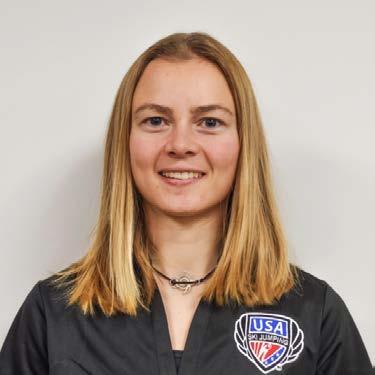
ForAnnika Belshaw, ski jumping is more than a sport –it’s a pursuit of flight. Three years ago, she moved to Norway to immerse herself in one of the world’s strongest ski jumping cultures. Training alongside Norwegian athletes and coaches, she’s sharpened her technique, pushed her limits and found her place in a demanding sport where balance, passion and perspective are everything. With her eyes on the highest level of competition, Annika continues to carve her path, fueled by the same adrenaline that first made her fall in love with flying.
Steamboat Magazine: Tell me about your journey in the last few years.
Annika Belshaw: Three years ago, I moved to Norway to train with Norwegian coaches and athletes. Being part of that team has given me access to advanced training and a deeper knowledge of the sport, and it’s really pushed me forward.
SM: Can you tell me the story of how you first fell in love with your sport?
AB: For me, it was always about the flying aspect. That feeling of soaring through the air – the adrenaline – that’s what hooked me right away.

SM: What was the moment you realized that you wanted to go to the Olympics?
AB: I wouldn’t say I had one specific moment. My goal has always been to be the best, and that naturally includes competing at the highest level, which means the Olympics.
SM: Was there ever a moment when you thought about quitting? What kept you going?
AB: Yes, there have been times. For me, it’s always come down to balance – it’s either all in or nothing. Finding that balance has kept me in the sport.
SM: What does competing at the Olympics mean to you?
AB: It would mean a lot. Representing my country and my hometown would be incredible. But beyond that, it brings visibility to ski jumping, especially women’s ski jumping, which is really important for the growth of the sport.
SM: Do you have any pre-competition rituals or superstitions?
AB: Not really, but I always brush my teeth before a competition.
SM: How do you deal with nerves or pressure in high-stakes competitions?
AB: I try to treat competition like training and training like competition. Visualization helps, too. In competition, I don’t really get nervous – I get more of an exciting feeling.
SM: What advice would you give your younger self?
AB: Try to enjoy the process.
SM: How do you hope to be remembered as an athlete?
AB: As someone who was supportive of my teammates and passionate about ski jumping.
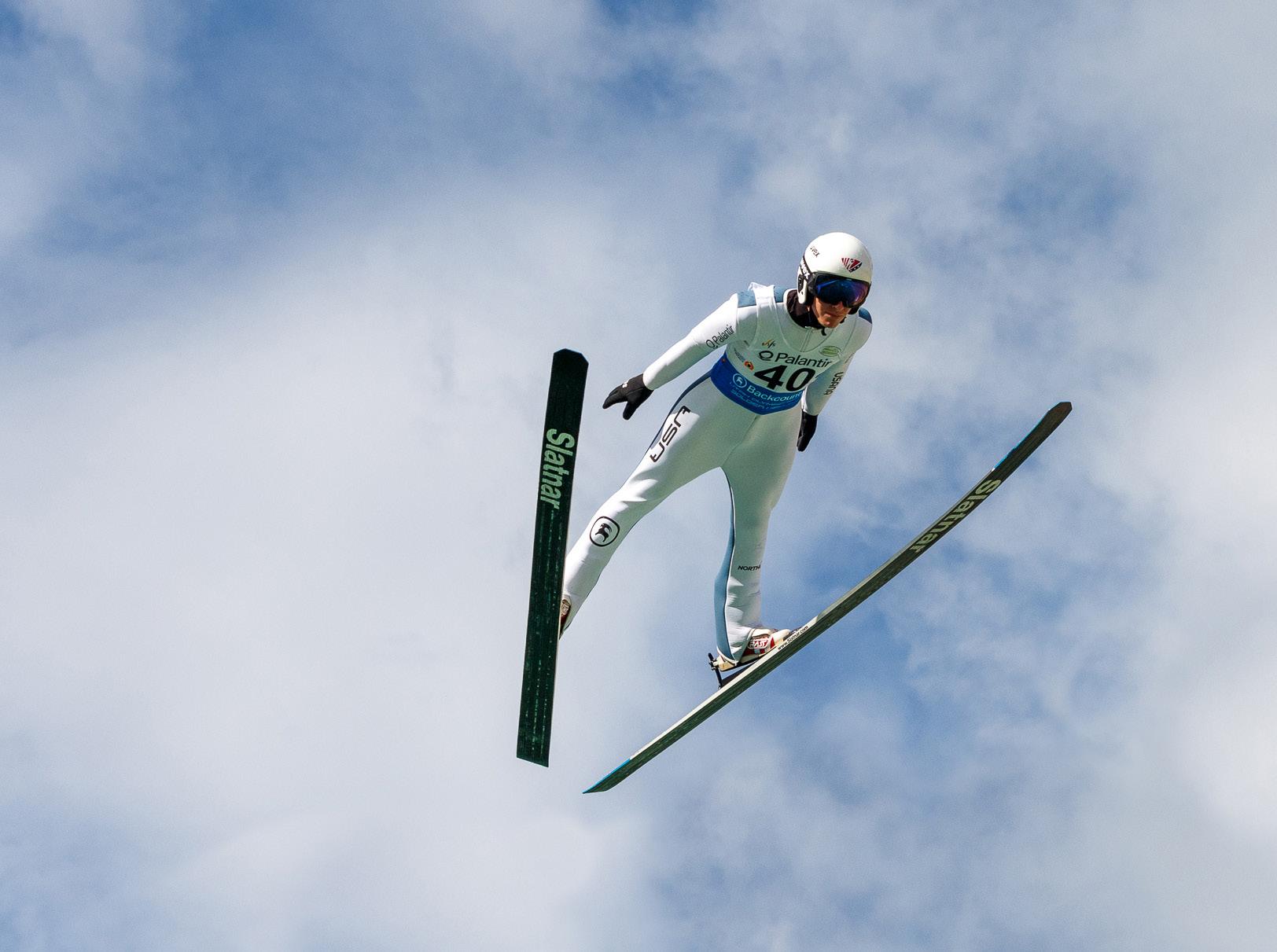

Atjust 25 years old, Decker Dean is already a seasoned competitor on the international ski jumping stage. A Steamboat Springs local, Decker made his Olympic debut at the 2022 Games in Beijing and is now eyeing a return in 2026. Nicknamed “The Jumping Machine” by his friends, Decker brings a mix of athletic grit, technical focus and laid-back energy to the sport. Whether he’s training in Trondheim, Norway, or carving trails on his mountain bike, Decker is all in on the journey.
Steamboat Magazine: What does a typical training week look like as you prepare for the 2026 Winter Olympics?
Decker Dean: A typical week really depends on the time of year. In the summer, my training load is much heavier – it includes a lot of gym work, ski jumping sessions and testing different equipment like skis, boots and bindings. As winter approaches, we scale back the volume and start focusing more on small details, making sure the body is ready for the long season ahead.
SM: What are you currently working on – technically or mentally – to get competition-ready?

DD: Right now, I’m putting a big emphasis on mental work. Bringing the same jumps from training into competition can be really tough and mentally demanding. Technically, I’m focused on the early phase of my flight – trying to create more surface area and be “bigger” in the air.
SM: How do you handle nerves or pressure during competition?
DD: It really depends on the situation. When I’m in a good flow, it’s easier to treat a competition just like another training session and stay focused on the task at hand. I also practice a lot of breathwork and meditation daily, which helps me lock in and stay calm during events.
SM: Beyond results, what’s your ultimate goal for the upcoming Olympics in Cortina?
DD: If I make the team for Cortina, my biggest goal – aside from results – is to really enjoy the full Olympic experience. Beijing was cool and interesting, but due to Covid, we as athletes missed out on a lot. This time, I want to soak in everything the Games have to offer.
SM: What’s it like to train abroad, and where do you typically train?
DD: I basically live full-time in Trondheim, Norway, and train there. I’ve really come to love it – it’s finally started to feel like home, which hasn’t always been easy as an athlete constantly on the move.


jason colby Nordic Jumping

“Be patient, not everything comes all at once. A lot of good things take time and you have to let it develop and grow.”
Ski jumping runs in Jason Colby’s family: It was introduced to him by his father and uncle and quickly became more than just a pastime. As he heads into the 2025-26 season, Jason reflects on his journey from his early days on the jump to competing on the world stage, sharing insights on perseverance, mindset and the lessons learned along the way.
Steamboat Magazine: Can you tell me the story of how you first fell in love with your sport?
Jason Colby: I got introduced to it by my dad and my uncle, they were ski jumpers and so it’s a family heritage.
SM: What was the moment you realized, “I want to go to the Olympics?”
JC: I don’t know if it has happened yet. It would be a privilege to represent the U.S. in the Olympics. But my other goals are geared towards the World Cup and producing results there.
SM: Was there ever a moment when you thought about quitting? What kept you going?
JC: A little bit, right after high school I thought about just going to college and living a “normal life” but the opportunity was there and fortunately I scored my first FISC cup point and that has led to where I am now. I joined the national team right after high school, so I was super lucky to have that opportunity.
SM: Do you have any pre-competition rituals or superstitions?
JC: No, just trust in the preparation.
SM: What’s one thing you wish you knew when you started?
JC: It’s a good 90% mental; the foundations of a ski jump are super simple, it’s just a matter of doing it all in sync at the same time.
SM: How do you deal with nerves or pressure in high-stakes competitions?
JC: That’s something I have to definitely get better at. It’s about focusing on the task at hand and trying your best.
SM: What advice would you give your younger self?
JC: Be patient, not everything comes all at once. A lot of good things take time and you have to let it develop and grow.

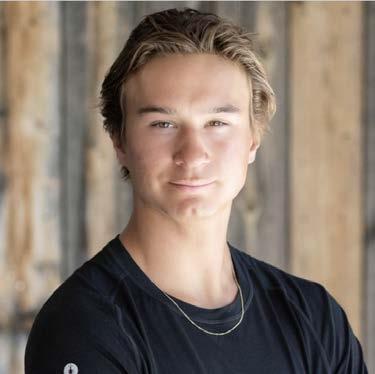

NiklasMalacinski wants to join the ranks of great Steamboat Springs Nordic combined athletes like Johnny Spillane, Bill Demong and Todd Lodwick. He’s on his way: He qualified for the 2021 and 2023 U.S. World Championships teams, and he earned his first U.S. National Championships win in 2024. He began the 2024-25 season with a personal-best 13th-place finish at the World Cup in Ruka, Finland, and finished the season ranked No. 26 in the world. Despite these results, Niklas missed a spot on the 2022 Olympic team. Now, he’s looking ahead to Italy with determination, hope and a new perspective. He shares his thoughts with Steamboat Magazine.
On not qualifying for the 2022 Olympics in Beijing
It took me a while to get out of the whole headspace of disappointment because that was a huge check point for me – of being on the right track to meet my goals. There is so much weight to the name of the Olympics and being a senior in high school then, that would have been the absolute dream. It took me a while, but after about six months, I started to get over the disappointment. I would say that’s shaped how I look at disappointment nowadays. Now I’ve learned to let go of results that don’t go my way – or anything else in dayto-day life. I worked with a lot of sports psychologists, and I was really able to change the perspective of learning from that experience rather than looking back on it and regretting it. Every day I learned to accept it a little more and with the acceptance of it, I began to learn how to manage those emotions.
“There’s more to it than just an accomplishment. This lifestyle and the philosophy of sport has taught me so much when it comes to life.”

On what he would do differently this time around Last time around, I made a mistake of putting too much trust into coaches and trusting the coach to tell me what’s best. While in a perfect world I would have that, I didn’t have that in the Olympic year and it was really hard for me. But it taught me to take ownership of my own career and to know what steps precisely I need to take for myself. I was 18 years old so I hadn’t had a lot of experience in taking ownership of what’s the best path forward. That’s what I’ll be doing going into this Olympics. I’m going to be a lot more selfish to make sure I have the best opportunities to be the best I can possibly be.
On training leading up to the Olympics
On an Olympic year, a lot of athletes change things and really focus up and go after it. But that can lead to a lot of disappointment – when you change things. My main project for this year has been consistency. I’ve been on the right path and I think when things click, I think that the same things that I’ve always done will work out best. There’s a lot of intention going into this season.
On his sister, Annika, who is also a Nordic combined athlete
With siblings there is a lot of competitiveness. It’s a nice way to have someone pushing you at all times even when you’re at home and your teammates aren’t around. It kind of brings the training camp mindset home. We see each other do our own routines and get some motivation.
On accomplishment
There’s more to it than just an accomplishment. This lifestyle and the philosophy of sport has taught me so much when it comes to life. The environment that I get to be in and the amount that I travel – and just my whole career up to now – is such an accomplishment to me. I’m so proud of what I have. I wouldn’t want to pick out one particular thing because I’ve had some amazing results in my career as a whole.




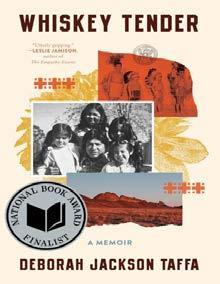
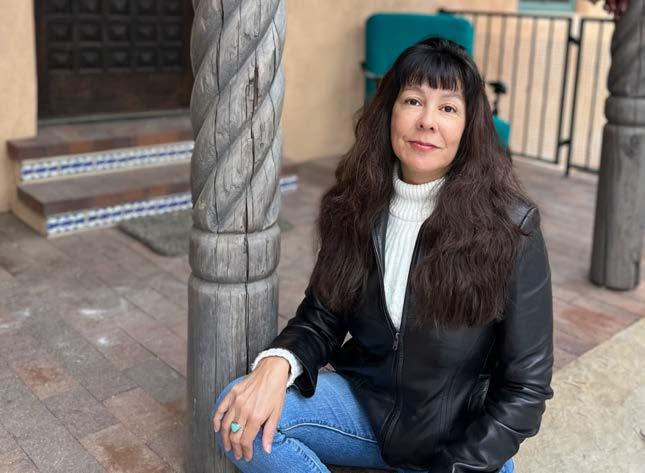
| BY JENNIE LAY
Author Deborah Jackson Taffa is a citizen of the Quechan (Yuma) Nation and Laguna Pueblo, and she is director of the Creative Writing Master of Fine Arts program at the Institute of American Indian Arts. Her debut memoir, “Whiskey Tender,” was a National Book Award finalist and is this year’s One Book Steamboat community read.
“Whiskey Tender” is a coming-of-age memoir that weaves together an essential regional history. And while Deborah emphasizes that Native country is not a monolith and memoir is not general nonfiction, she reminds us that, “Readers are paying for your subjectivity, your personal experience, the way it wounded you specifically. There is also artistry in how you put it together, rendering the way something was said 20 years ago, for example, is always a leap of the imagination.”
In the process of telling her family stories, Deborah wound her way through memory, research and evolving perspectives from different generations. “I have relatives on the left and the right. It’s okay for us to have narratives and counternarratives. It’s a healthy body of literature when cultures voice their differences,” she says. “My grandparents’ generation created the Congress of American Indians. They believed in change through legal measures. My father, uncle and aunts’ generation didn’t believe the courtrooms were in good faith, so they took a more militant approach to injustice via the American Indian Movement.”
Below is an excerpted conversation with the award-winning author, who will be visiting Bud Werner Library in February to lead a memoir workshop and talk about her writing. She and her husband will also fulfill a dream to finally ski Steamboat (with big wishes to experience that legendary champagne powder)!
Jennie Lay: “Whiskey Tender” feels like both a personal memoir and a vital account of our national history. What sparked or inspired you to share your story in this way?
Deborah Jackson Taffa: As a young student in school, Southwestern histories were rather ignored. My teachers focused primarily on Plymouth Rock and the east-to-west trajectory of Manifest Destiny, but for many of us in the Southwest, our personal lineages ran south to north. The Americas are an
Indigenous stronghold. Alta California, or the western United States, is rarely referred to as a Spanish colony, and the history of the various tribal nations, distinct in their languages, arts, culture and beliefs that preceded Spanish colonialism are even further ignored. There was no way to grow up in this country without feeling slighted by the erasure of my people, most especially their love and stewardship of these mountains, deserts, rivers and valleys we call home. They cared for this land better than any government or culture that has followed. As a young kid, and as a writer, it felt important to counter the mainstream story. I want all Americans to remember my ancestor’s sacrifices and contributions. This means I will never stop remembering, and I will never stop reminding people how many Natives in our region were killed and enslaved via invaders from the south, not the east. A country that does not know its own history is a country destined for doom.
JL: Did you know at the start that you needed to tell the broader story to tell your own?
DJT: I started as many memoirists start, from a place of confusion about my inheritance. Writers are rewarded by digging into family mysteries, hidden patterns and unexplained dynamics. I wanted to understand my childhood, which was raucous and fun loving, but also violent. I needed to know my place in the U.S. and decide how I could interact with the American Dream in a way that felt like it honored my ancestral values. It was only after the pages began to multiply that I understood my personal story was collective, that many people had lived my experience; that it was a uniquely American story.
JL: In addition to stories passed down from your family, what kinds of research – archives, oral histories, interviews – did you pursue for this book?
DJT: I lived in southern California, on the Yuma Indian reservation, in my late 20s. I was already interested in writing a book at that point, so I spent a lot of time in the archives at the Arizona Historical Society, at the Yuma Landing and in the Kwatsaan-Yuma Nation Museum on Indian Hill. My grandfather’s sisters were still alive at that point. Most of them were in their late 70s and early 80s, so I sat on their porches with them and gathered oral histories. A decade later, when I was studying at the University of Iowa to earn my MFA, my parents flew in for a visit and we went into the radio lab, where I recorded approximately 18 hours of interviews. All this was central to my telling.
JL: Did the process of researching and writing a memoir alter any of your understandings of yourself, your cultures or politics more broadly?
DJT: Absolutely. I understood, finally, how unfair I had been to my father, to his entire generation of Native men really, most of whom were manual laborers working in coal mines, coal-fired power plants and the oil fields. I was very bratty for a kid who was given the opportunity to go to private Catholic schools. I acted like he and his Navajo/Diné coworkers had chosen polluting industrial jobs. Rather, they were funneled into dirty work by the Indian Relocation Act. They took those jobs so their kids wouldn’t starve. There were other ways as well in which I grew through the research and writing of this book. I came to appreciate the contributions my ancestors made to this country. They believed in democracy, even as they were not always treated fairly. I came to see how many U.S. politicians through the years fought on our behalf. There were always good people in government. Sadly, they were usually outnumbered by greedier factions.
JL: How did you parse which family or community stories were yours to tell, and how did you (or did you have to?) navigate responsibilities to your Laguna Pueblo and Quechan Nation?
DJT: For me, the book was written for future generations. If I’d had a book like this to read as a child, if I’d known it was normal to feel pain and shame and worry over how to fit in as a Native American, I would have felt less alone. I’m an elder now. I waited a long time to write this book out of respect for my own elders. If I can’t speak for myself (and I’m not speaking for all Laguna Pueblo and Kwatsaan-Yuman people) at the age of 56, when will I be ready to speak? To be clear, it was terrifying to think that I might disappoint anyone, particularly because my family is so well known on both of my reservations. (My uncle Mike Jackson was the president of the Yuma Nation for 12 years, and my grandfather was before him. My uncle John Antonio was Laguna Pueblo governor in the 2000s, and my uncle Harry Antonio is governor now.)
JL: You are working intensively with so many young Native writers – it’s exciting! Is there a new, distinct kind of storytelling we should look for from these writers? Something old or new?
DJT: There are a lot of intersectional stories. There are stories that come from tribal nations that don’t yet have a book on the shelves, which is exciting. We are seeing a lot of hybrid forms





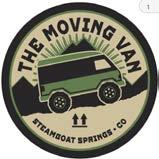

in poetry. Some of the alumni with recent sales include Lena Jawdat, Leah Altman, Chantal Rondeau, Jake Skeets and Ibe Liebenberg, to name a few.
JL: Did writing this book change your relationship to memory, making you trust your memories more or less?
DJT: The more you write, the more you remember. But many of the earliest drafts for this piece were written when I was in my 20s. I have piles of drafts, some of them written in pencil and/or pen. If I hadn’t written those drafts when I was young, soon after I left my parent’s house, I don’t know if I could have remembered all the details you find in the book. My second book, in progress, is the same way.
JL: Where and when did you learn to ski? Do you have an early memory to share?
DJT: My father took us to Purgatory in Durango, Colorado, when I was 9 years old. I hated it. He rented us skis and sent us up the hill alone. I maintained this rather judgmental attitude about downhill skiing until I met my husband, who grew up going to summer ski school in the Alps around his hometown of Milan. He insisted I learn when I was in my late 20s and I never looked back.
Meet the author and more. Learn about Steamboat’s community read, including a winter series of films and conversations featuring Native voices at Bud Werner Library, culminating in Deborah Jackson Taffa’s memoir workshop on Monday, Feb. 23, and her community book talk on Tuesday, Feb. 24. www.steamboatlibrary. org/events/one-book-steamboat.
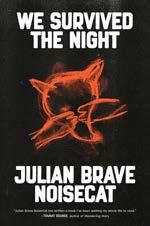

Sundance-winning filmmaker, champion powwow dancer and debut author Julian Brave NoiseCat will visit Steamboat for a two-night visit at the library that includes a screening of his Oscar-nominated documentary, “Sugarcane,” and talk about his new book, “We Survived the Night.” And of course, he’s planning to snowboard, too. NoiseCat is a proud member of the Canim Lake Band Tsq’escen and a descendant of the Lil’Wat Nation of Mount Currie. Bestselling author (and newly minted MacArthur Genius Award recipient) Tommy Orange, says, “‘We Survived the Night’ reads like a novel. Told with a blistering honesty, the truth and grit create a beautifully woven coyote story we haven’t heard before ... With this, Julian Brave NoiseCat has written a book I’ve been waiting my whole life to read.”
“Sugarcane” screens on Monday, Feb. 2, and “We Survived the Night” book talk is Tuesday, Feb. 3, both at Bud Werner Library.
Two-time 17-Across | BY VICTOR FLEMING © 2026
Across
1 Itsy-bitsy bits
6 “Come here ___?”
11 With 5-Down, entity for which 59-Across served as an analyst
14 Company
15 The Hobbit hobbit
16 Mudder’s morsel
17 With this puzzle’s title, term to describe 59-Across
19 Org. for solicitors?
20 Right-angle bend
21 Despicable
22 C oll. major
23 Houston baseball pro, slangily
24 ___ potatoes
26 Be a bad houseguest
29 Designer’s concern
31 O ld camera contents
32 L ively and active
34 Synthe tic fiber
38 Sport that 59-Across is known as the “father” of
41 “L eda and the Swan” poet
42 Ill-considered
43 Sub commander of fiction
44 Alaskan’s domed home
46 Nissan compact SUVs
48 “ We ___ please”
50 S ome young ‘uns
51 Blackthorn
52 O bjects that are considered novel or bizarre
55 Singer Lee ___ Womack
58 Milk dispenser
59 This puzzle’s honoree
61 Alicia of acting
62 Assortments
63 Bouncy cadences
64 Grown boys
65 Disorganized
66 Beethoven dedicatee Down
1 ___ Jur y (Mickey Spillane classic)
2 Grad-school exam
3 K ind of booth
4 You’ve Got Mail ISP
5 S ee 11-Across
6 “... it ’s ___ work we go”
7 Campus group, briefly
8 Big book
9 L ike the perfect place
10 Here-there link
11 What thousands who’ve competed in 38-Across call 59-Across
12 Hindu gentleman
13 C omedian Laurel
18 Hansel and Gretel locale

access to provider, in person/text/video
co-pays for visits
Acute care
or at cost prescriptions and labs
person wellness care
22 Pair of studs, e.g.
23 Occasional
25 Get by with reasonable comfort
26 Far from certain
27 Bog stuff
28 Guilt y or not guilty
29 1964 Tony Randall title role
30 Gives a onceover
33 Fire fanatic, briefly
35 In ___ of
36 Treater’s phrase
37 Many charities, for short
39 C ertain Army N.C.O.
40 Pizza topping unit, slangily
45 Neighborhood
47 At a discounted price
48 Home ___
49 Ames resident
50 Hardly the macho type
51 Many a carnival game
53 Topaz author Leon
54 S ome bygone theaters
55 “... for ___ care!”
56 Table tennis dividers
57 Wall St. initials
59 L ap dog, casually
60 ___ Abner comic strip)
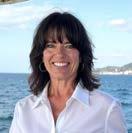
| alove@lovewellnessltd.com
Call or Text to book an appointment
Offices located in Hayden & Steamboat www.lovewellnessltd.com

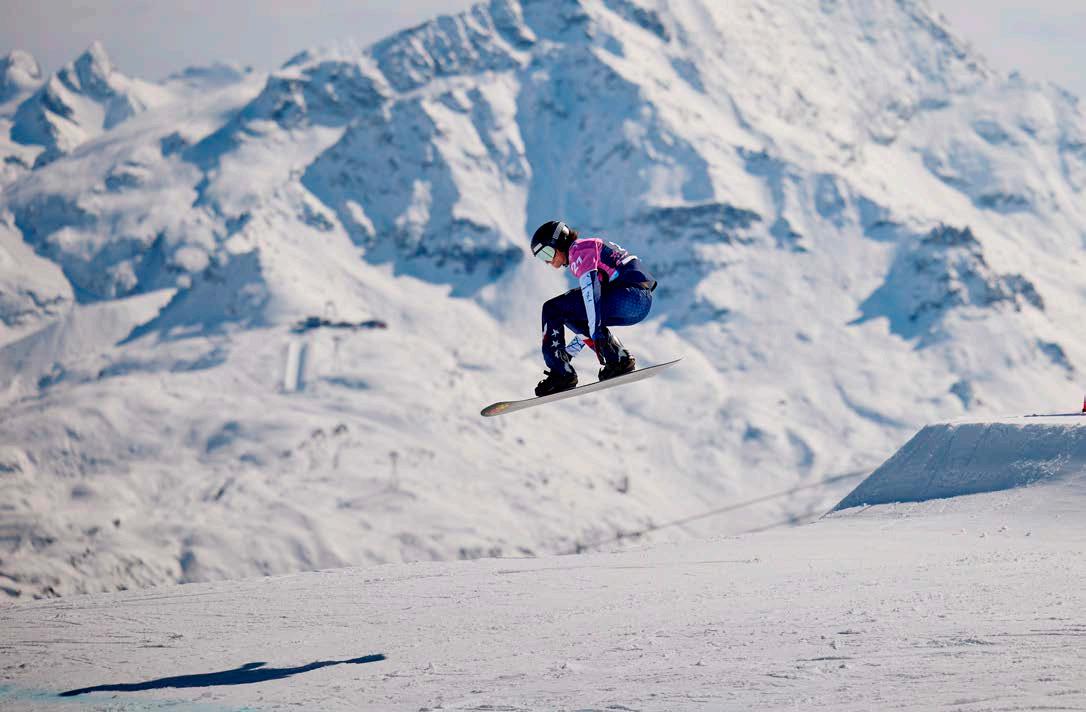
Steamboat Olympian Cody Winters is aiming for an encore appearance at the ‘26 Games in Cortina, Italy.
STAY INFORMED, CONNECTED AND ENTERTAINED WITH SKI TOWN MEDIA’S MULTI-CHANNEL CONTENT
Want to see if snowboarder Maddy Schaffrick can stage a comeback? Or know Olivia Giaccio’s best tip for fighting jet lag? Or listen to a curated playlist of pump up songs? We’ve got it all. Follow along with the Steamboat Olympians and all things Olympics at www.SteamboatMagazine.com and on our social media pages. Go Steamboat!
Want a dose of Steamboat fun in your feed? Follow @SteamboatMagazine on Instagram and Facebook for a steady stream of town happenings, seasonal guides, quirky mountain-life humor and a behind-the-scenes glimpse of Yampa Valley life. Whether you’re hunting for weekend plans or just want a reason to smile mid-scroll, we’ve got content to keep you in the loop and in the mood for more.
Looking for a Steamboat guide that’s as hilarious as it is helpful? “Swillin’ & Chillin’” has your back. This cheeky mag dishes out the best recommendations for bites, bevvies, blunts and bars
in town – perfect for visitors and locals alike. Published twice a year – once in summer, once in winter – this is your go-to seasonal compass for having a seriously good time in the ’Boat. Whether you’re planning your après-ski lineup or seeking sunsoaked patios, “Swillin’ & Chillin’” will have you laughing all the way to your next adventure.
Art lovers, take note. The “Yampa Valley Arts & Culture Guide” is your year-round passport to the creative heart of Routt County. Check out stories like “A World of Color,” which highlights the magic of color blind glasses – giving those with red-green colorblindness the chance to experience true color at Steamboat Art Museum. From local artist spotlights to can’t-miss cultural events, this curated guide celebrates the people and projects that shape the valley’s vibrant arts scene. Pick up a print copy, browse online at www.yampavalleyarts.com or follow @yampavalleyart on Instagram and Facebook to keep the inspiration flowing.

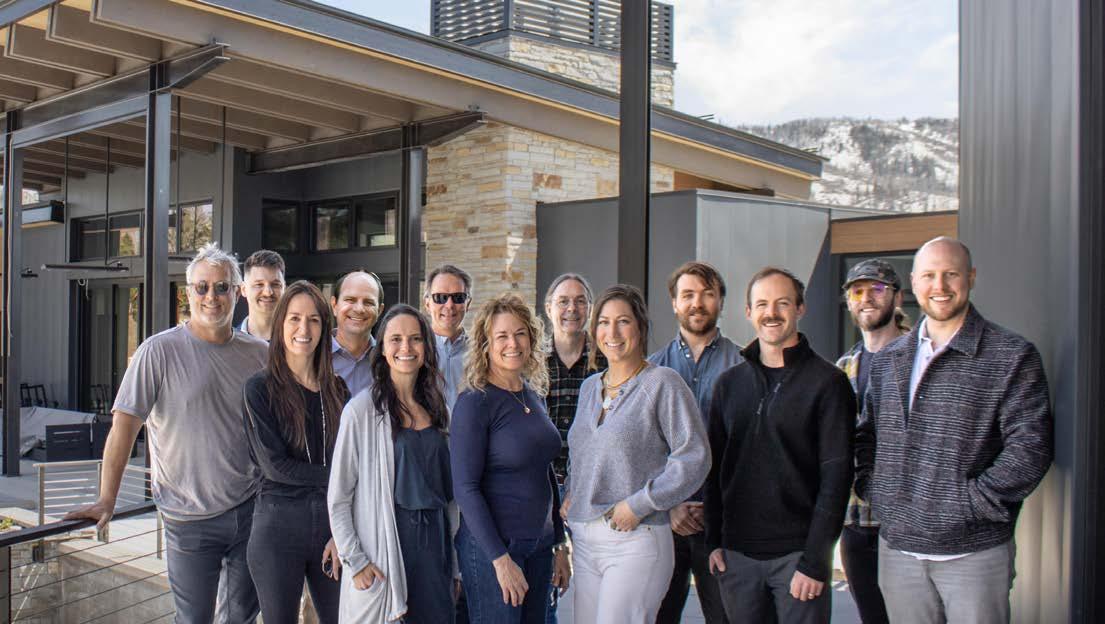
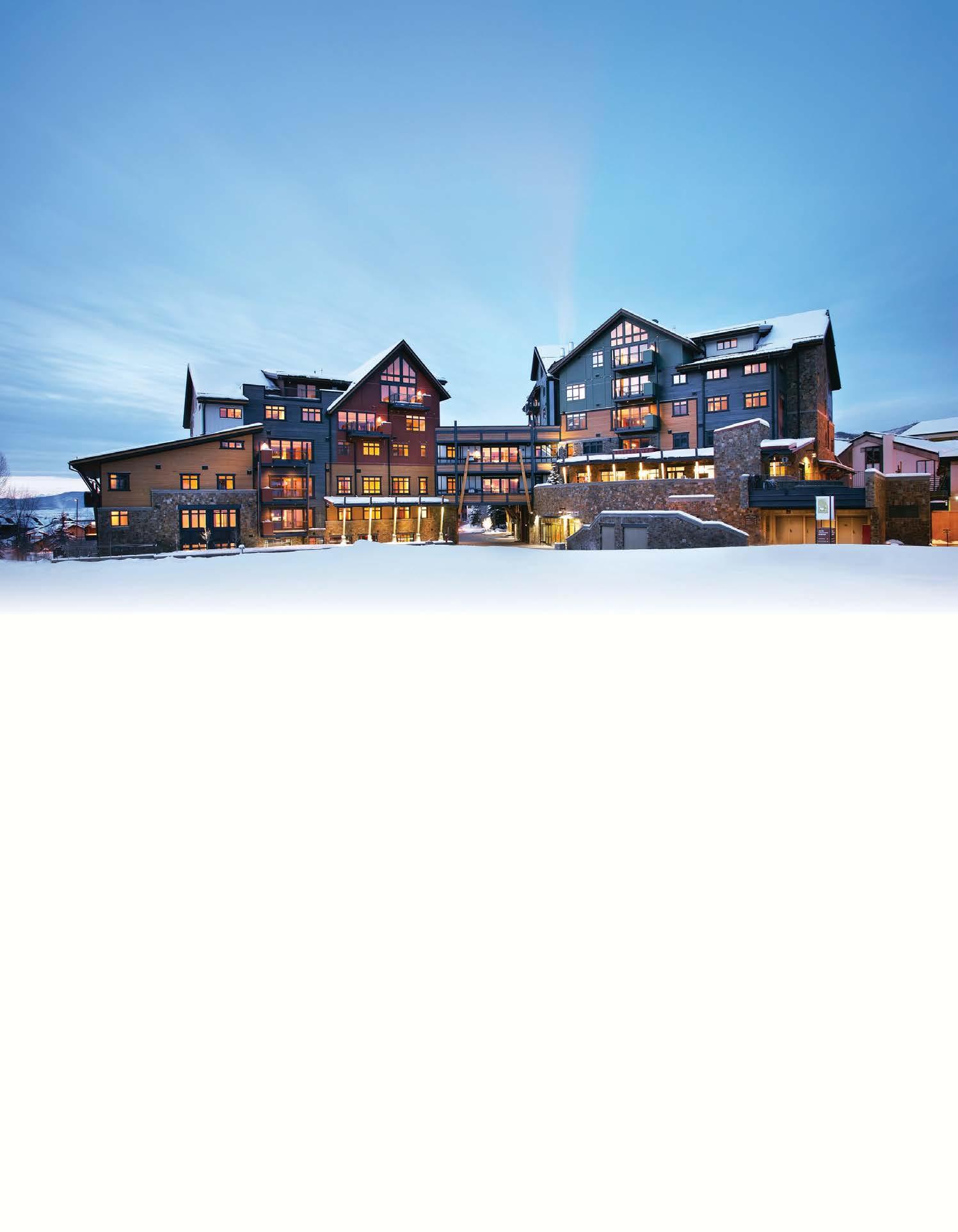






1/12th interests start at $365,000
1/8th interests start at $535,000
